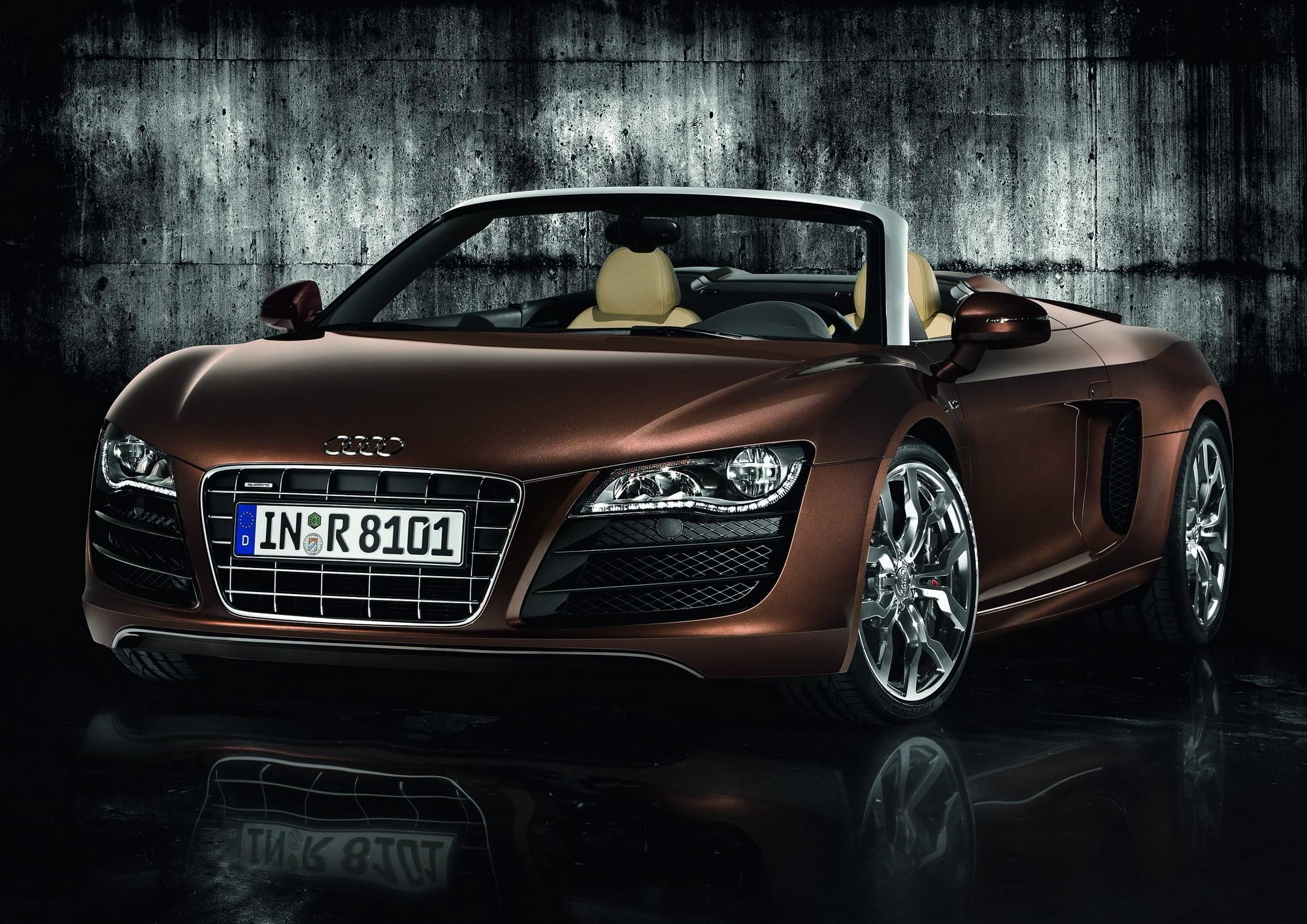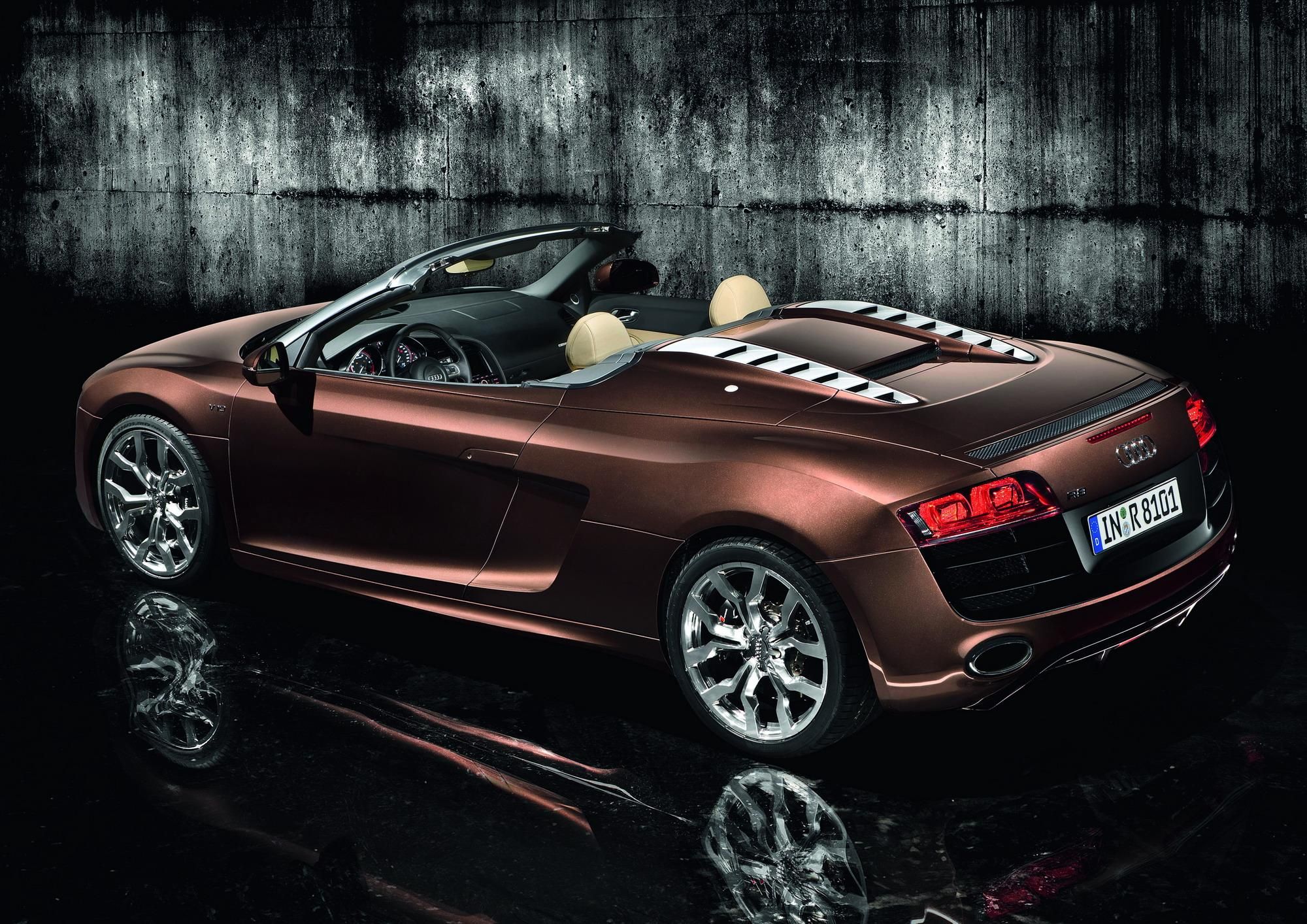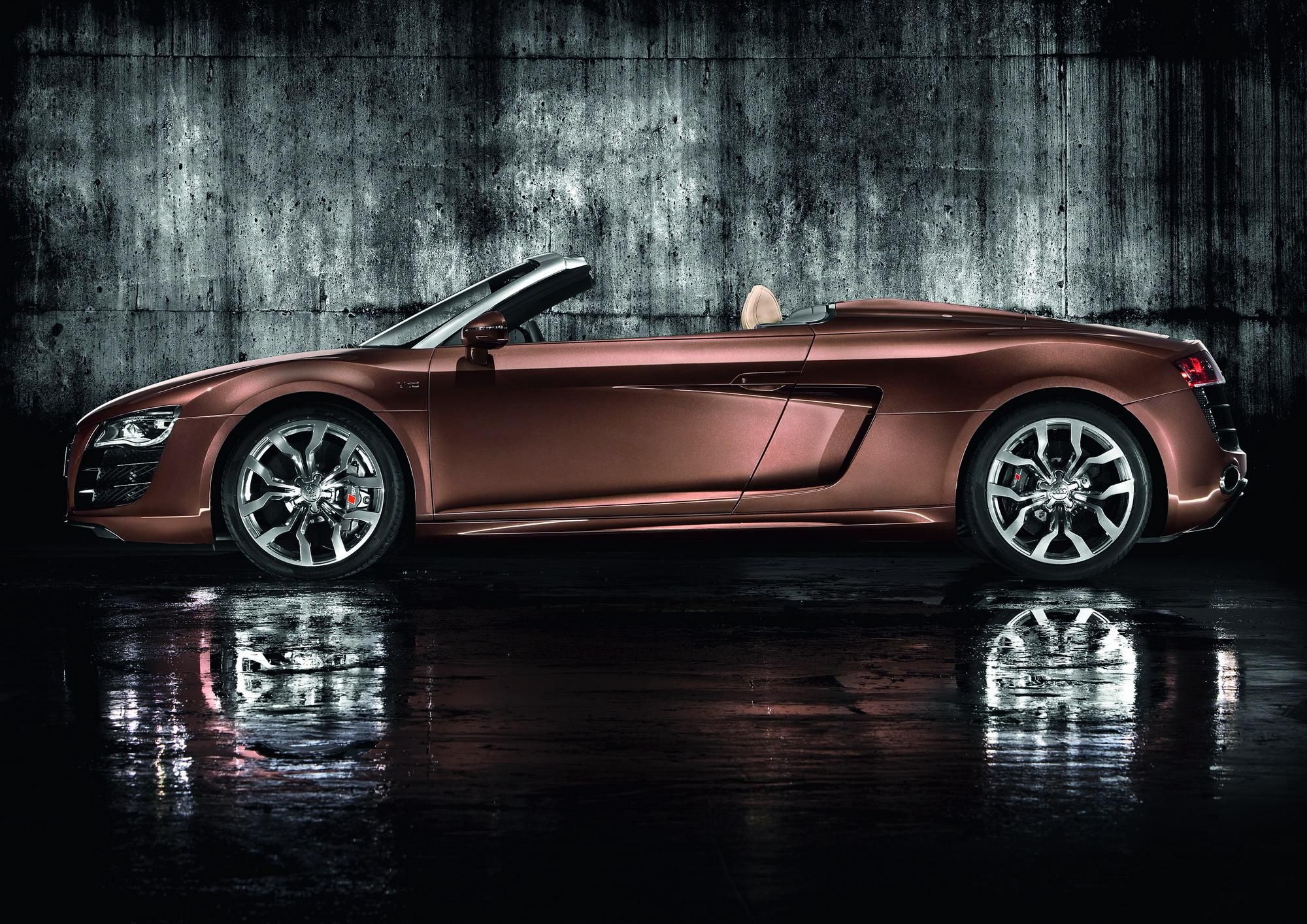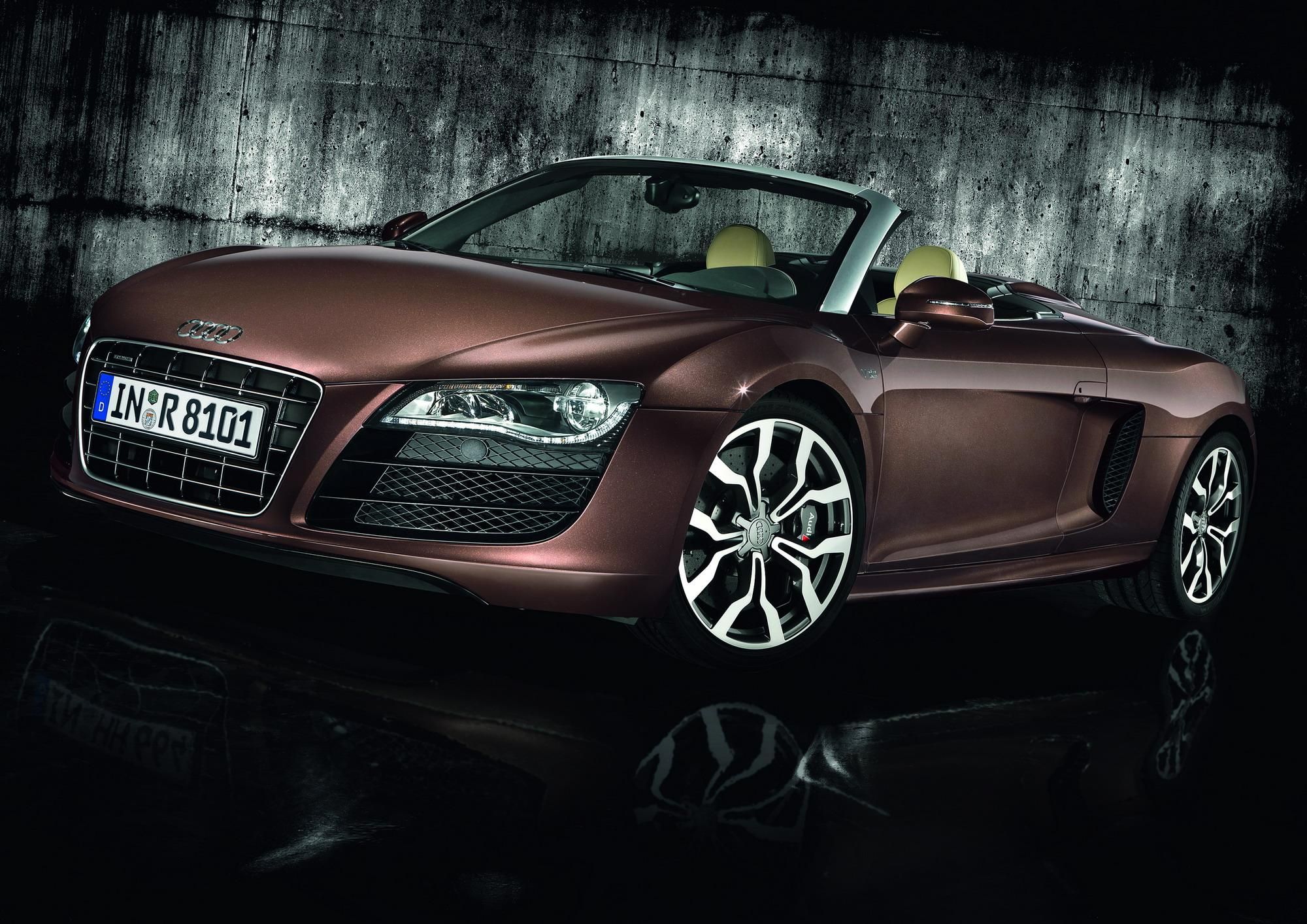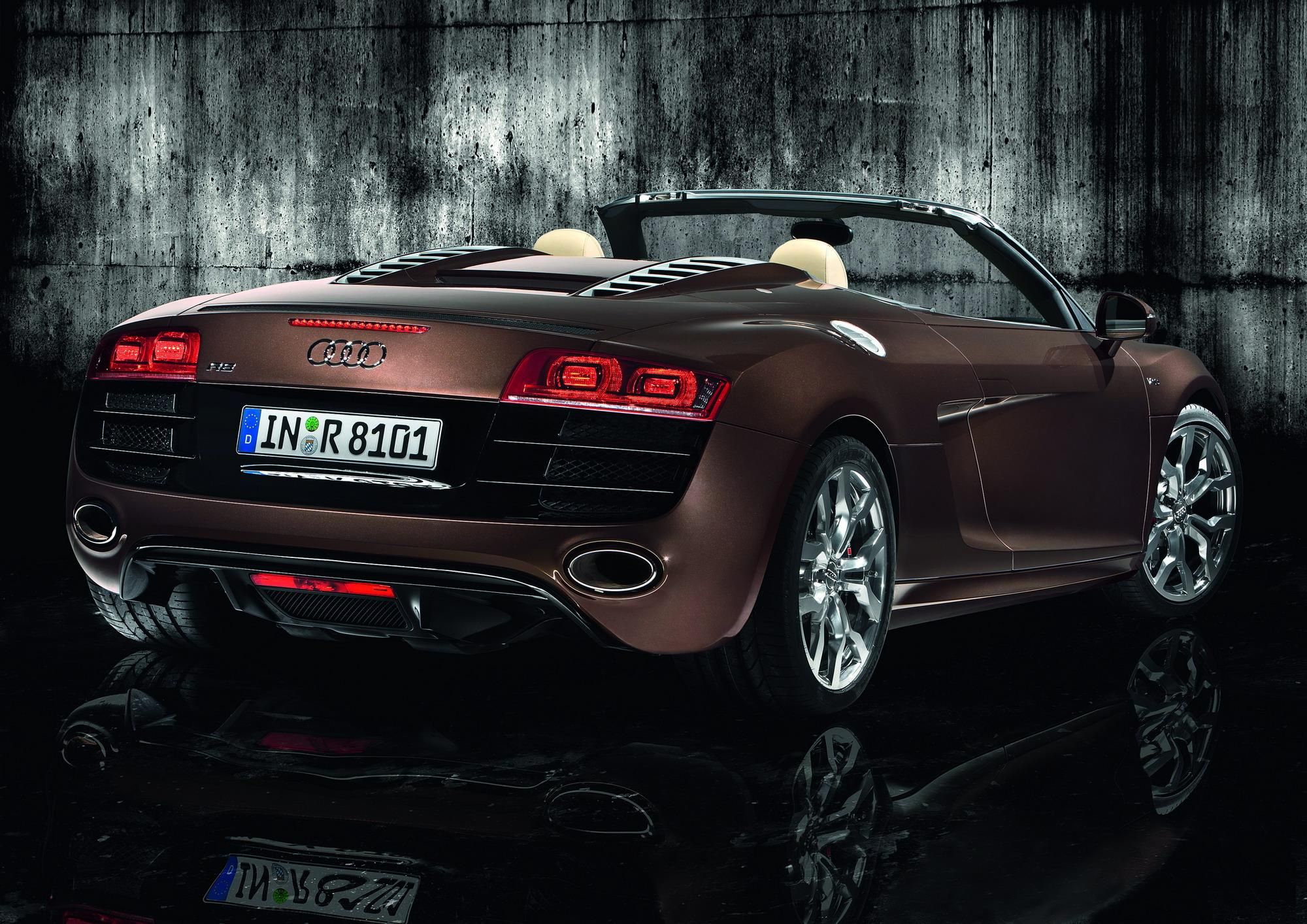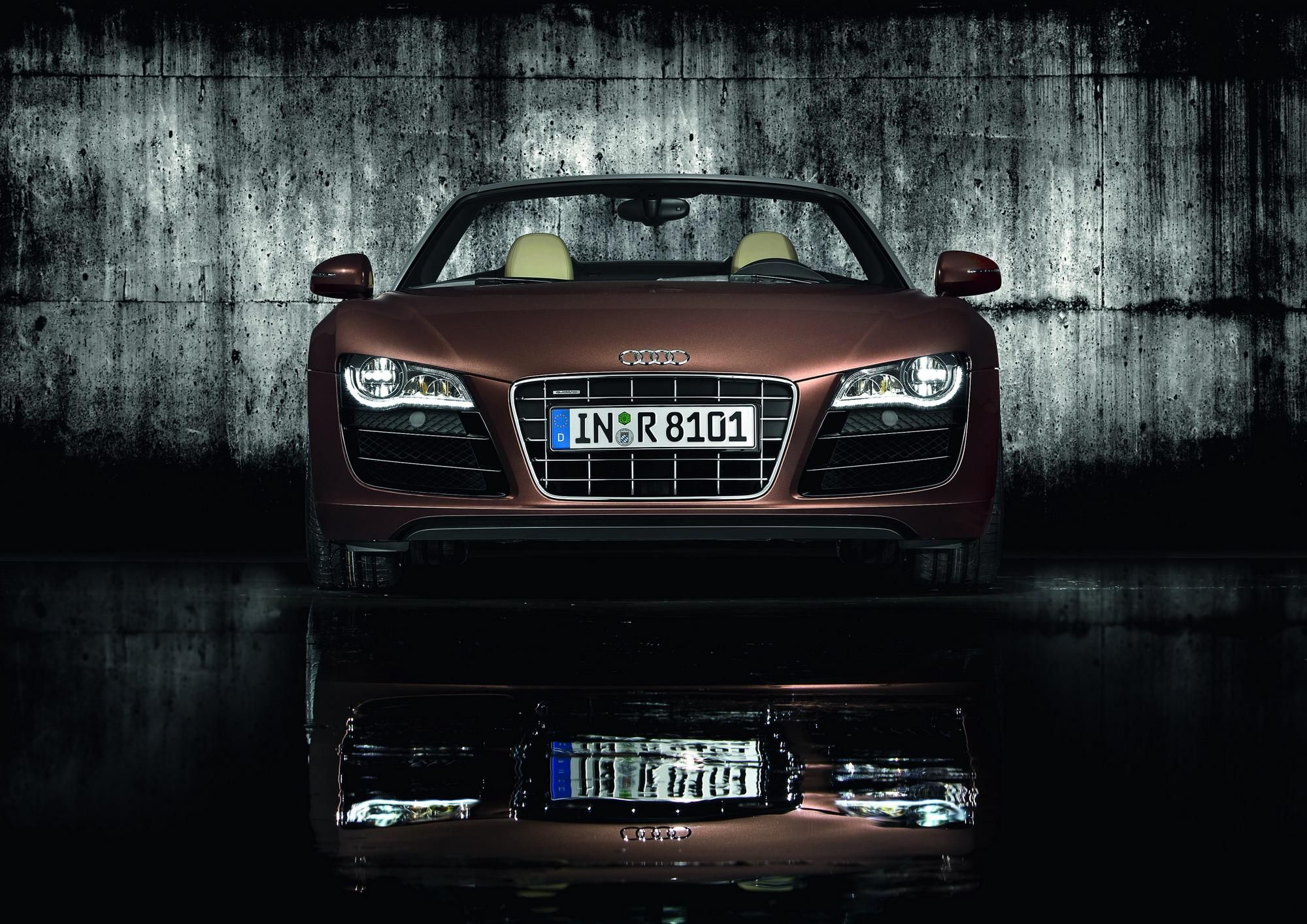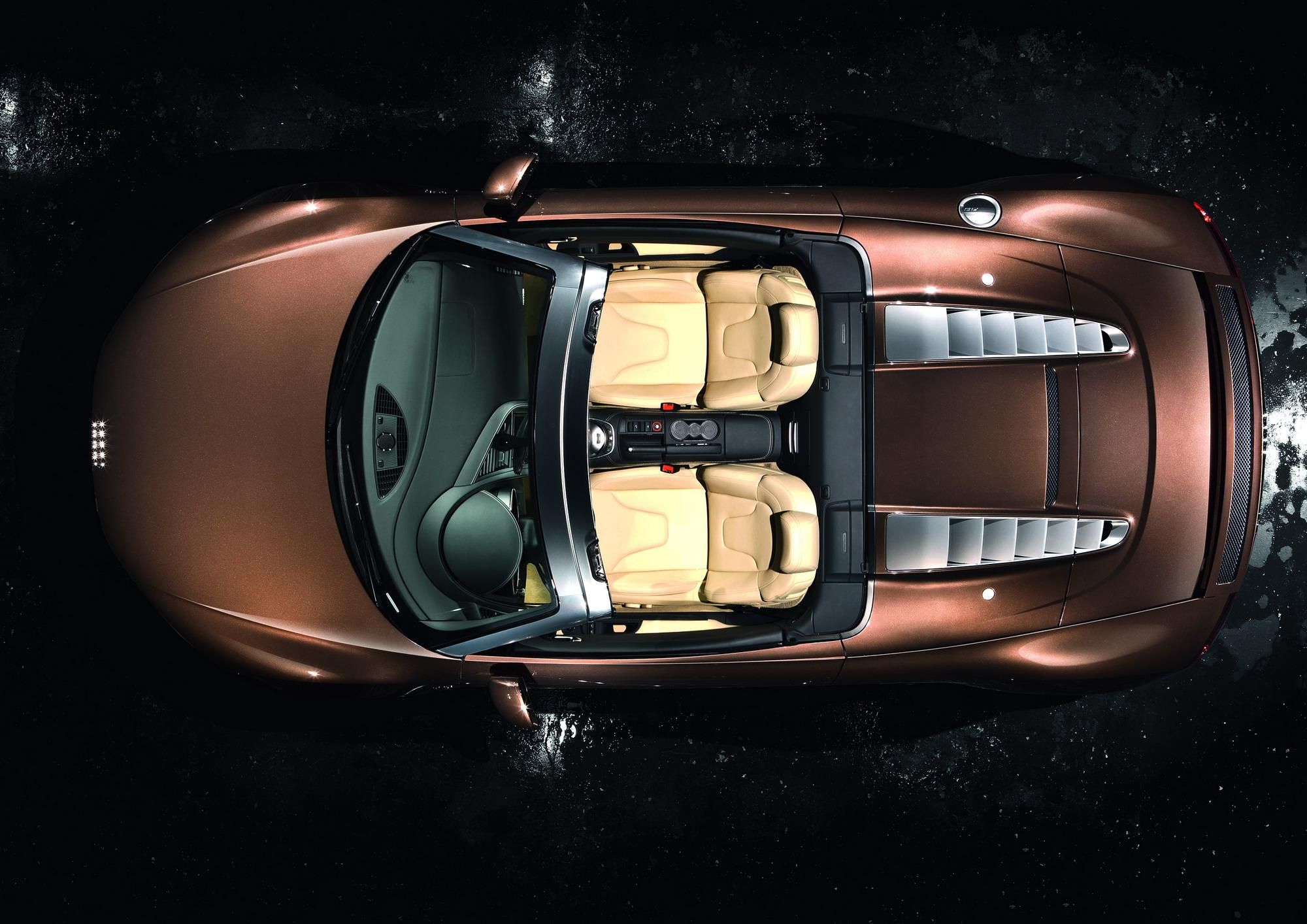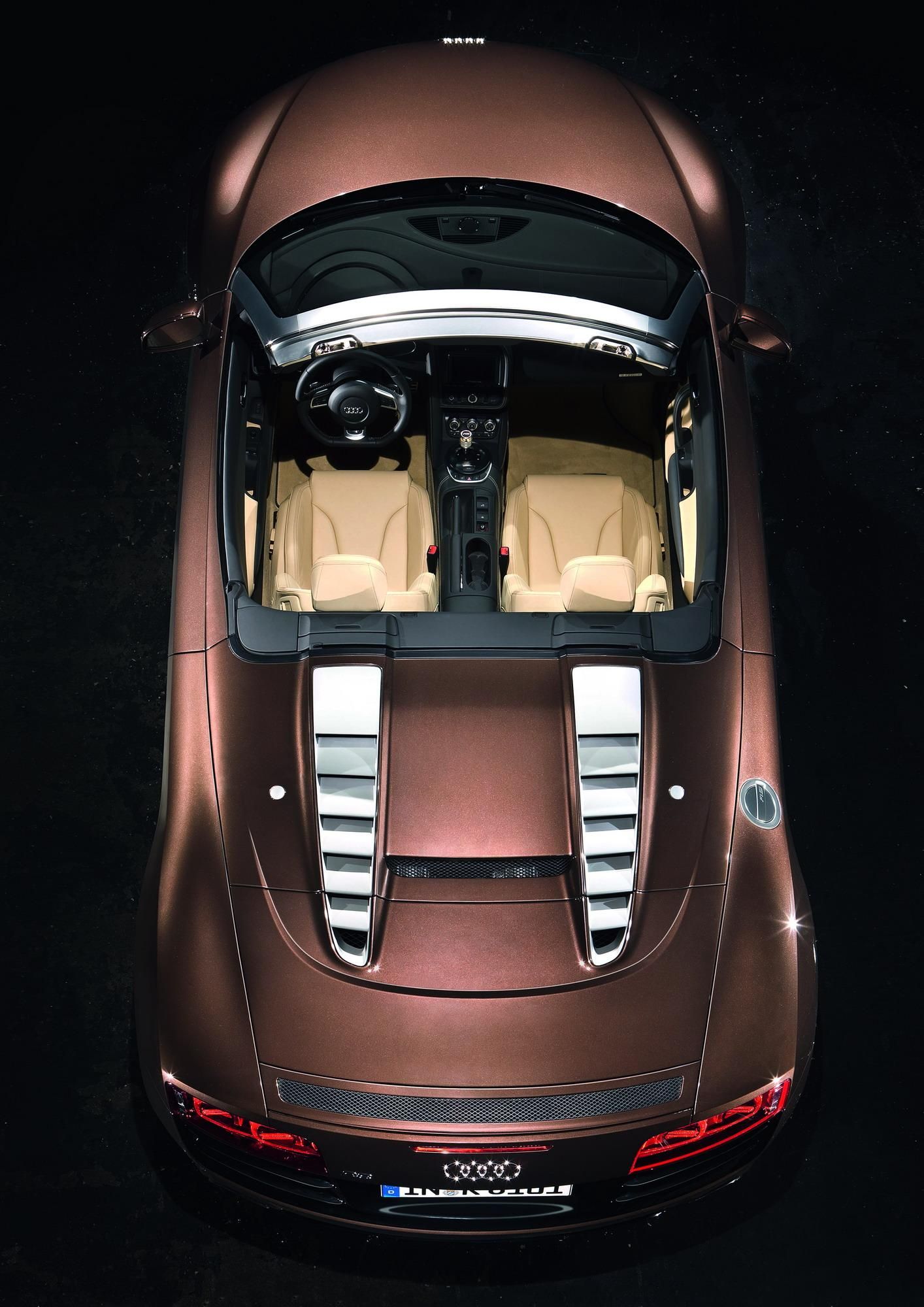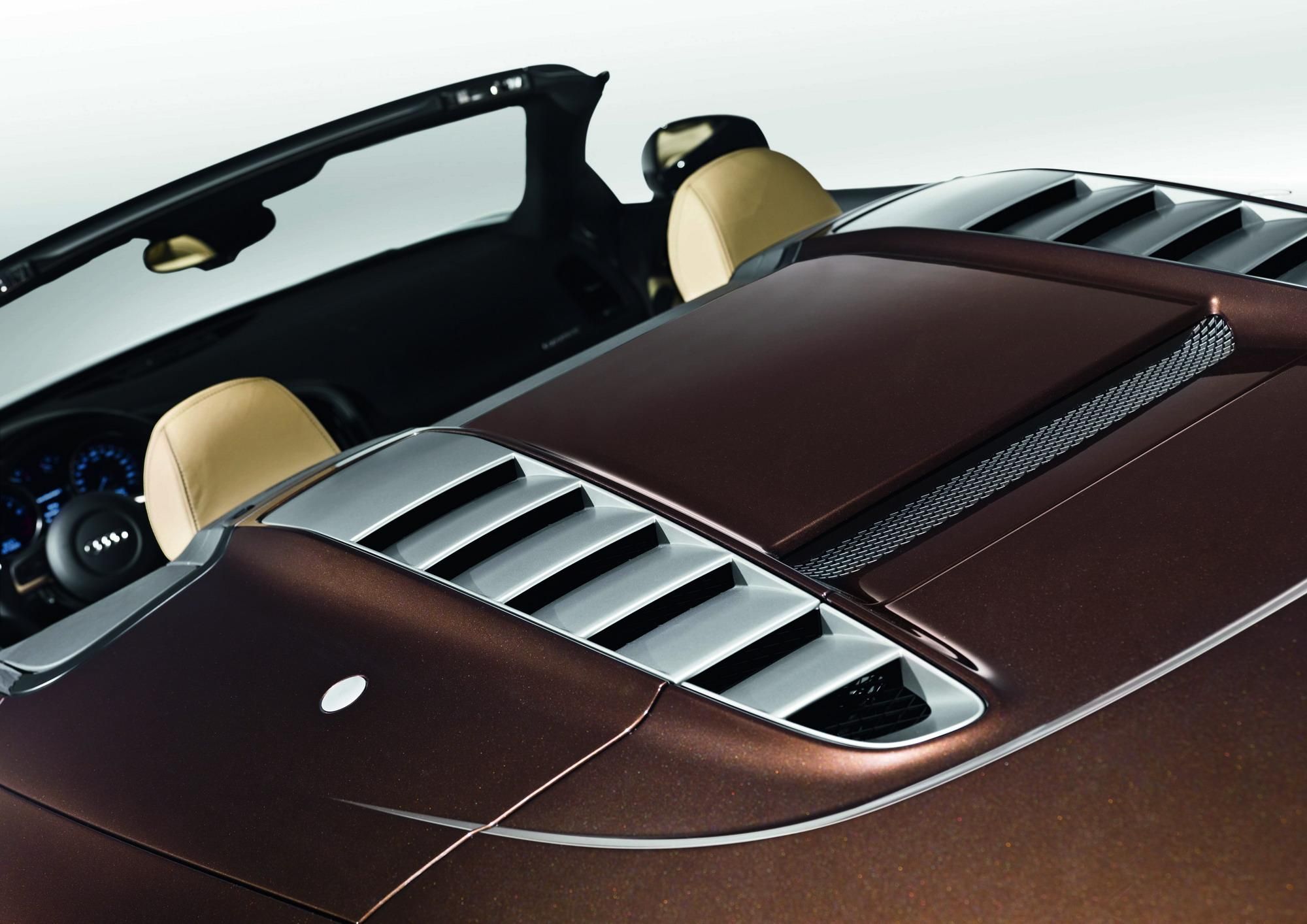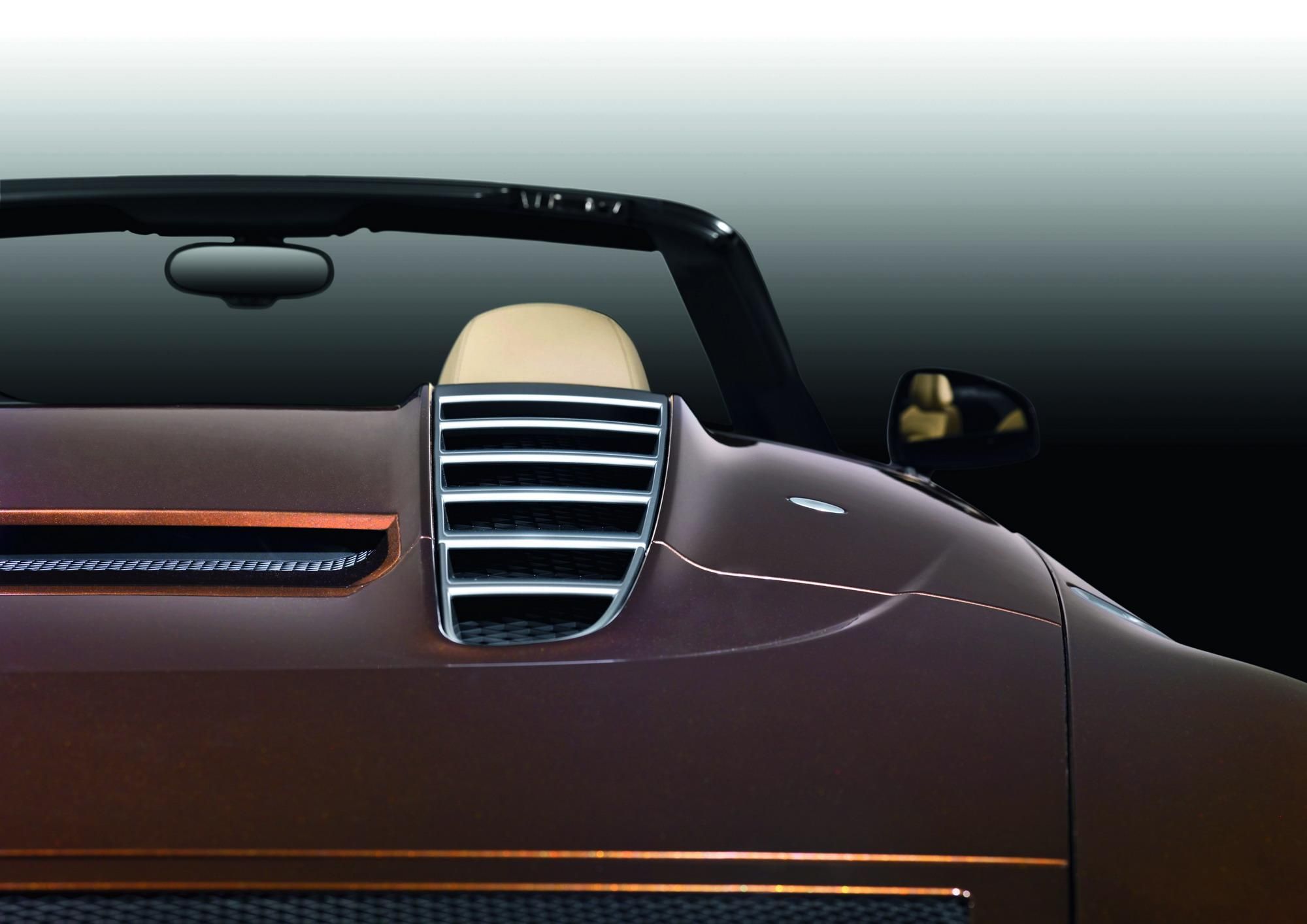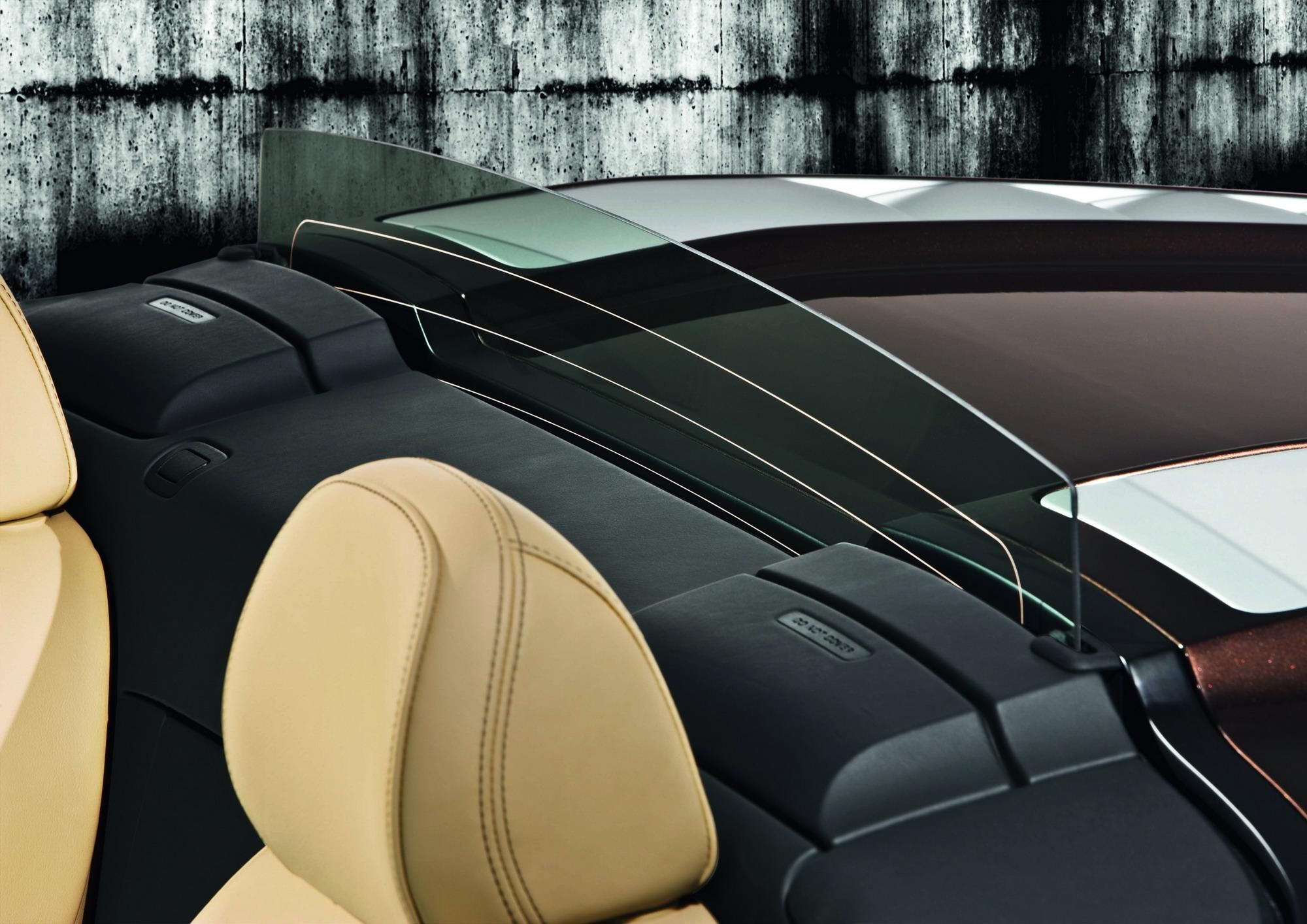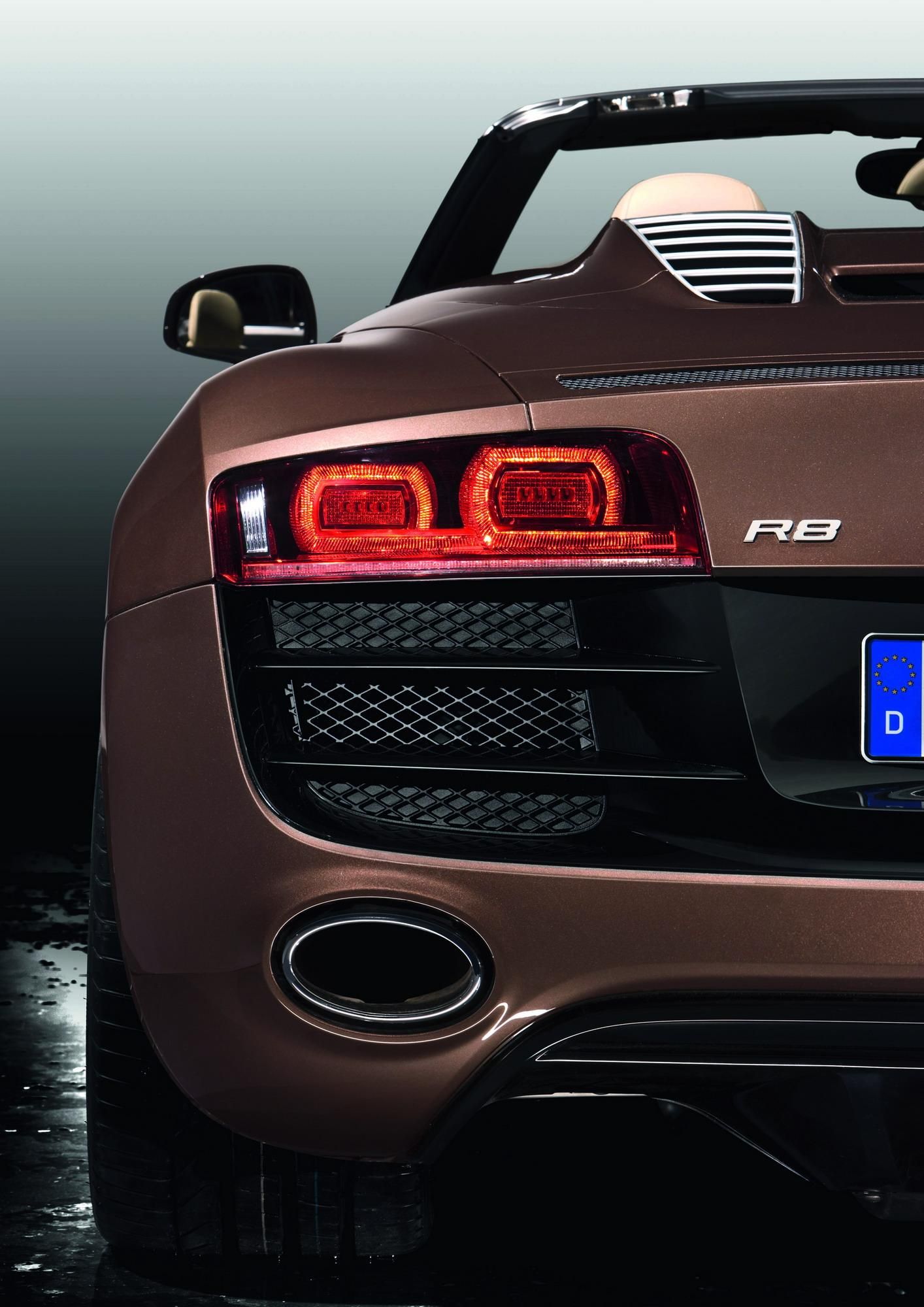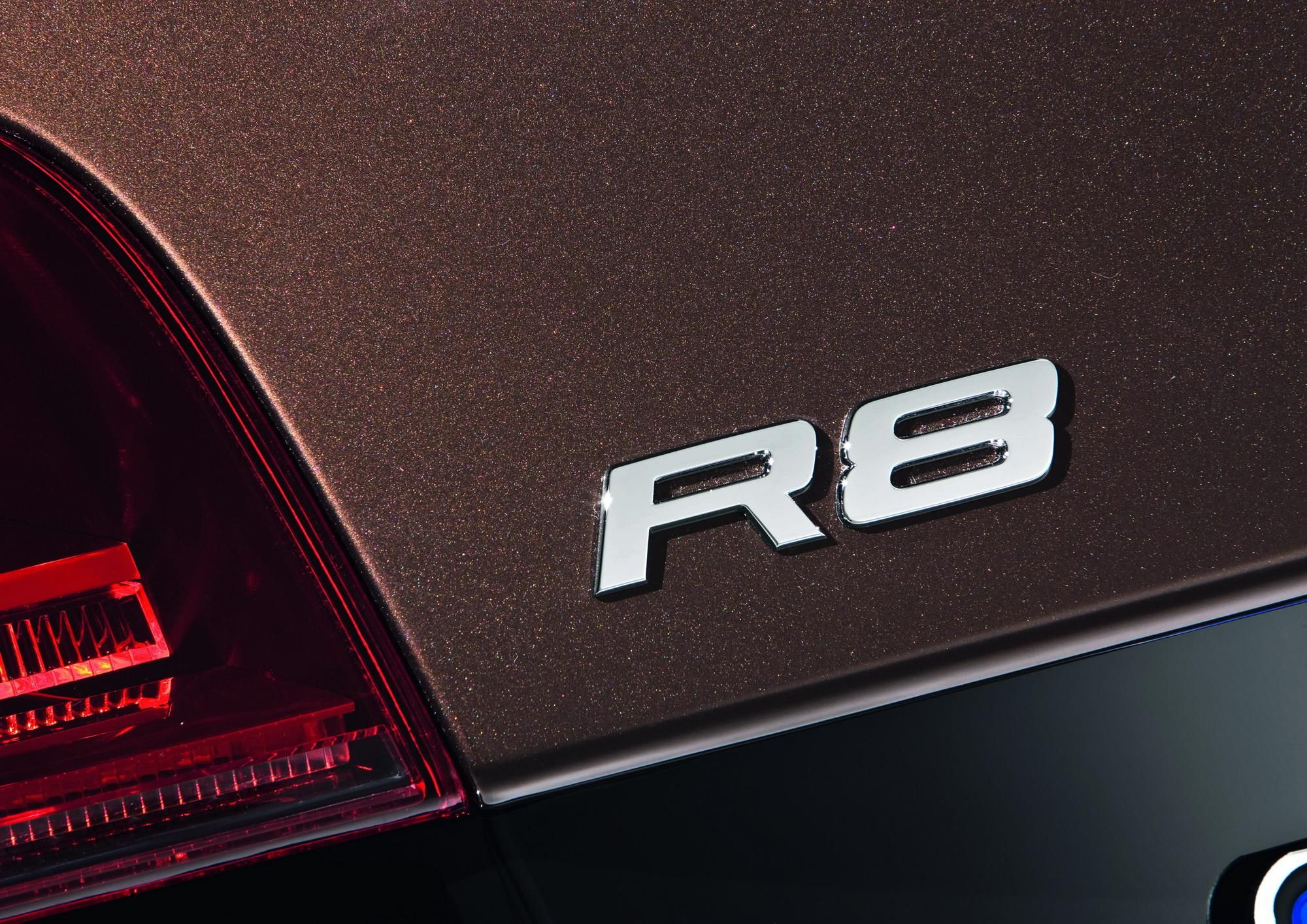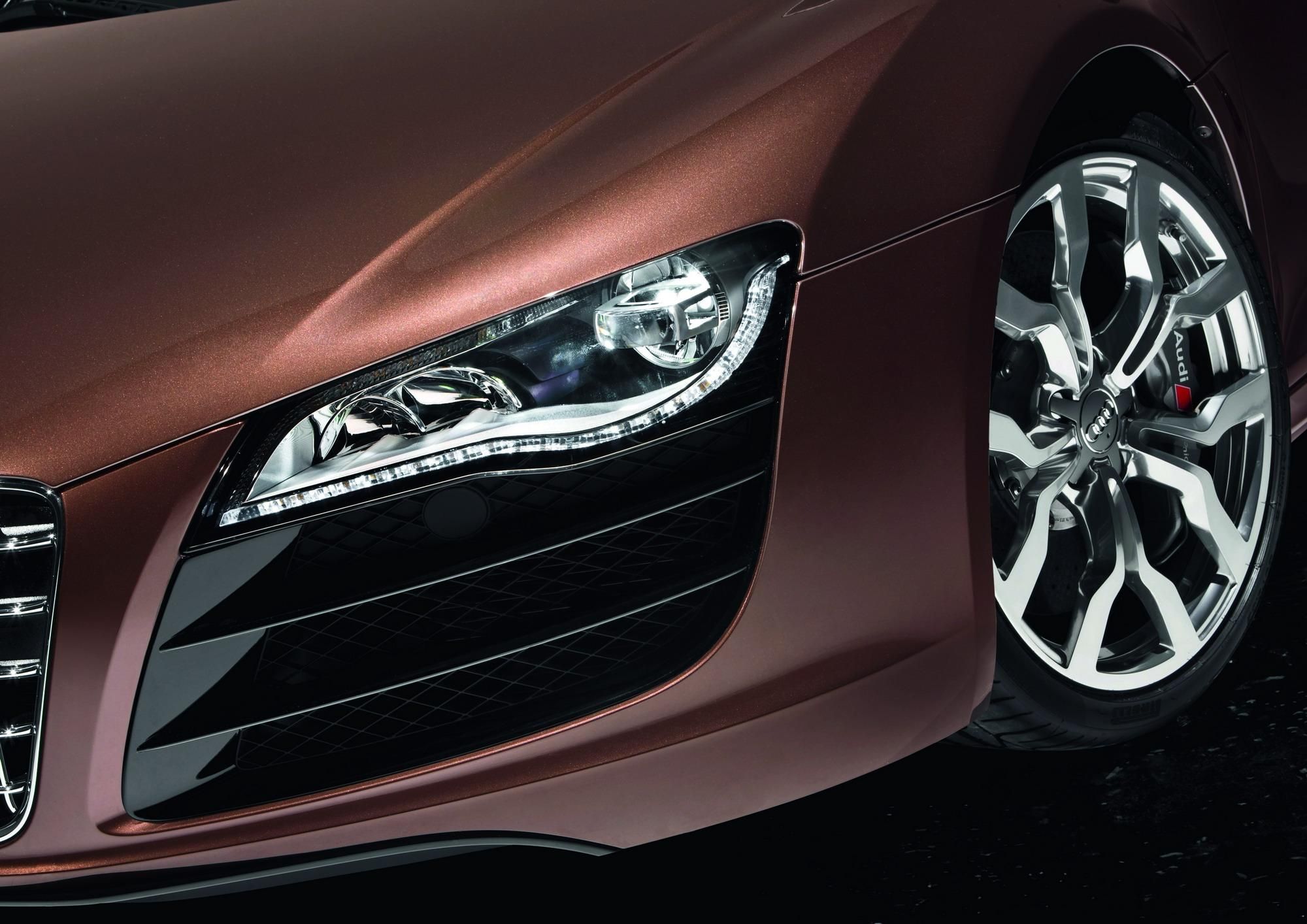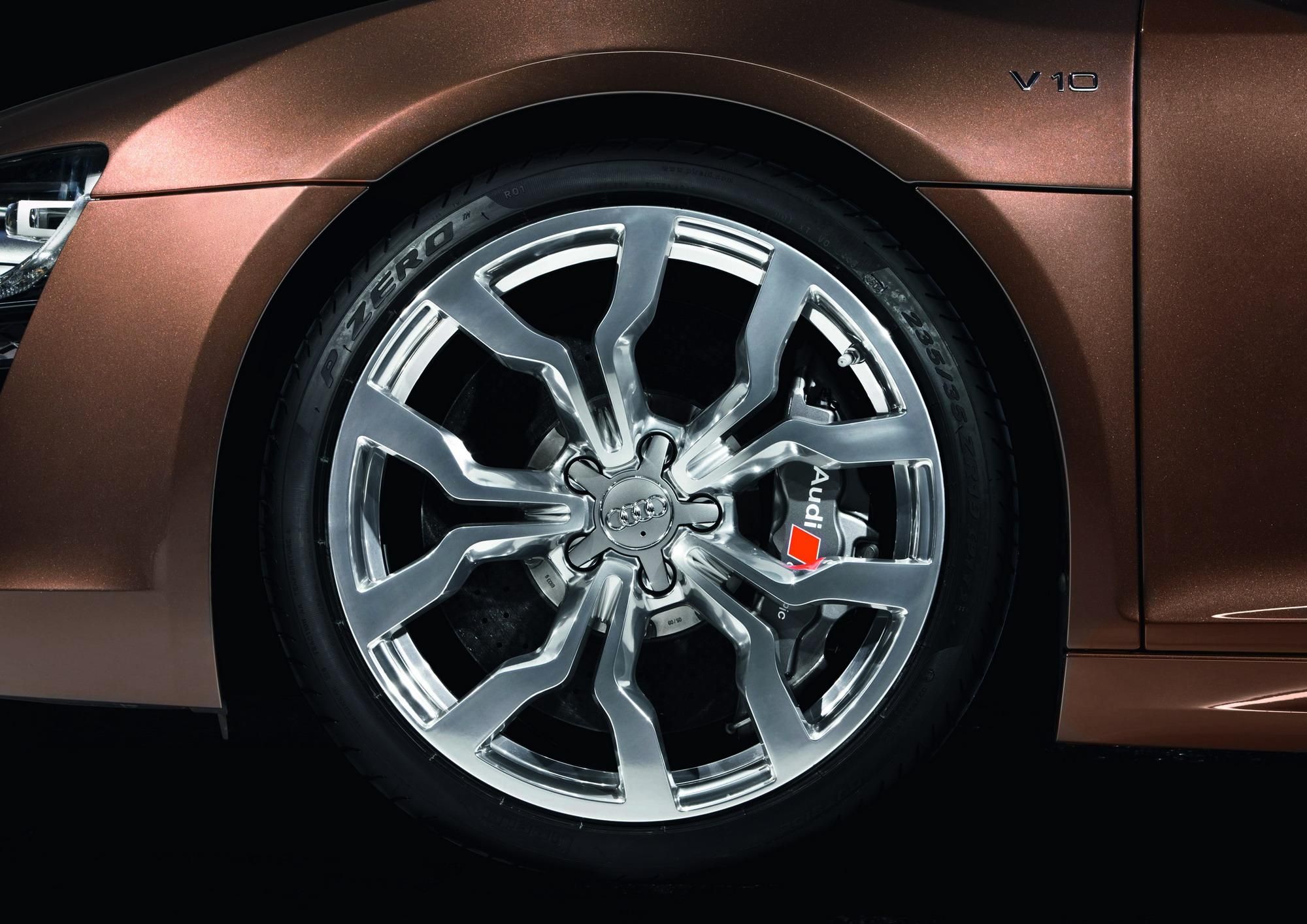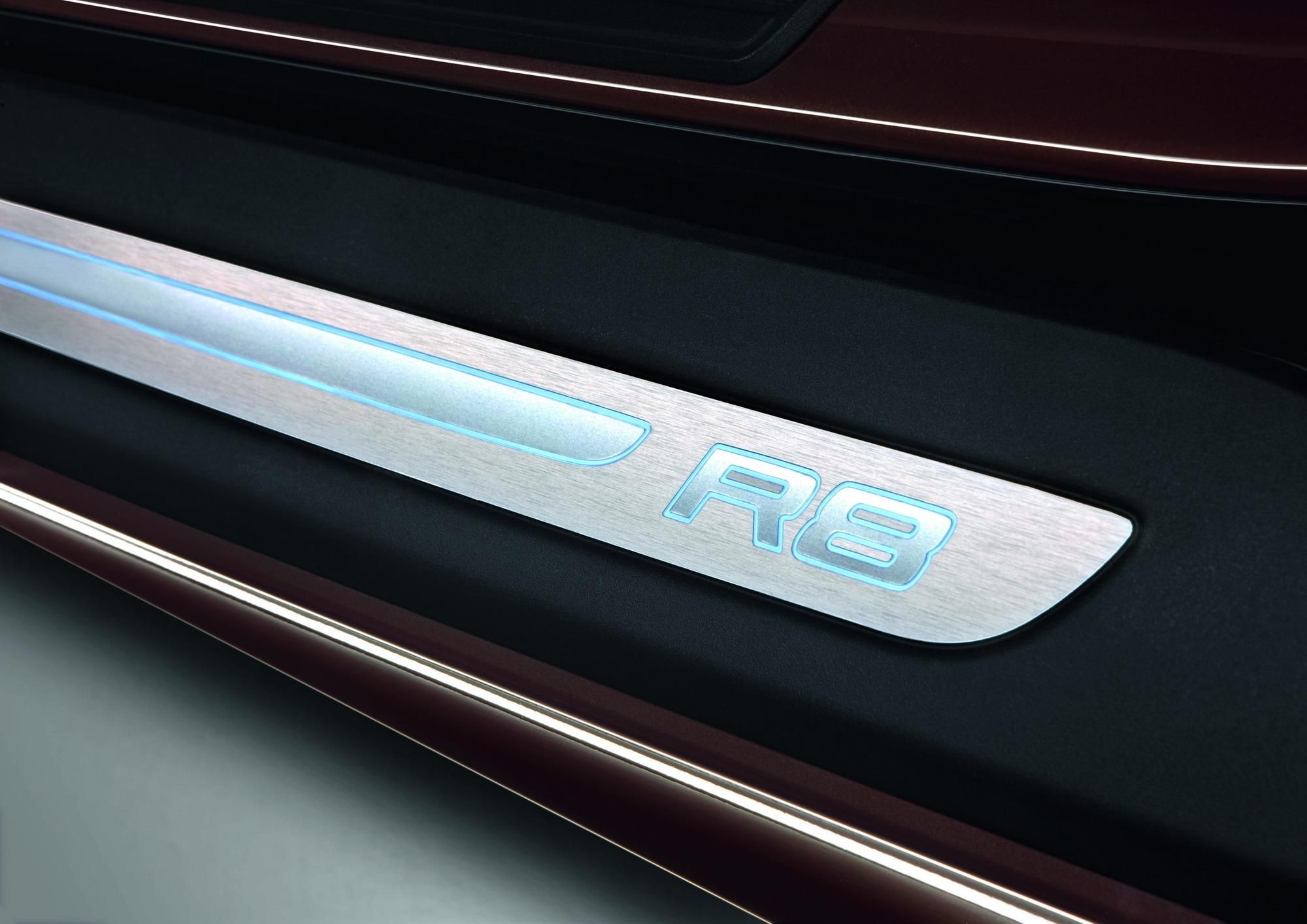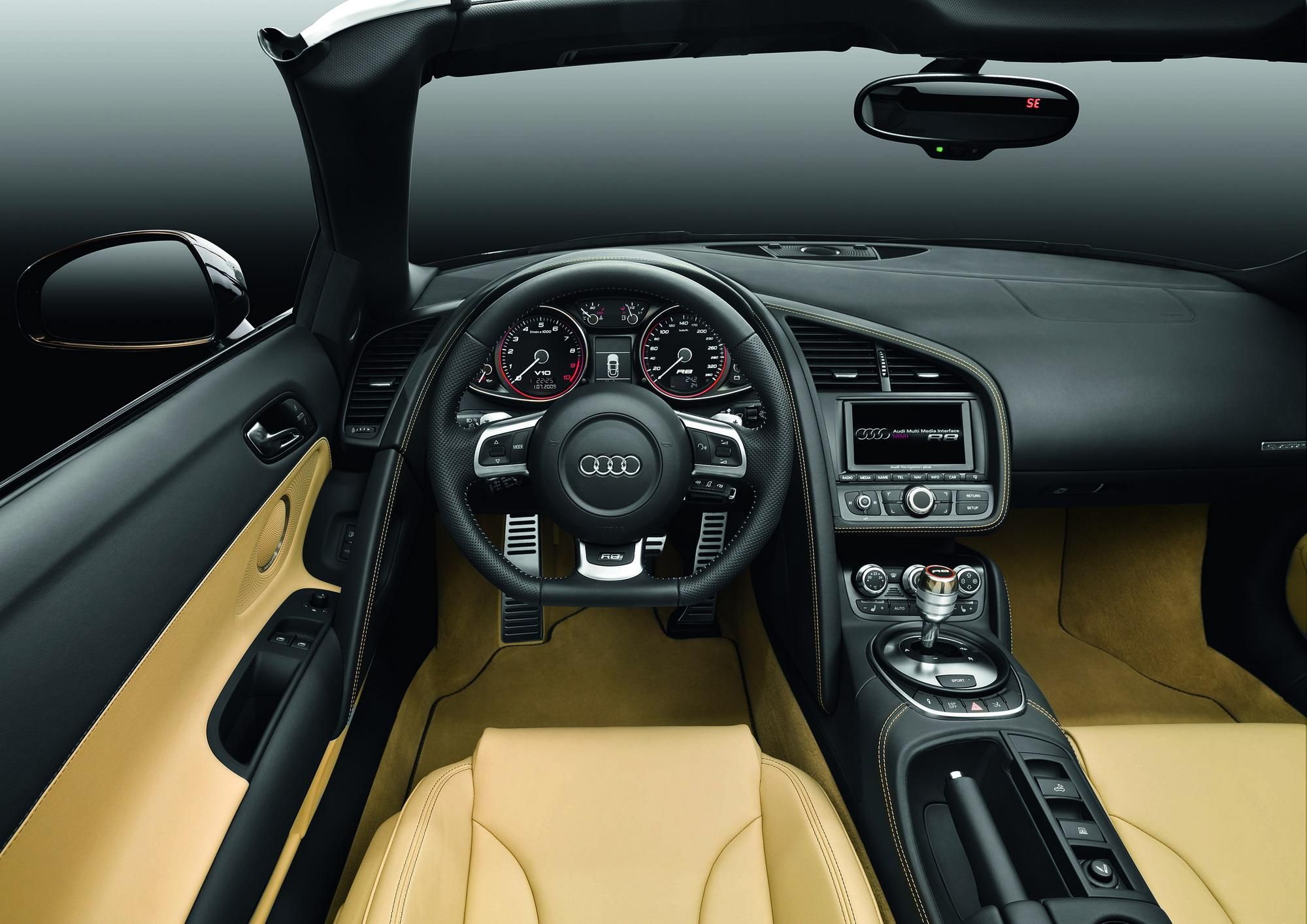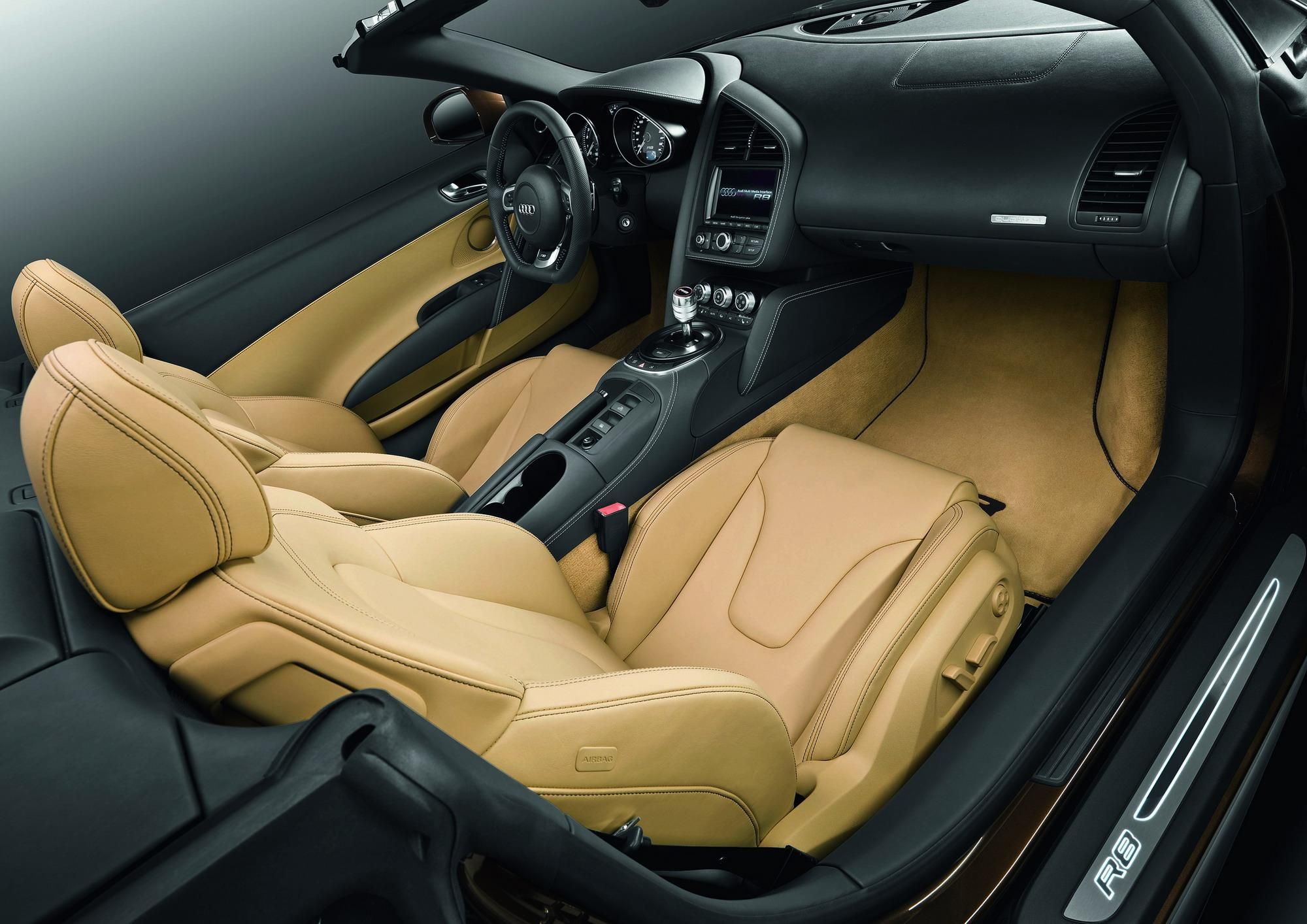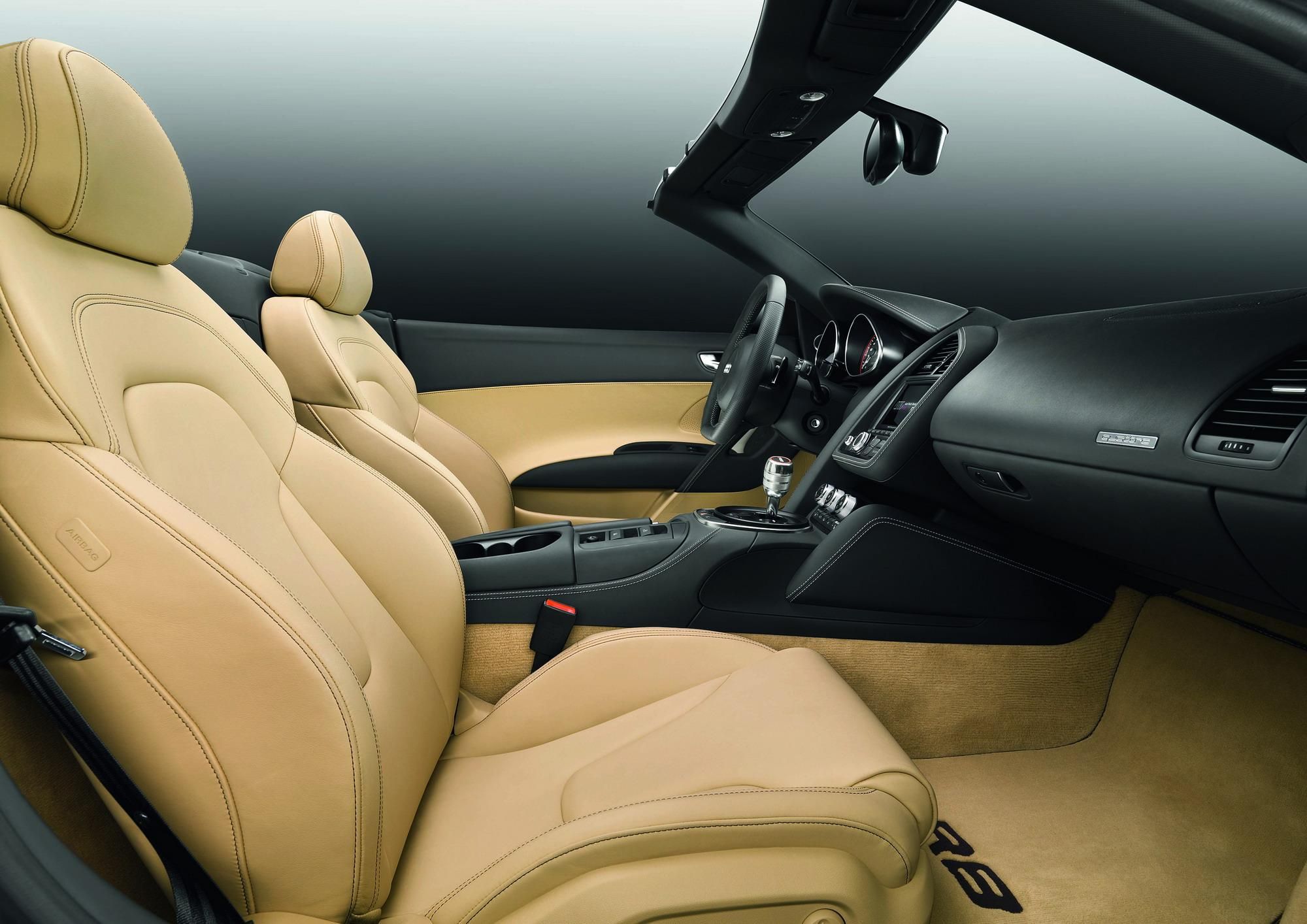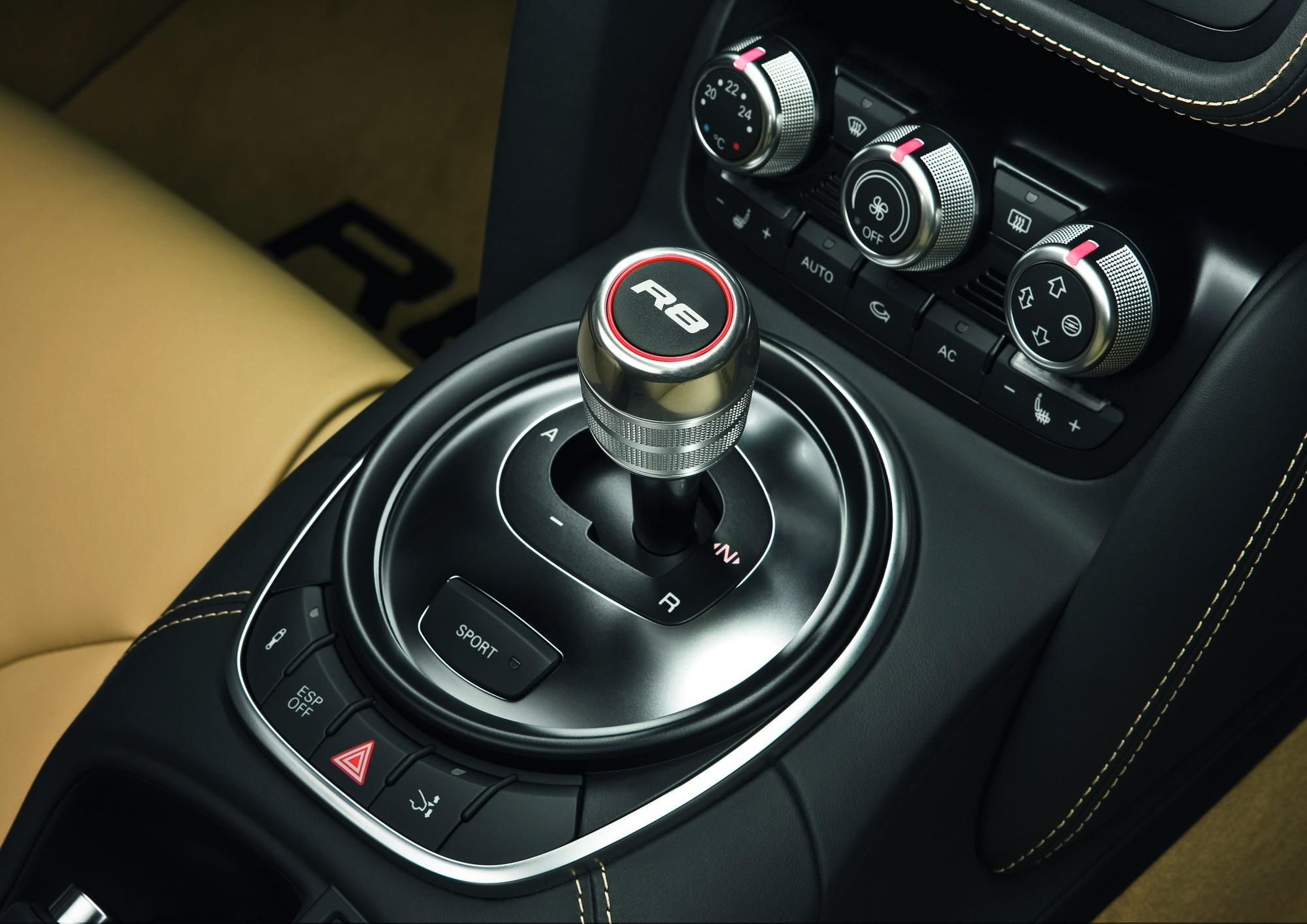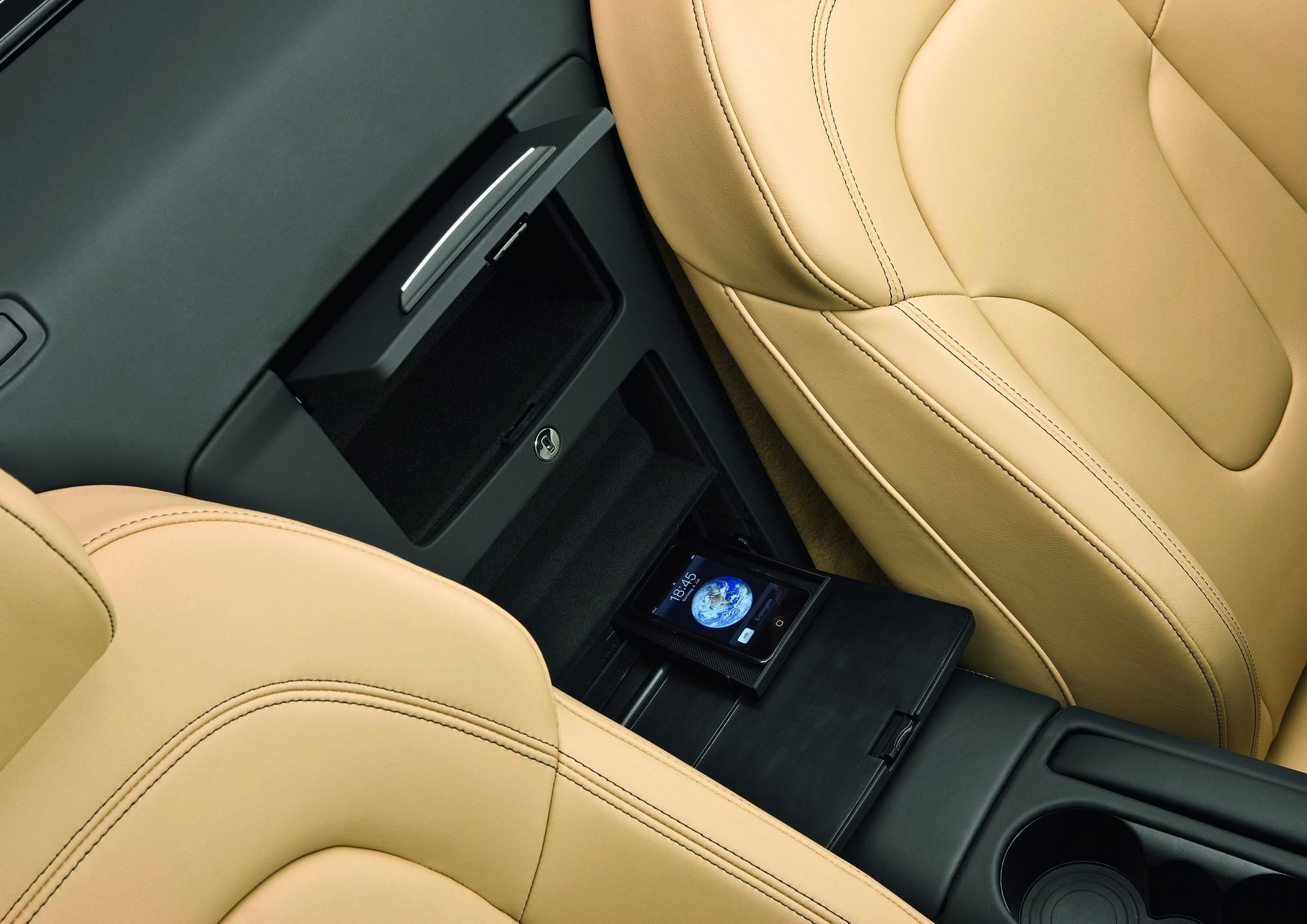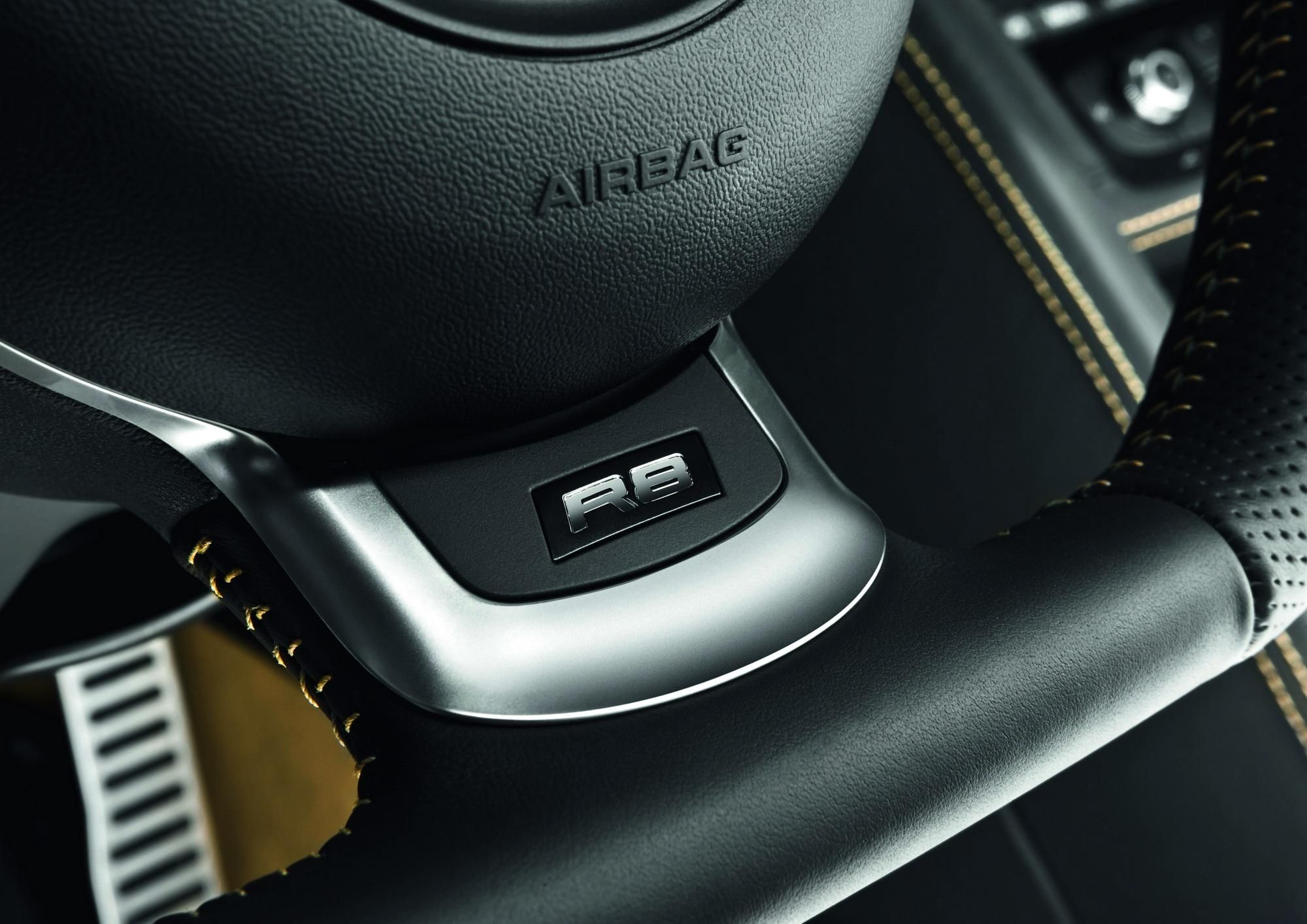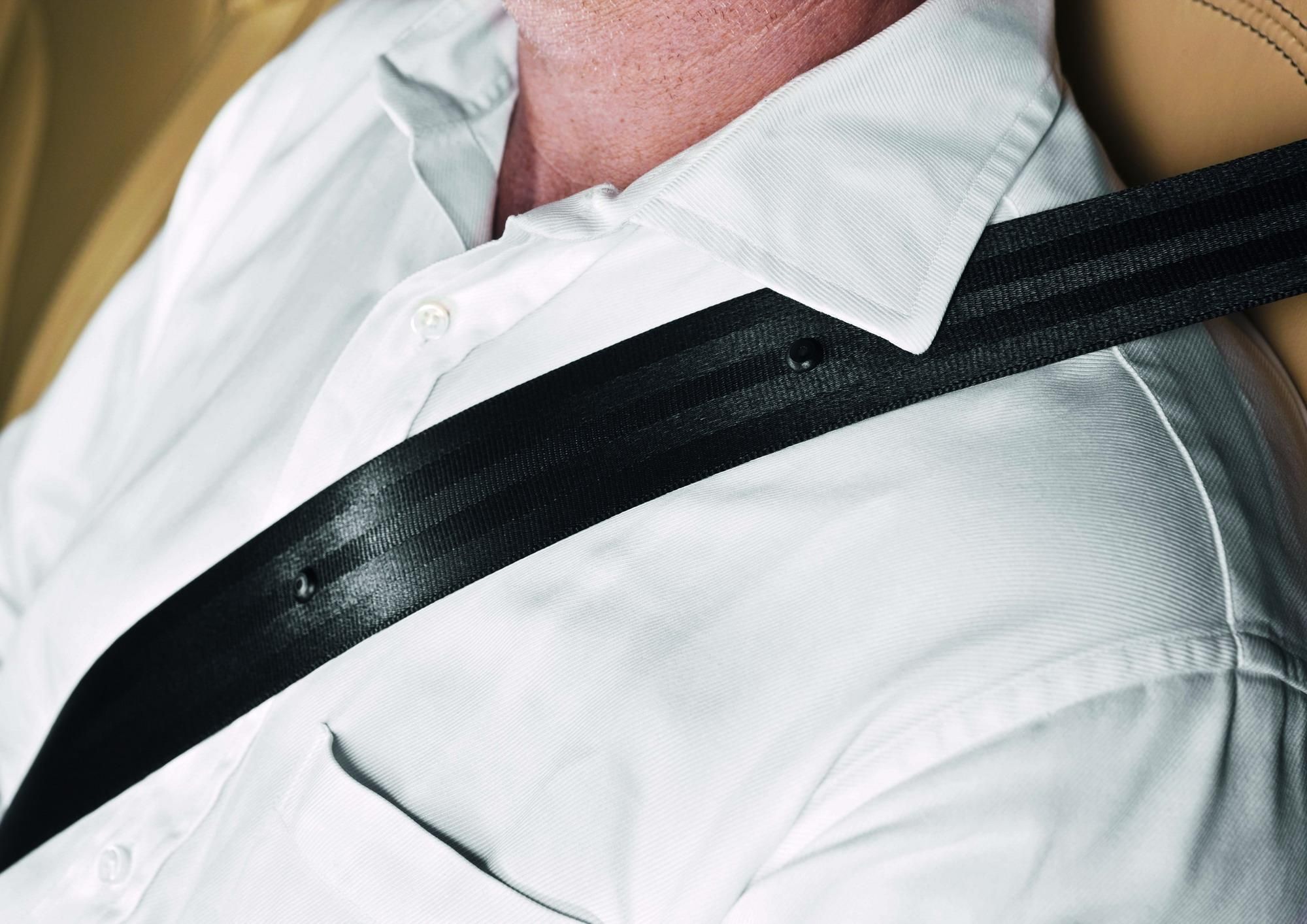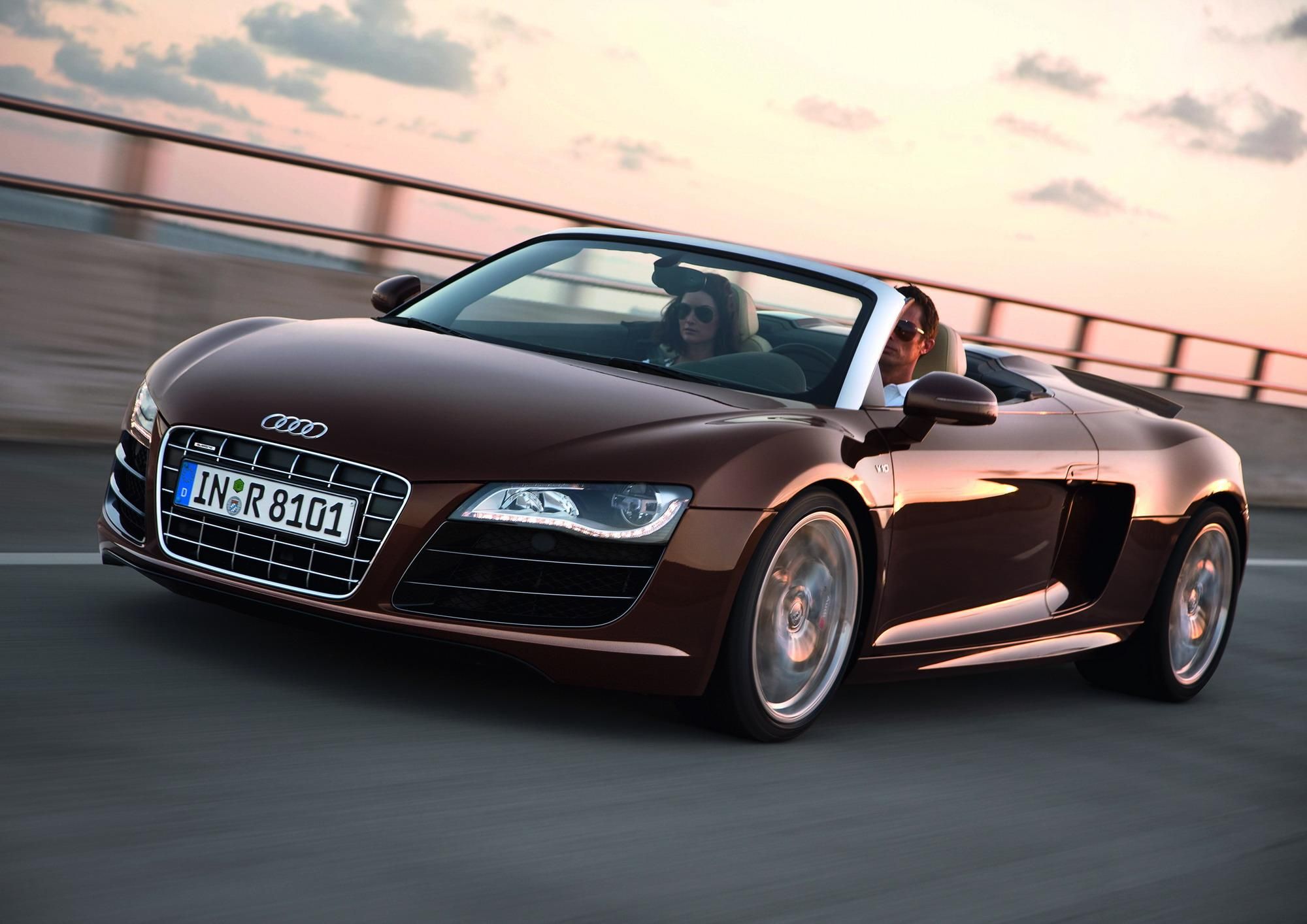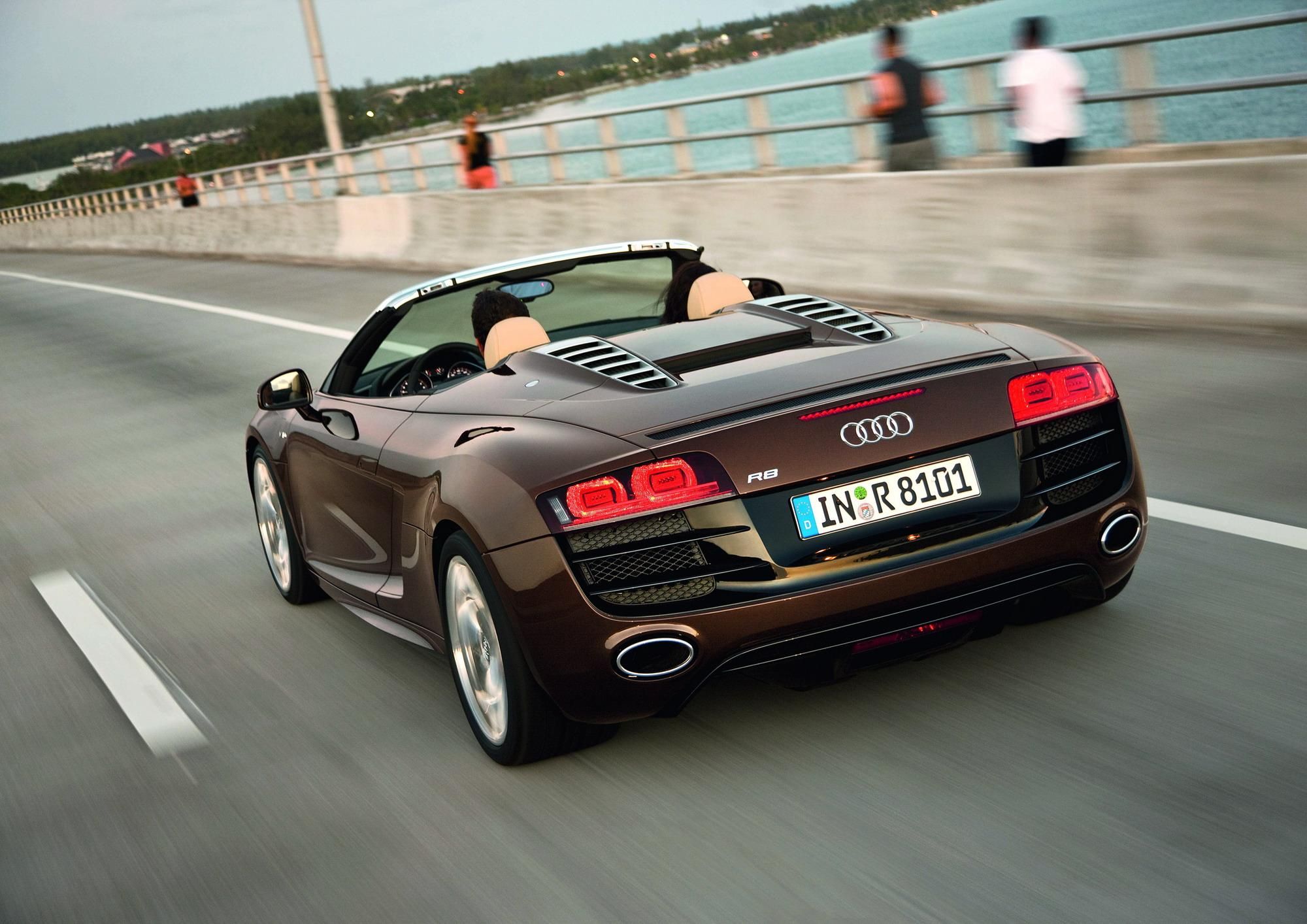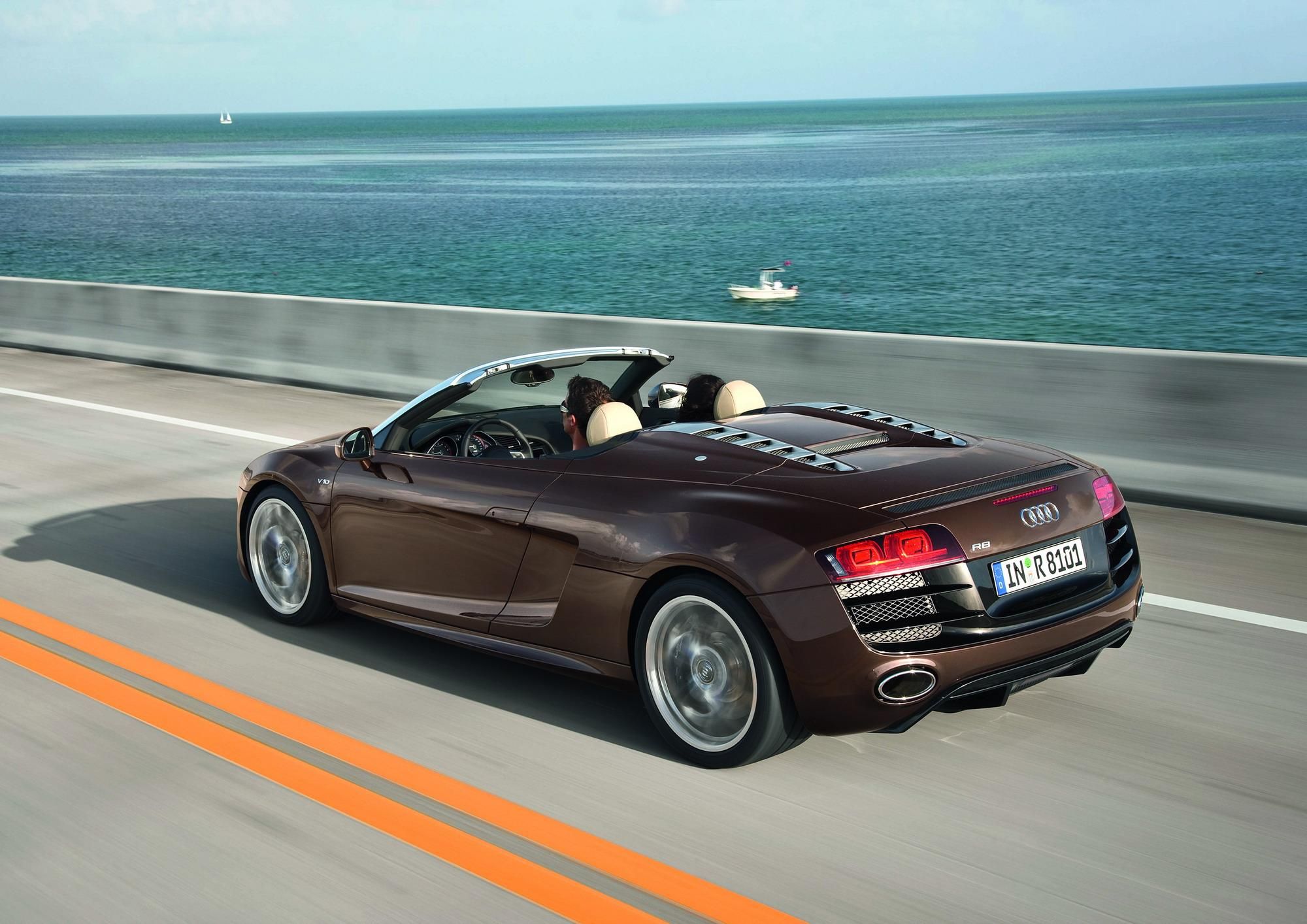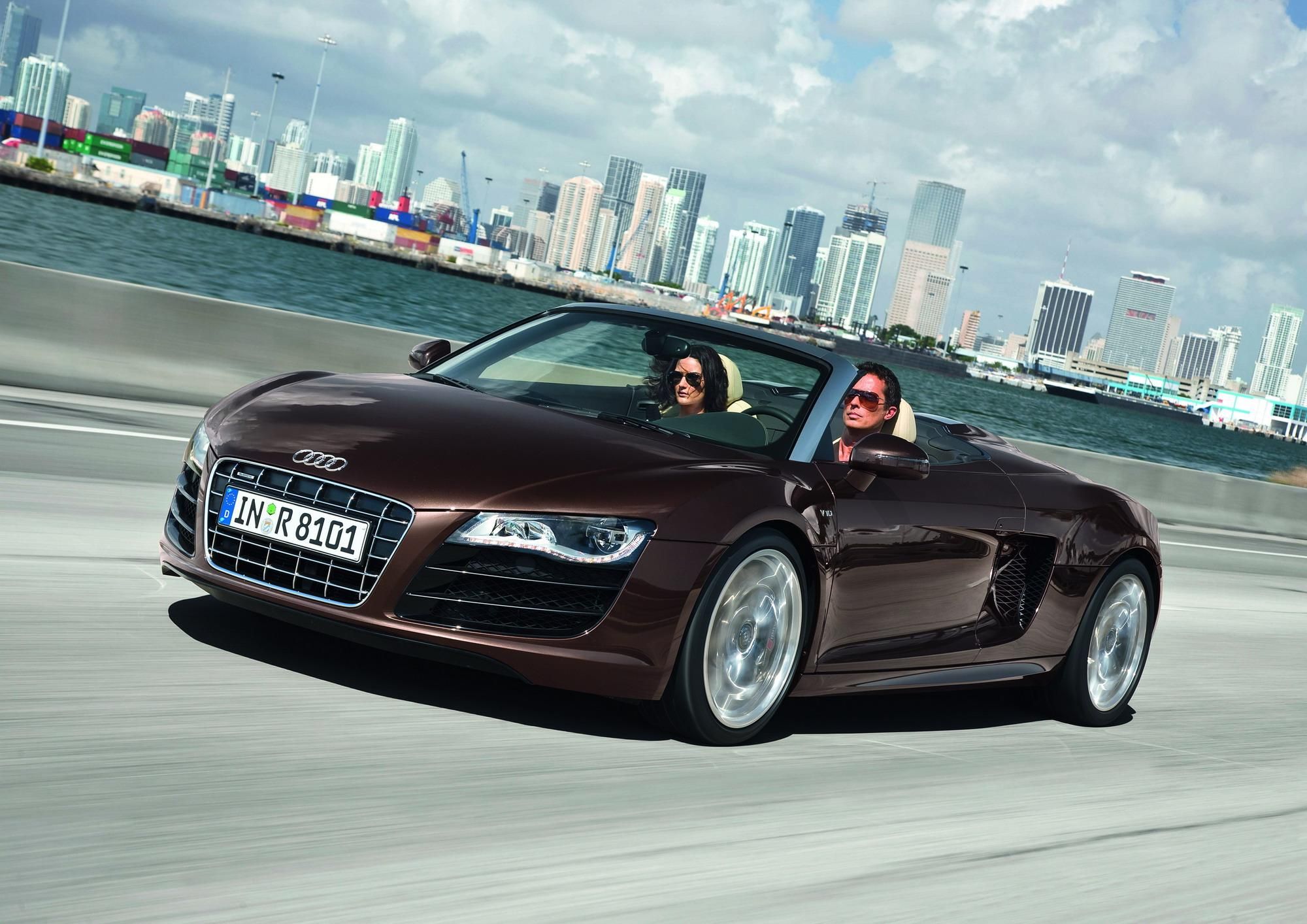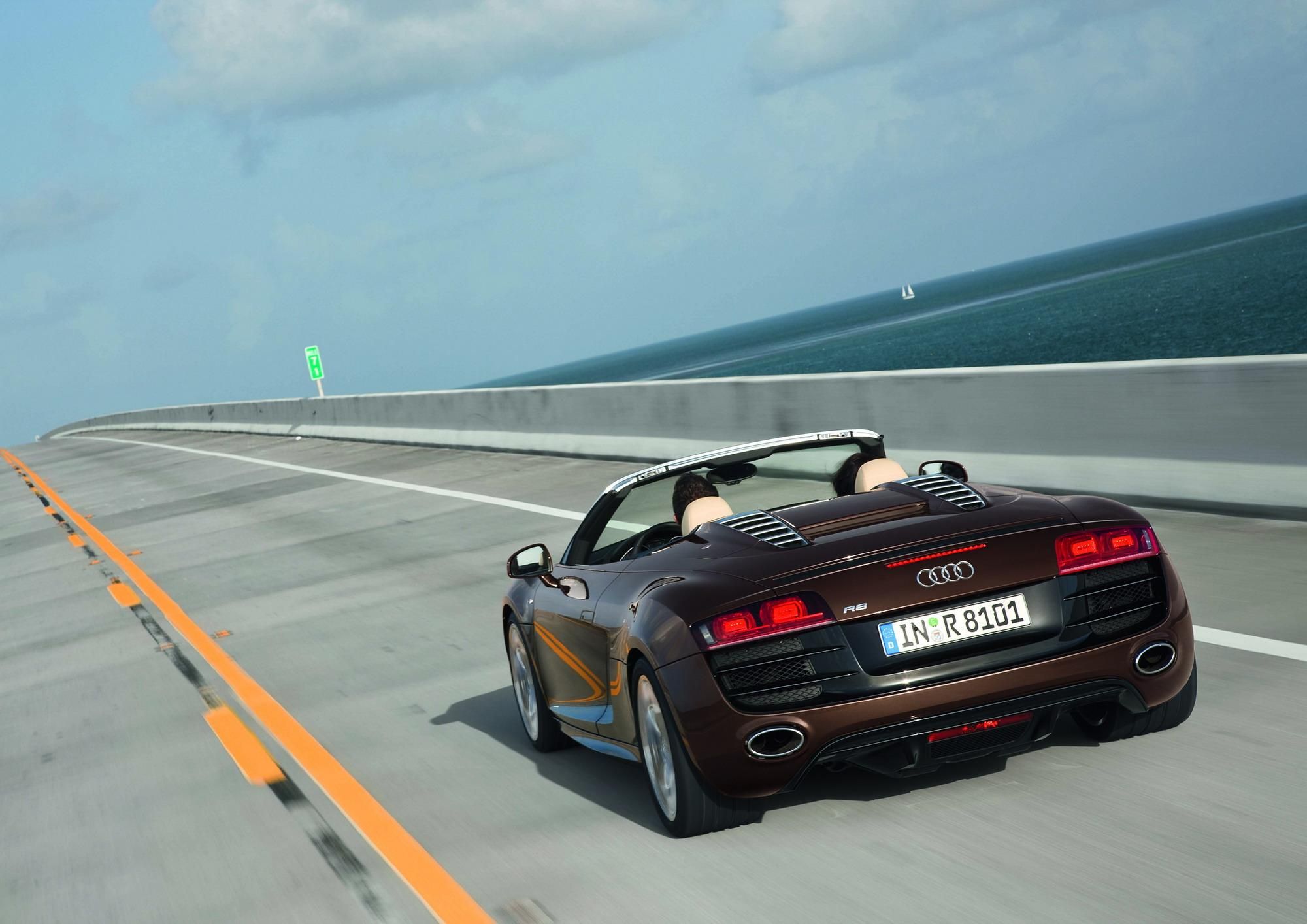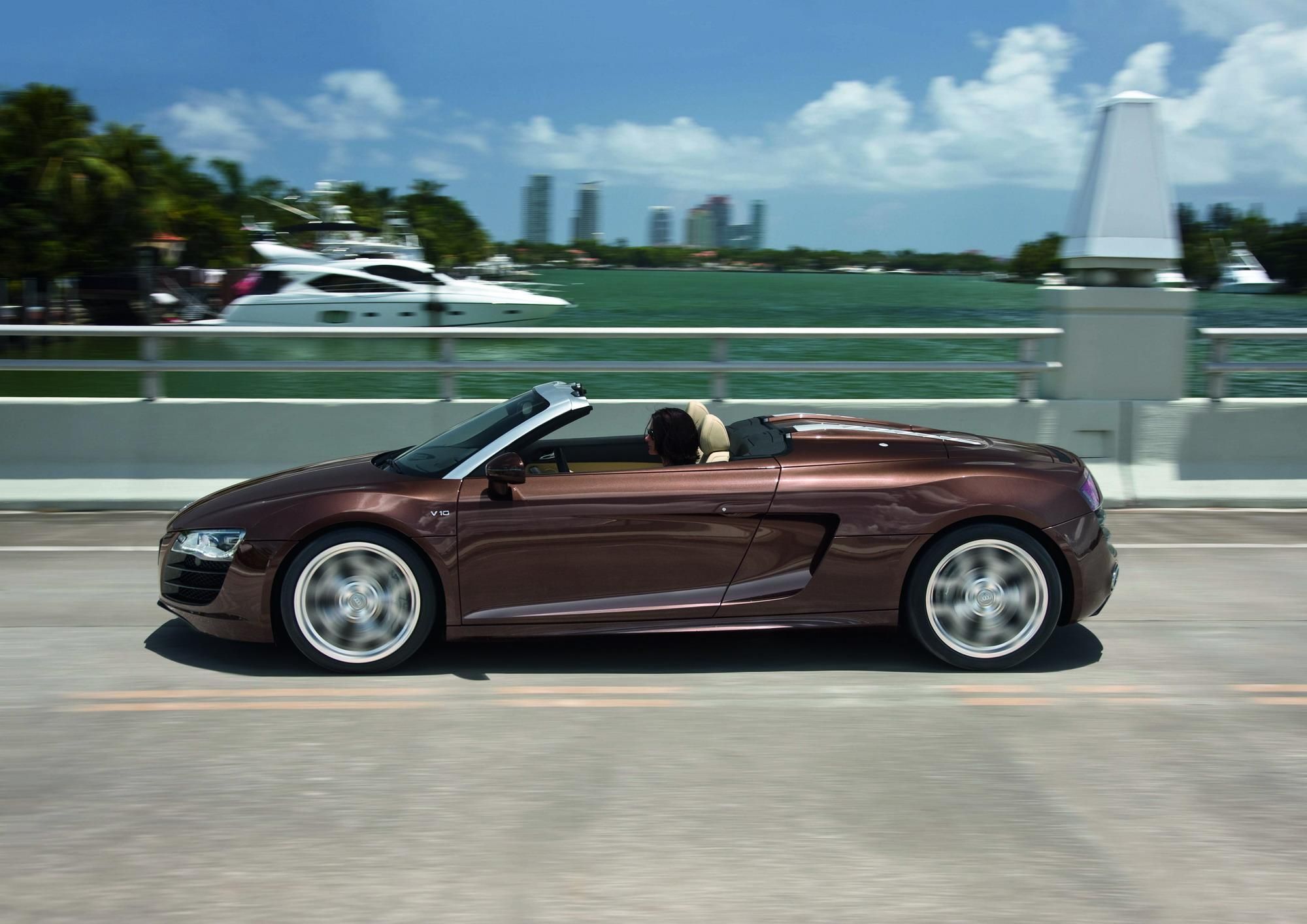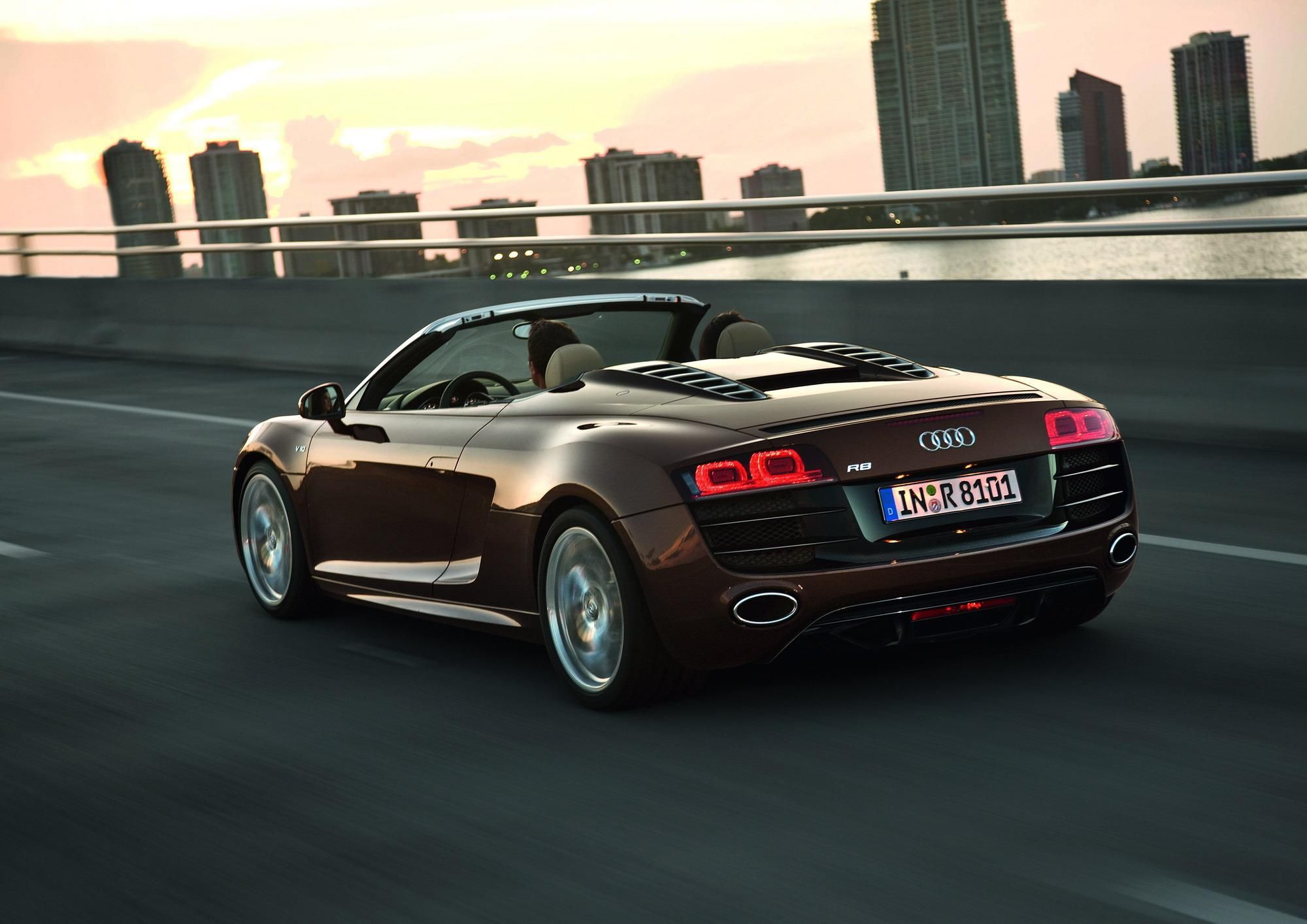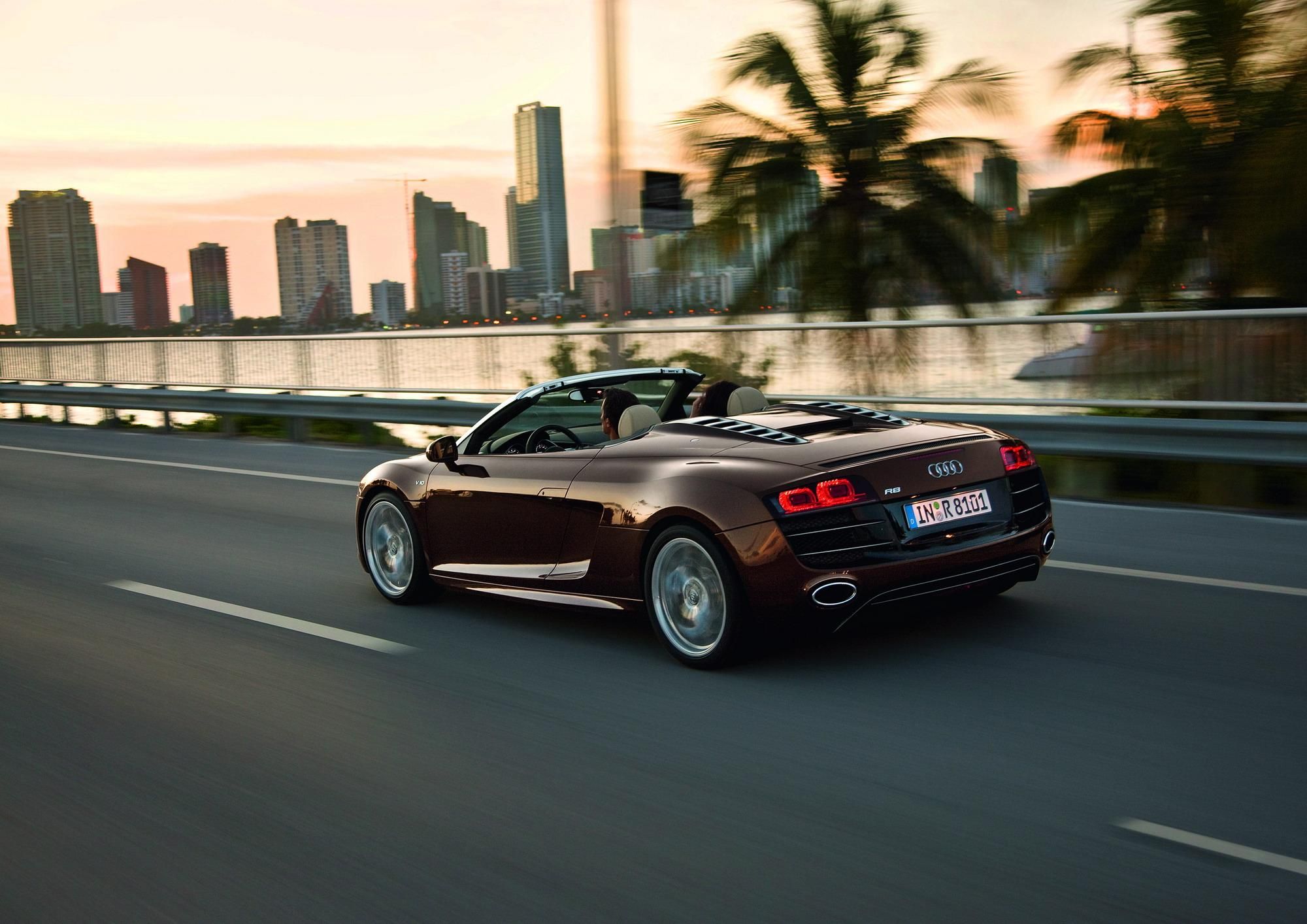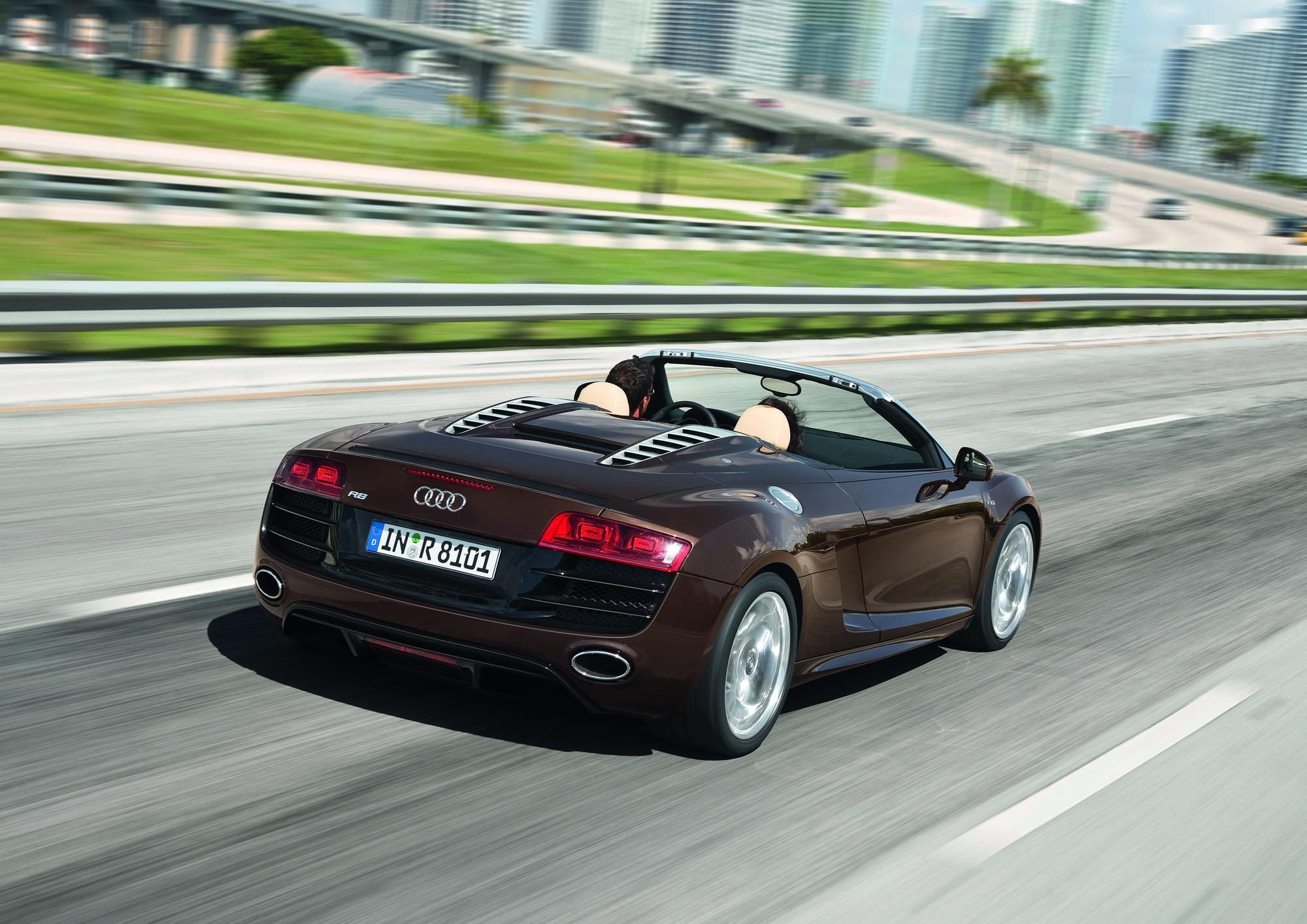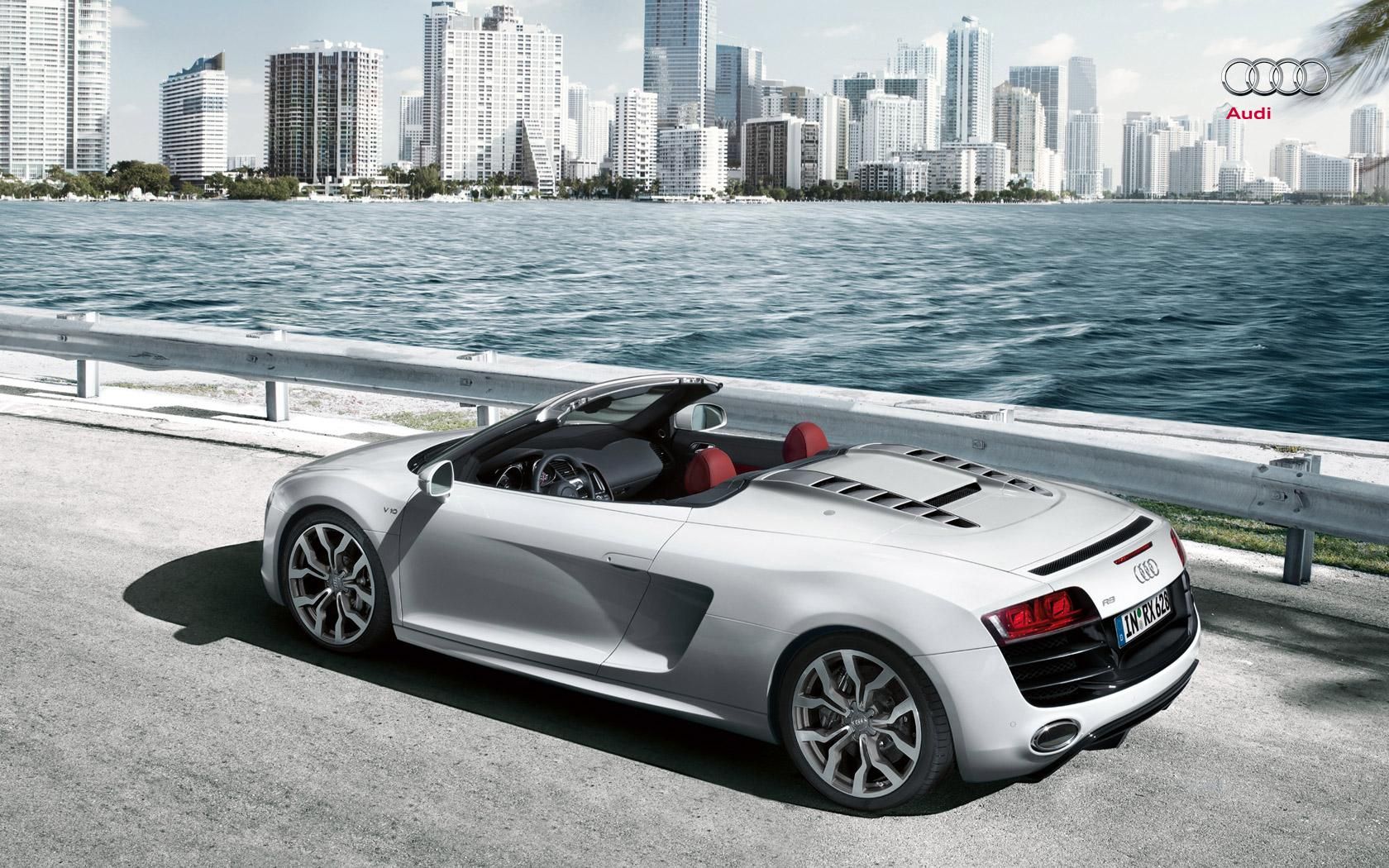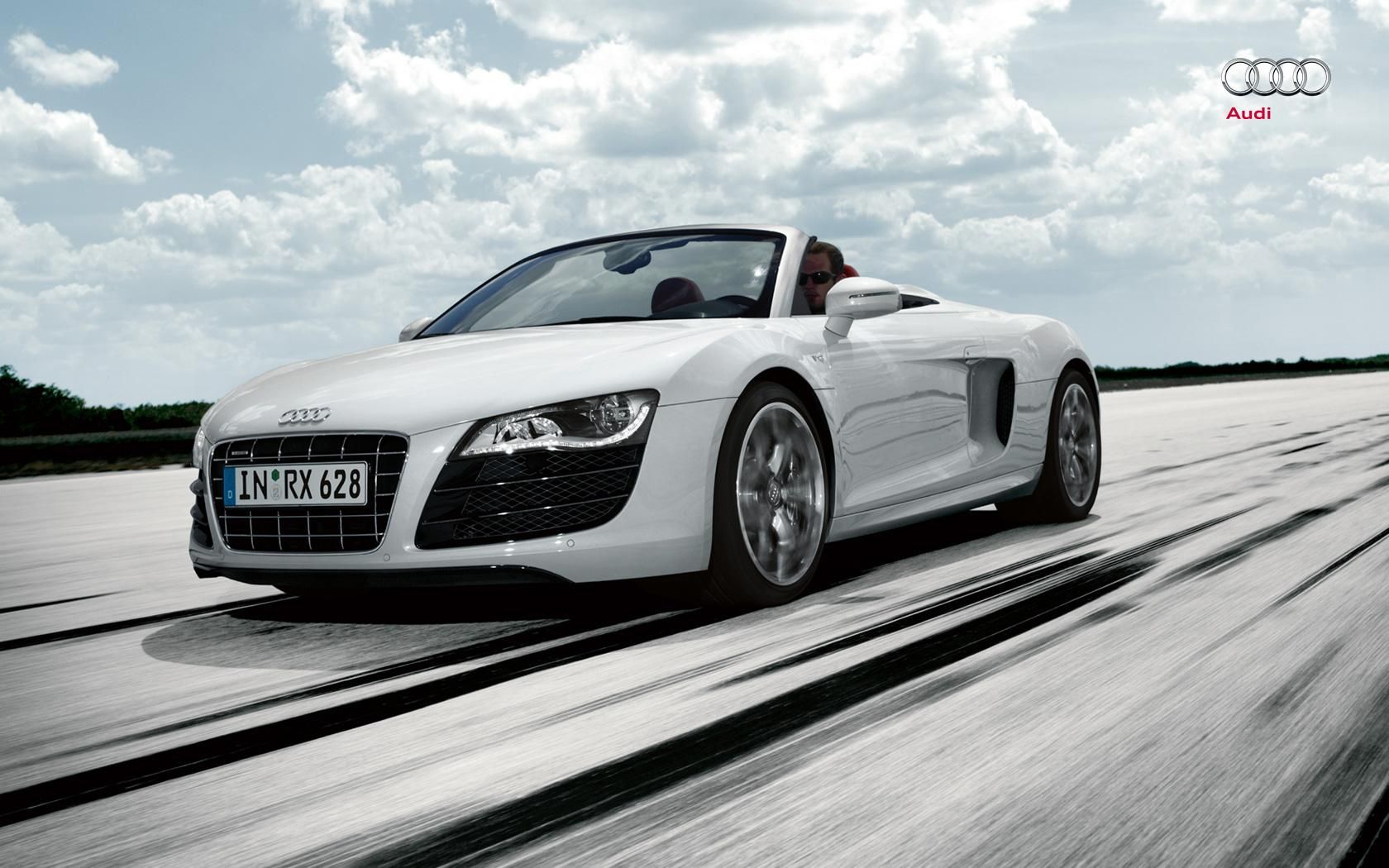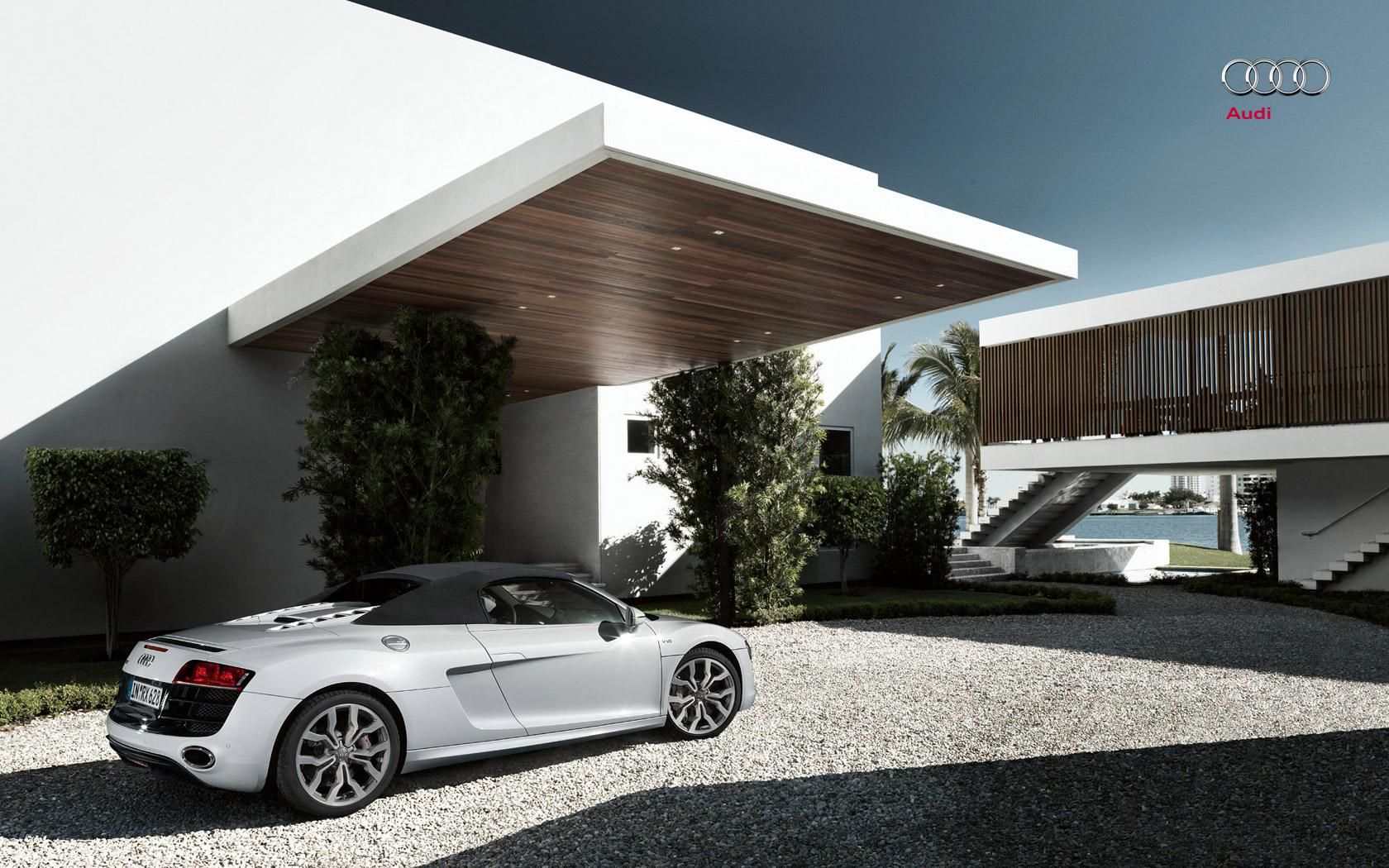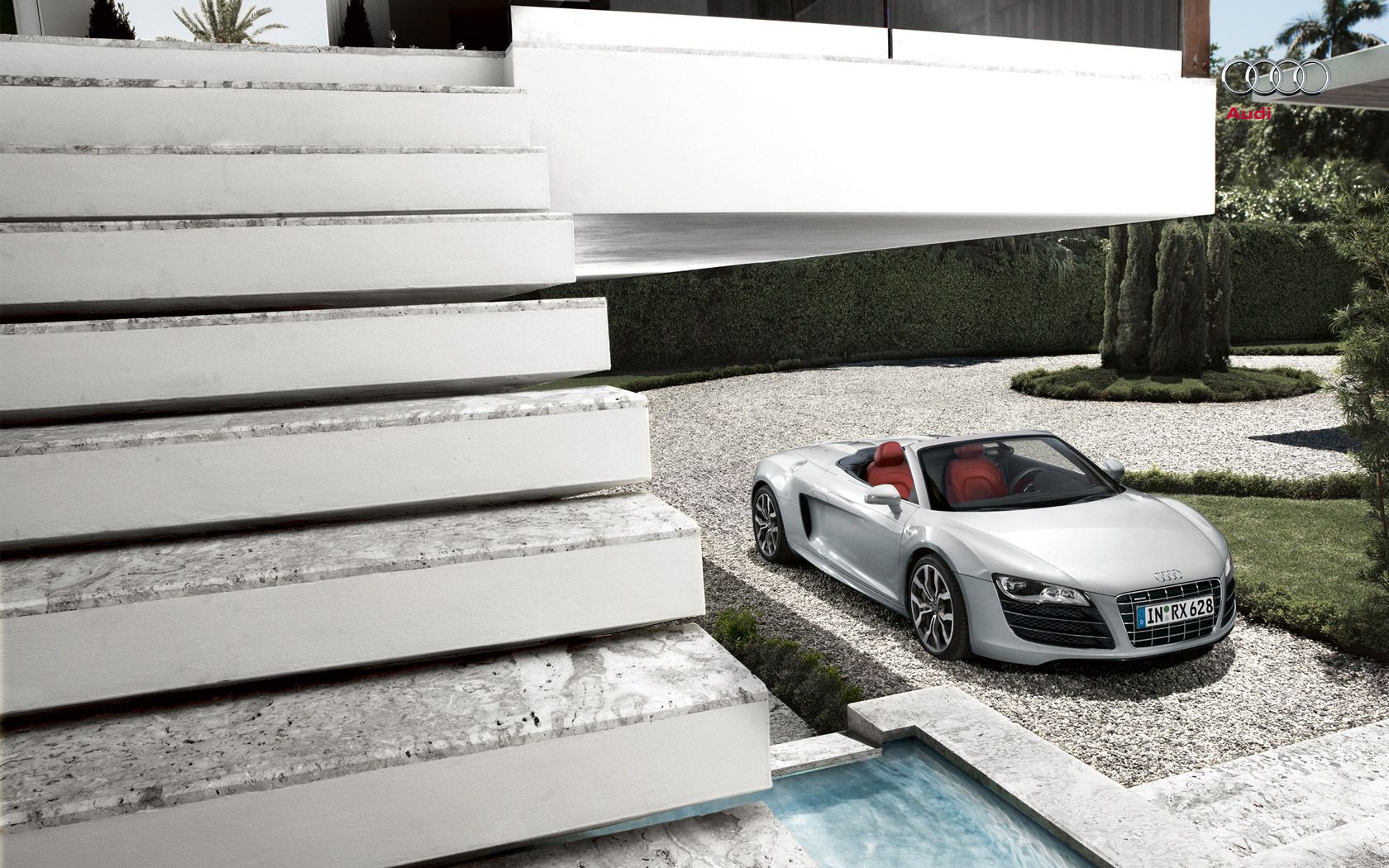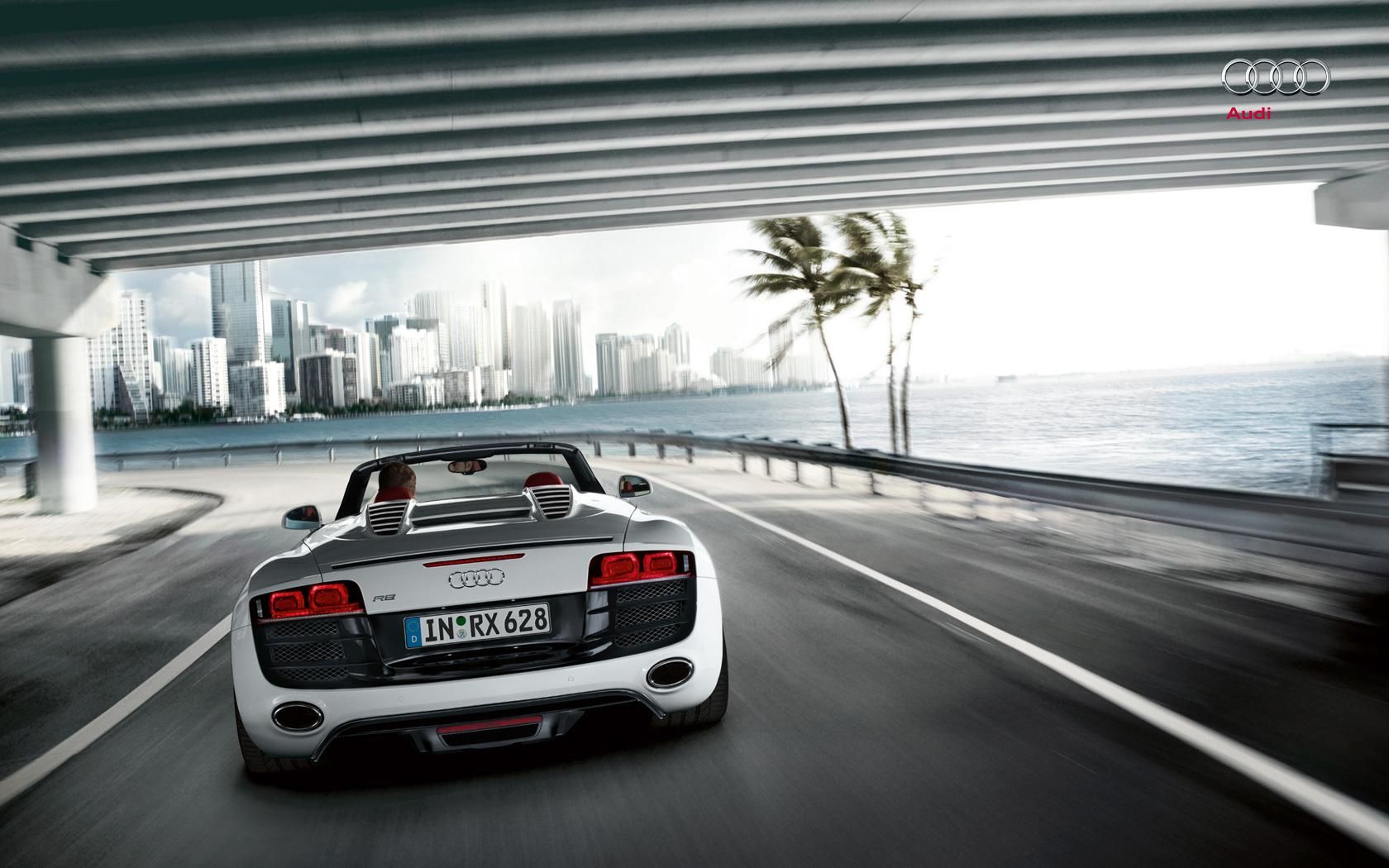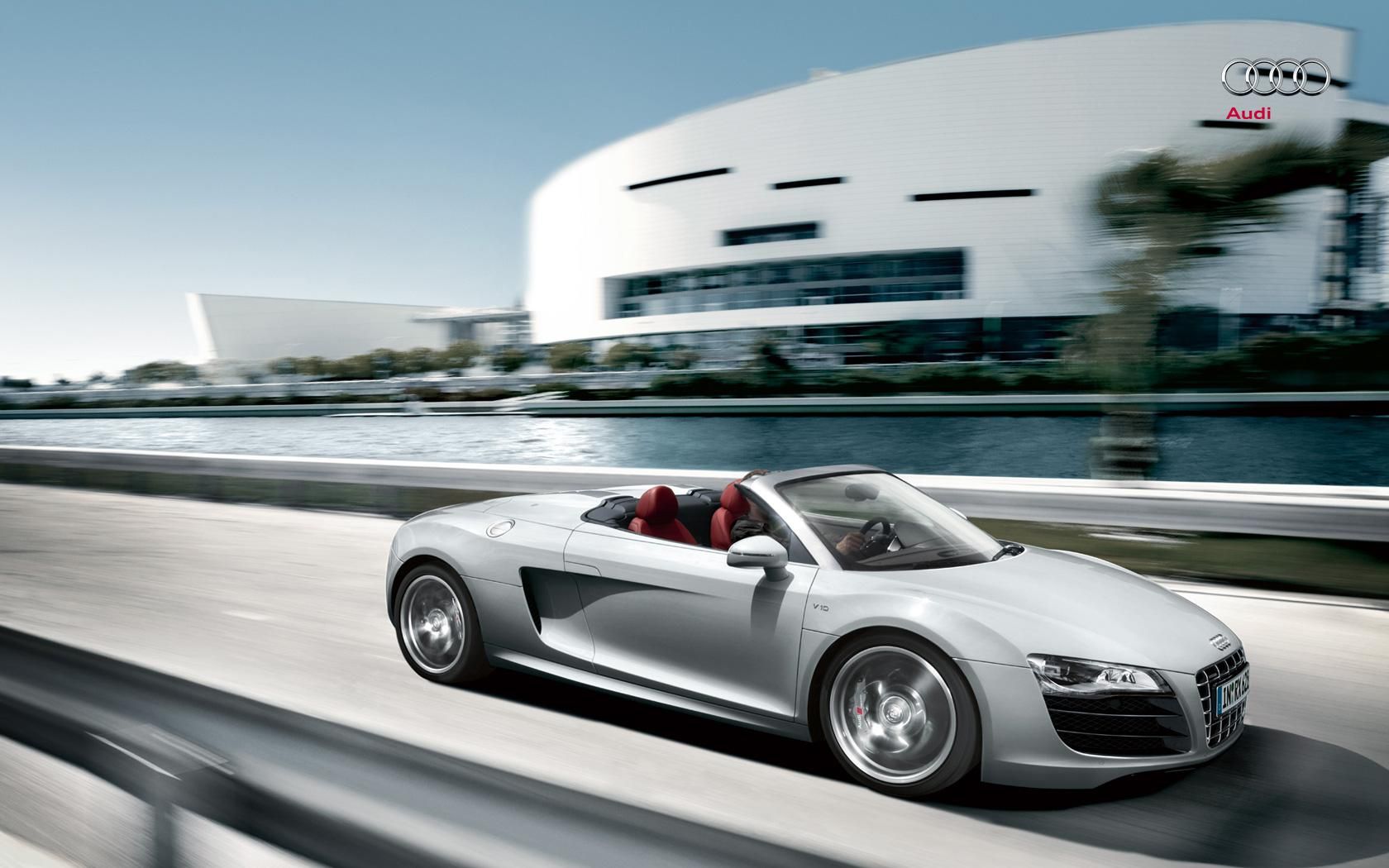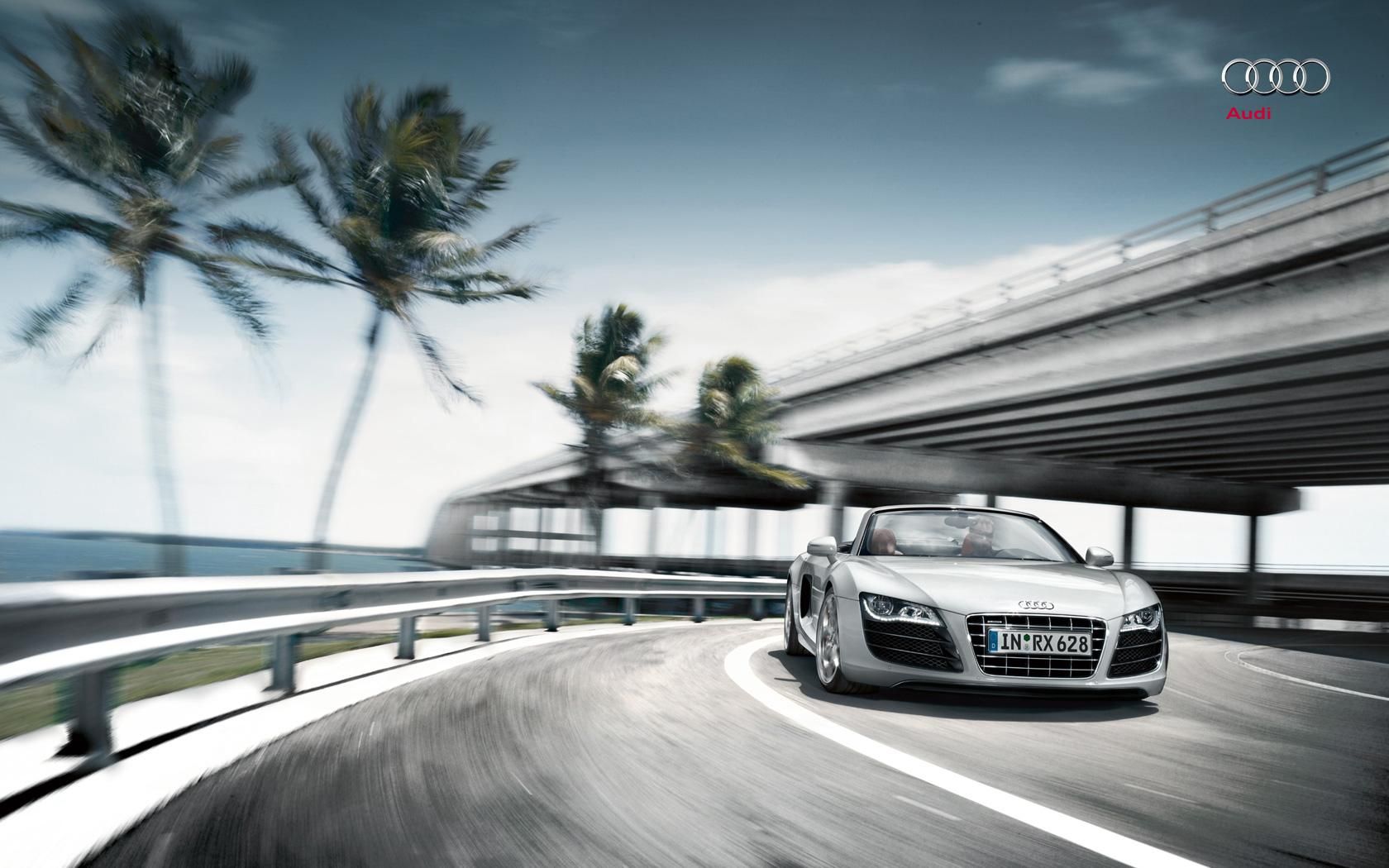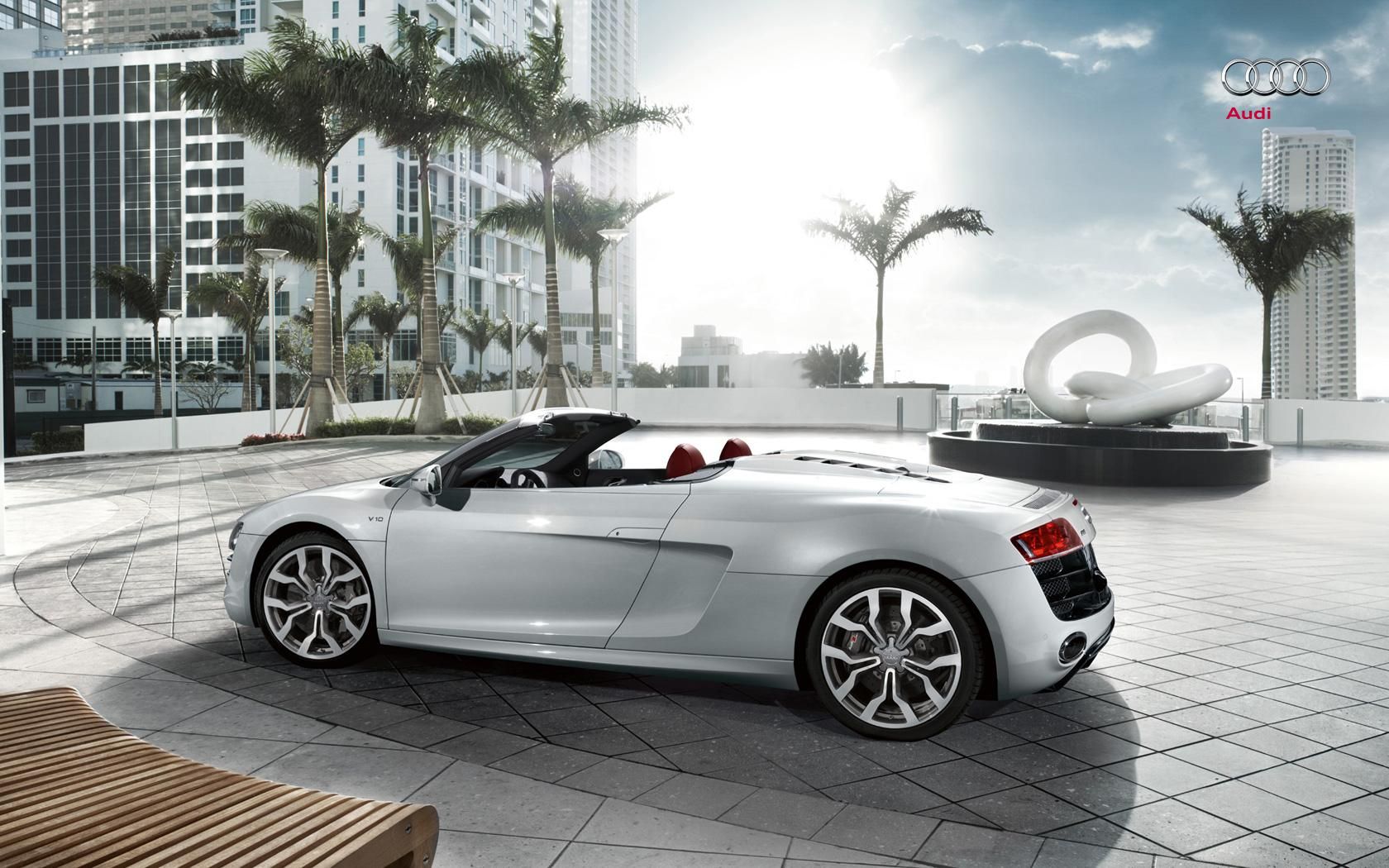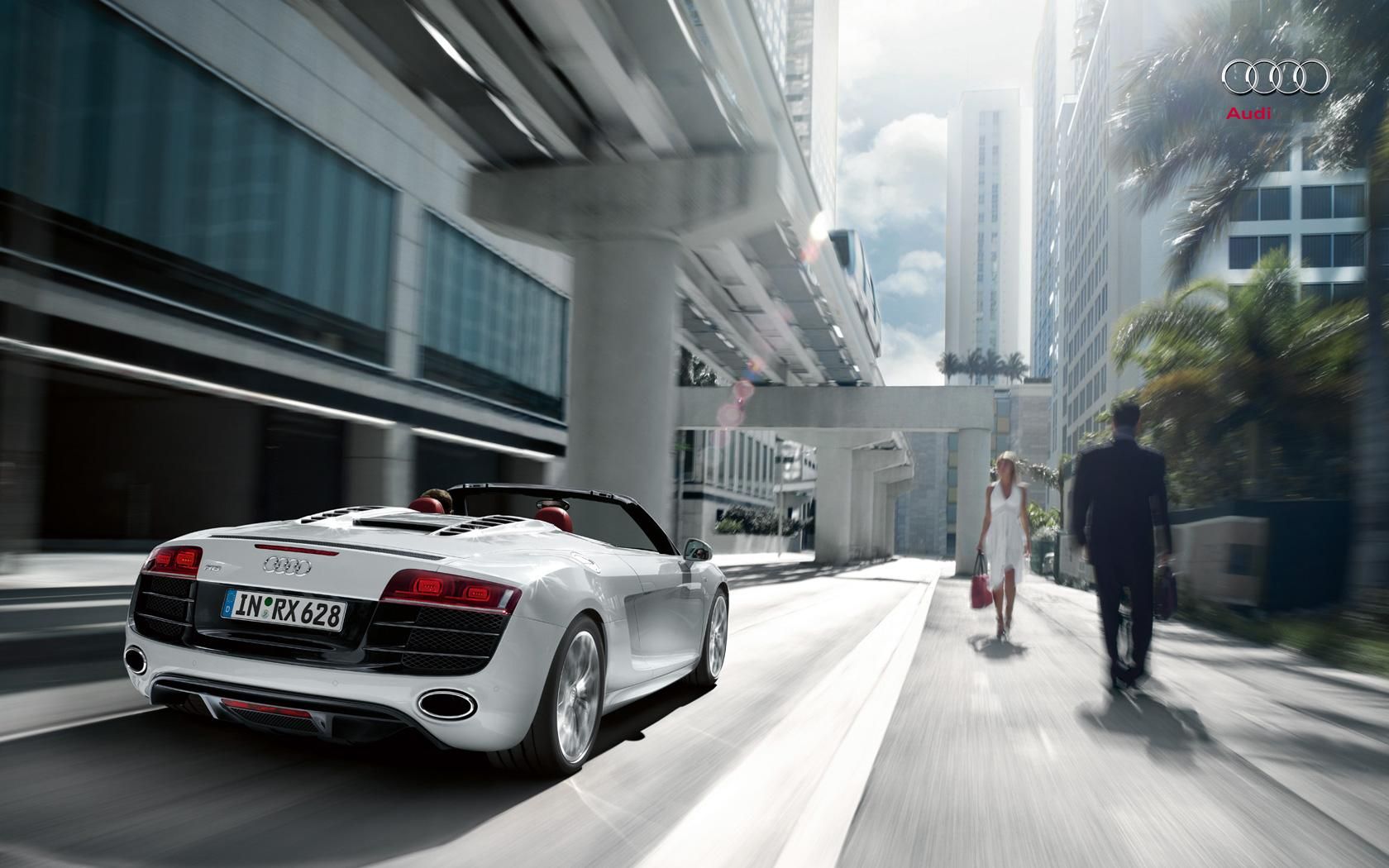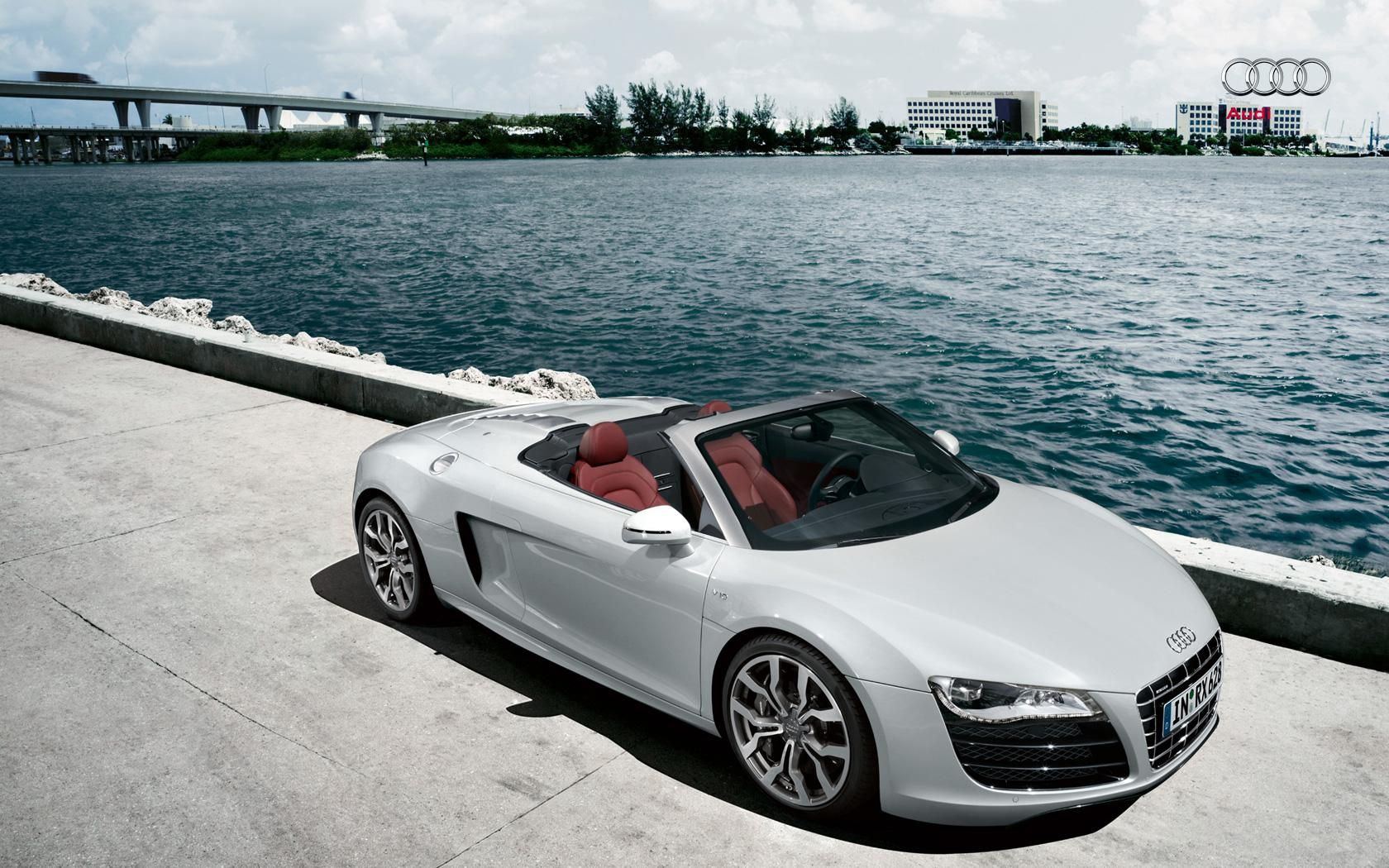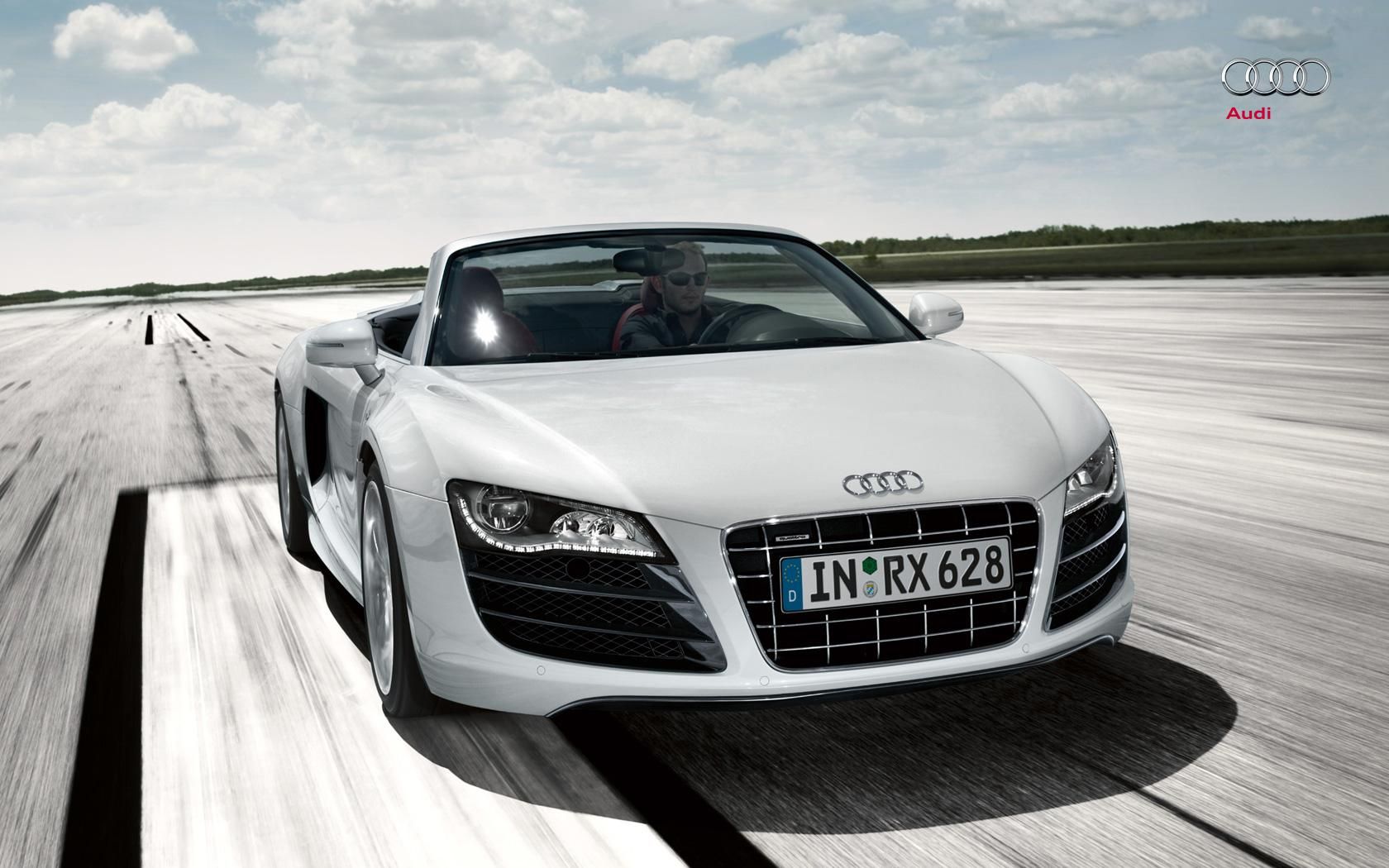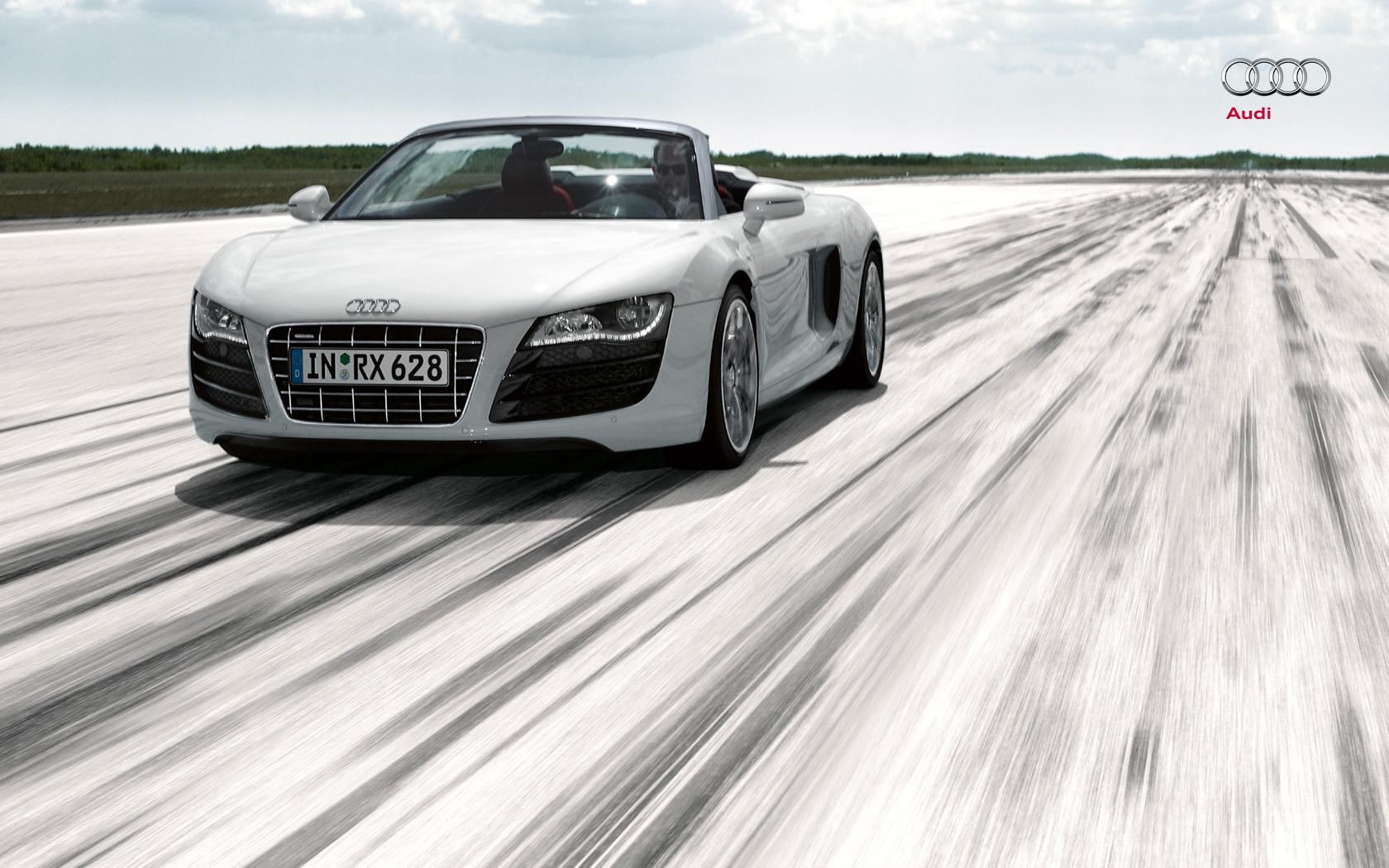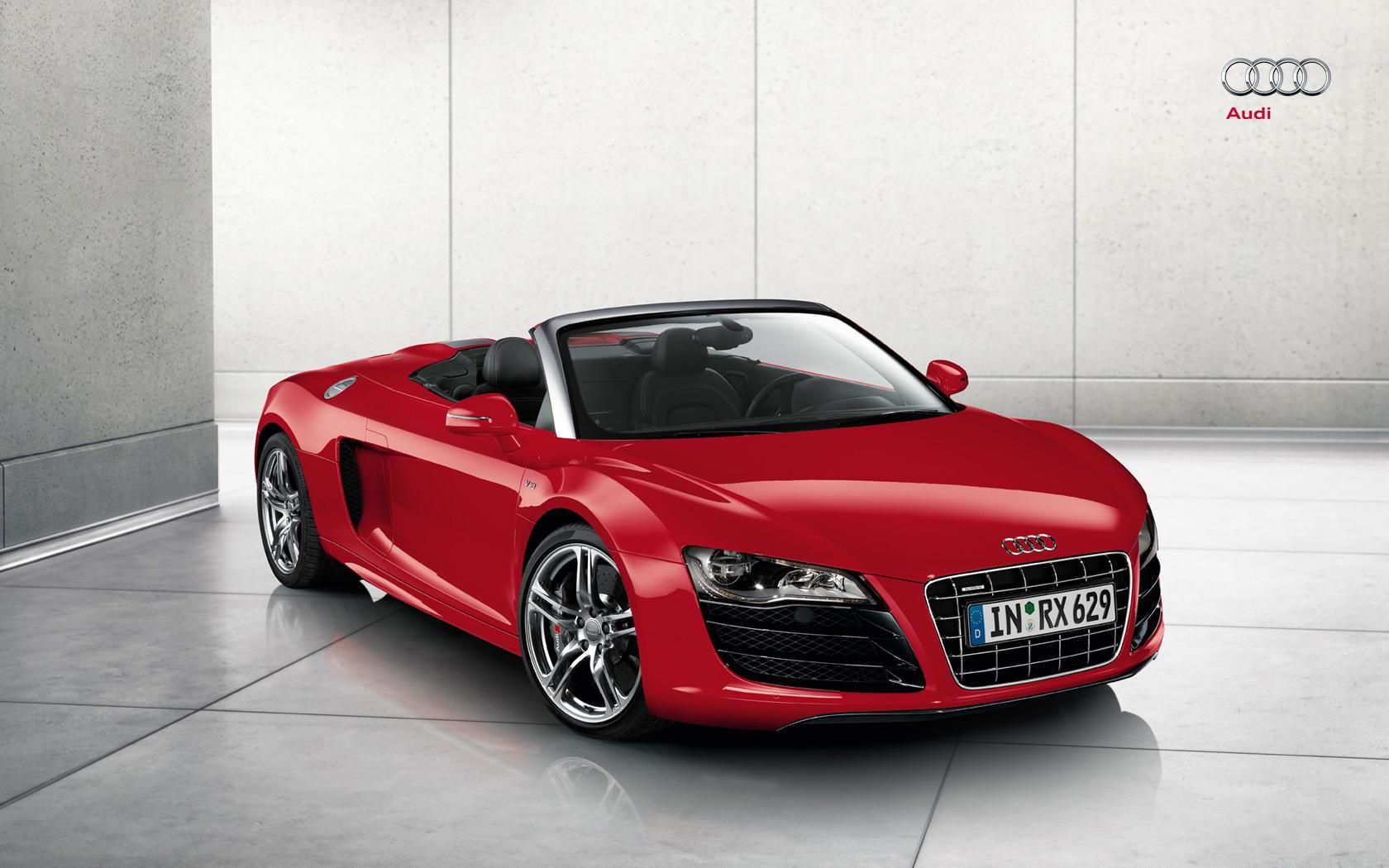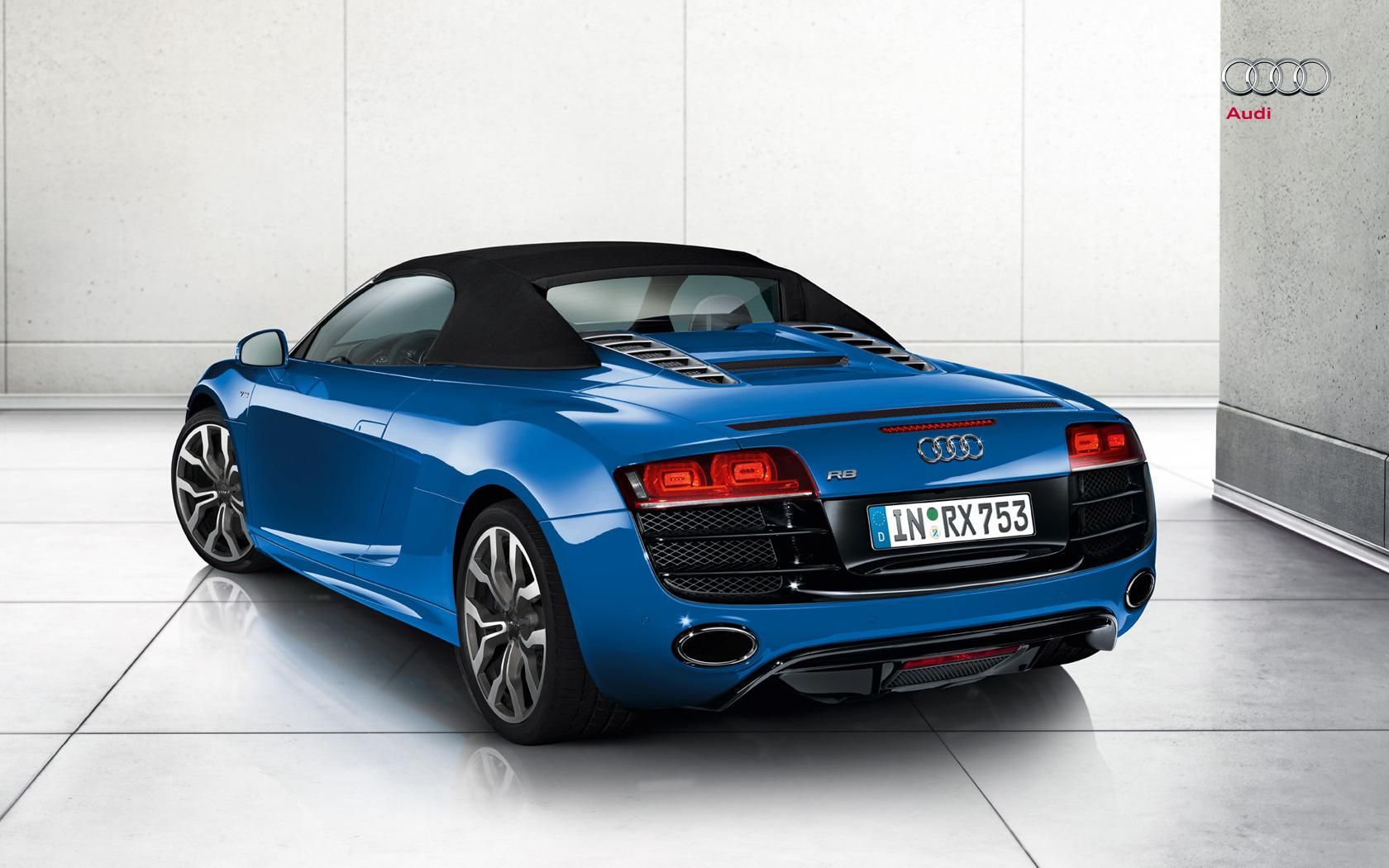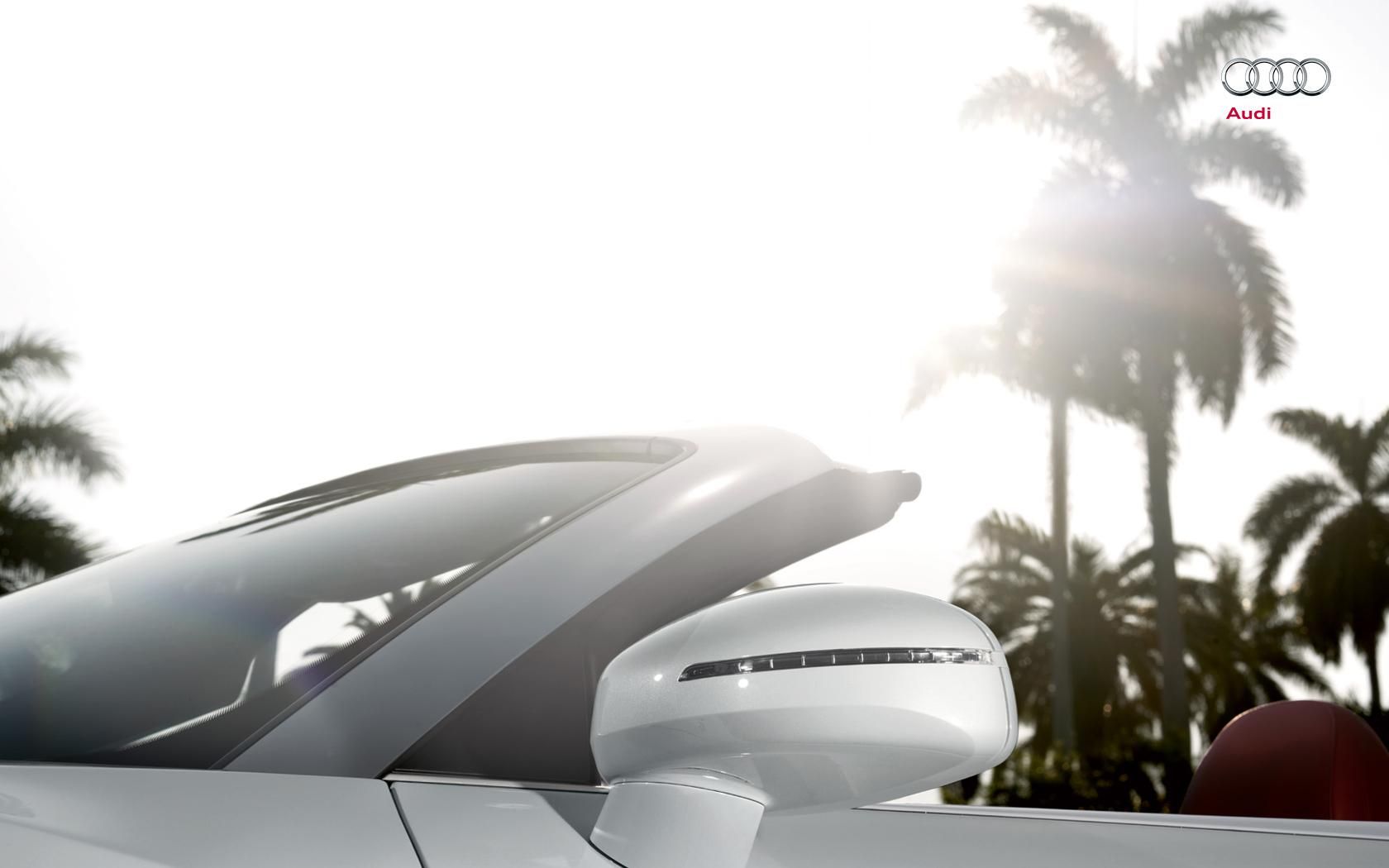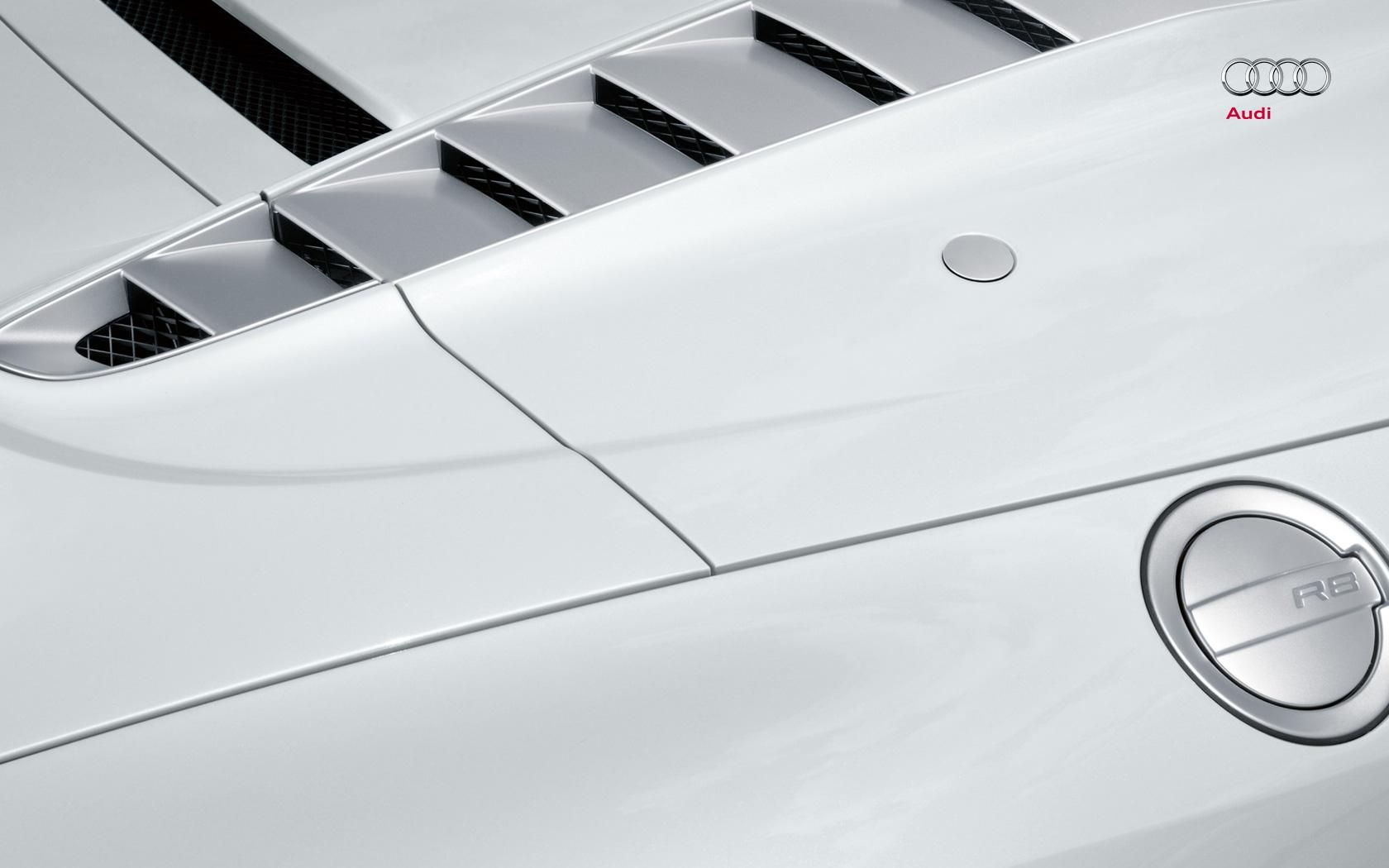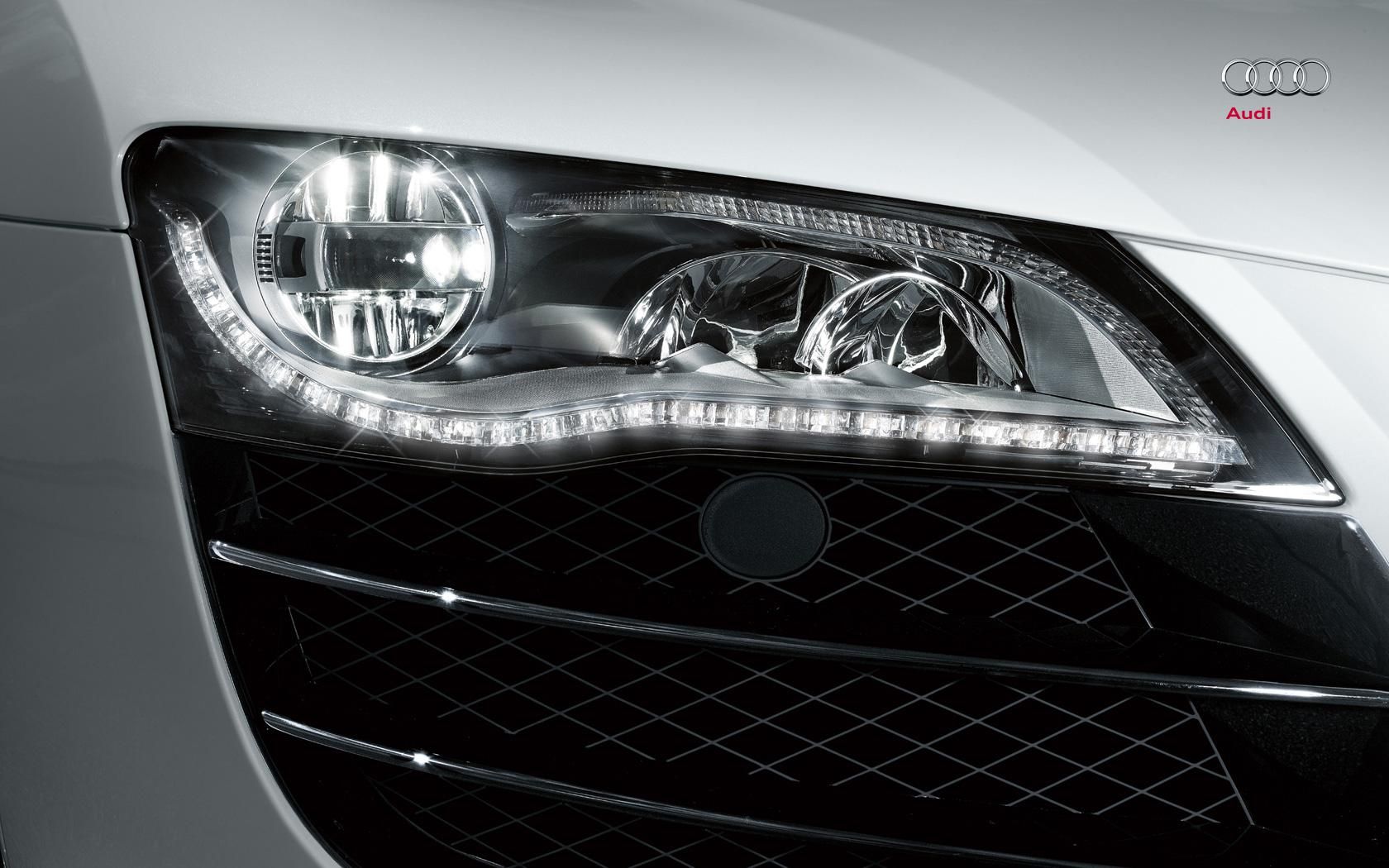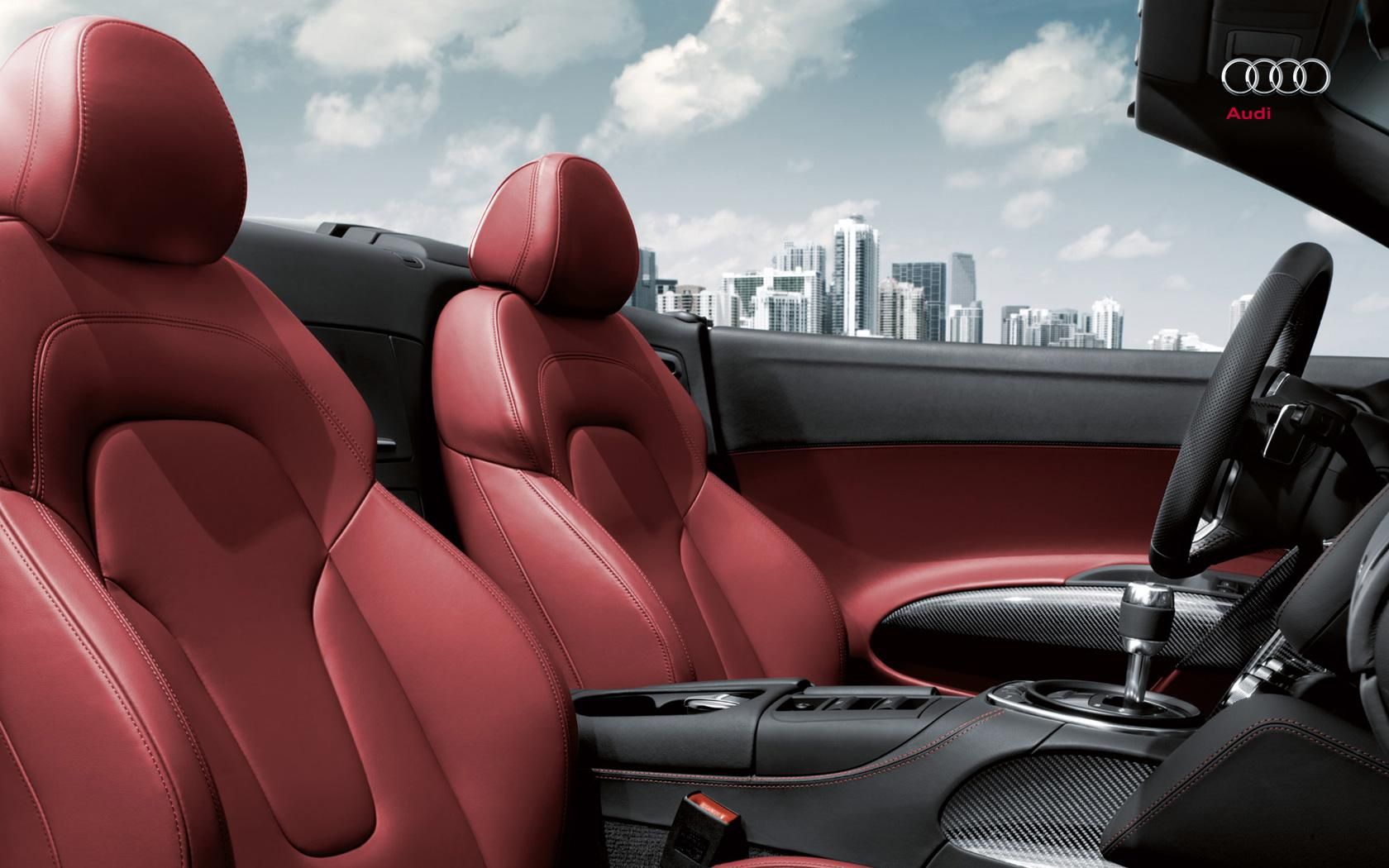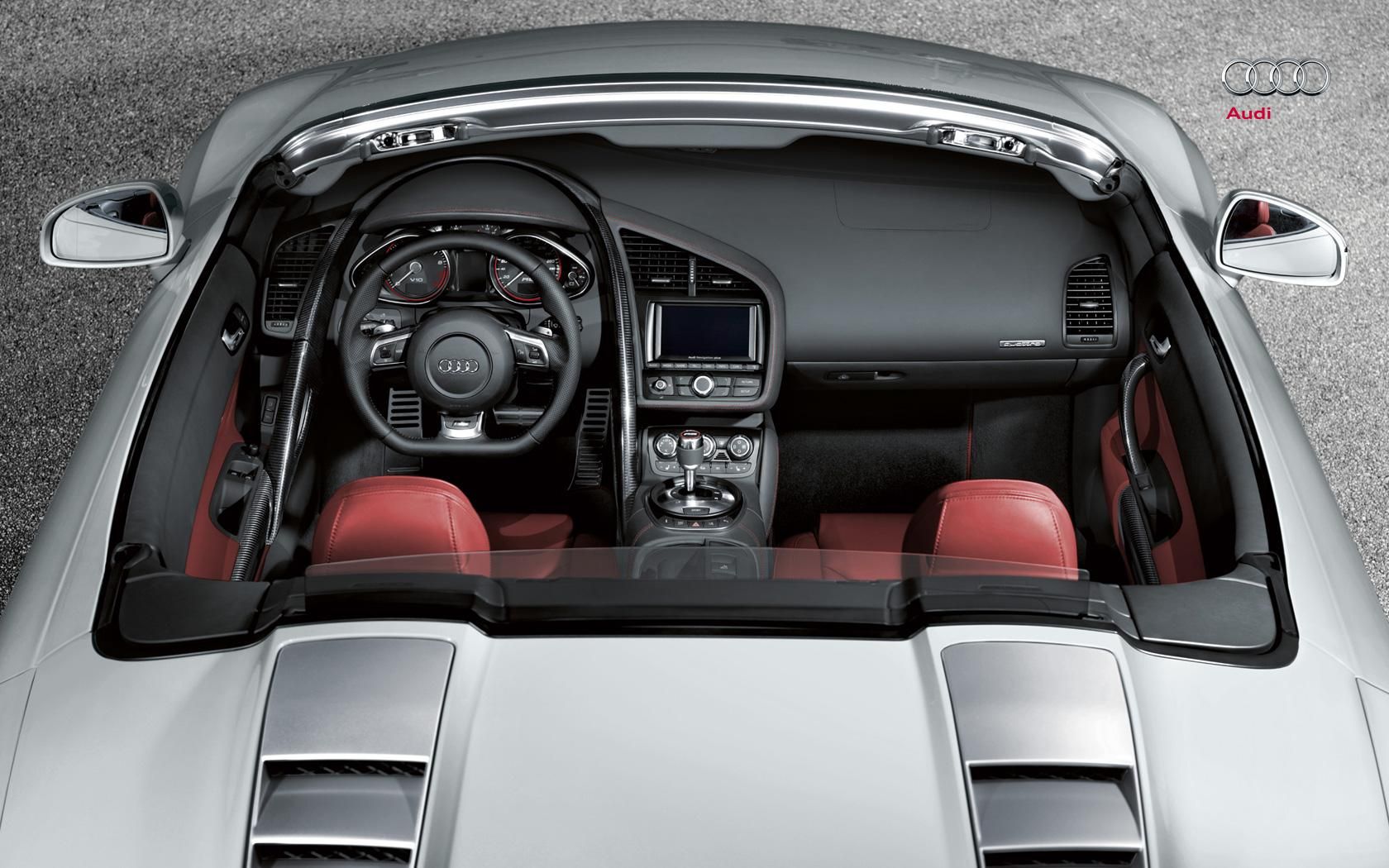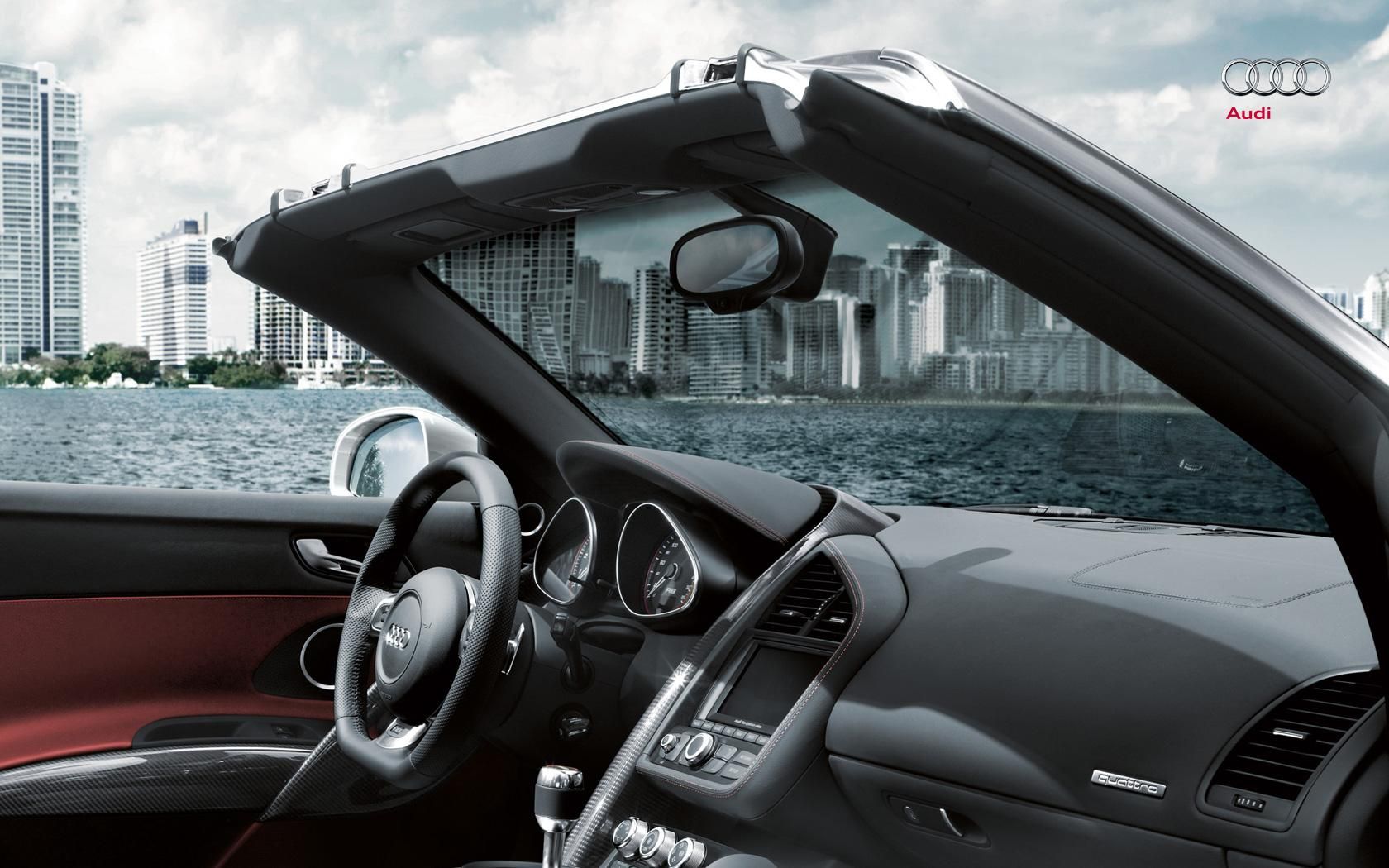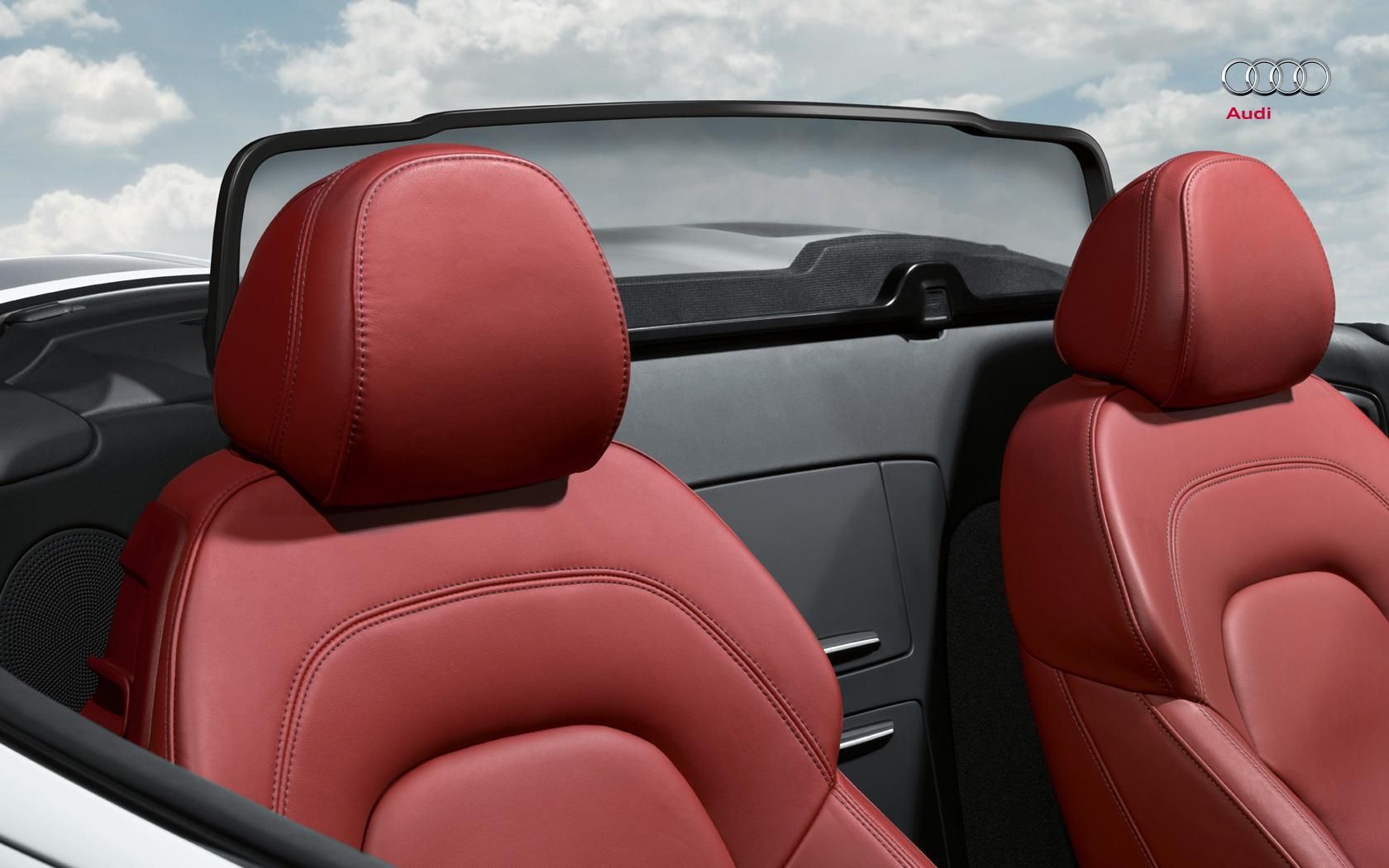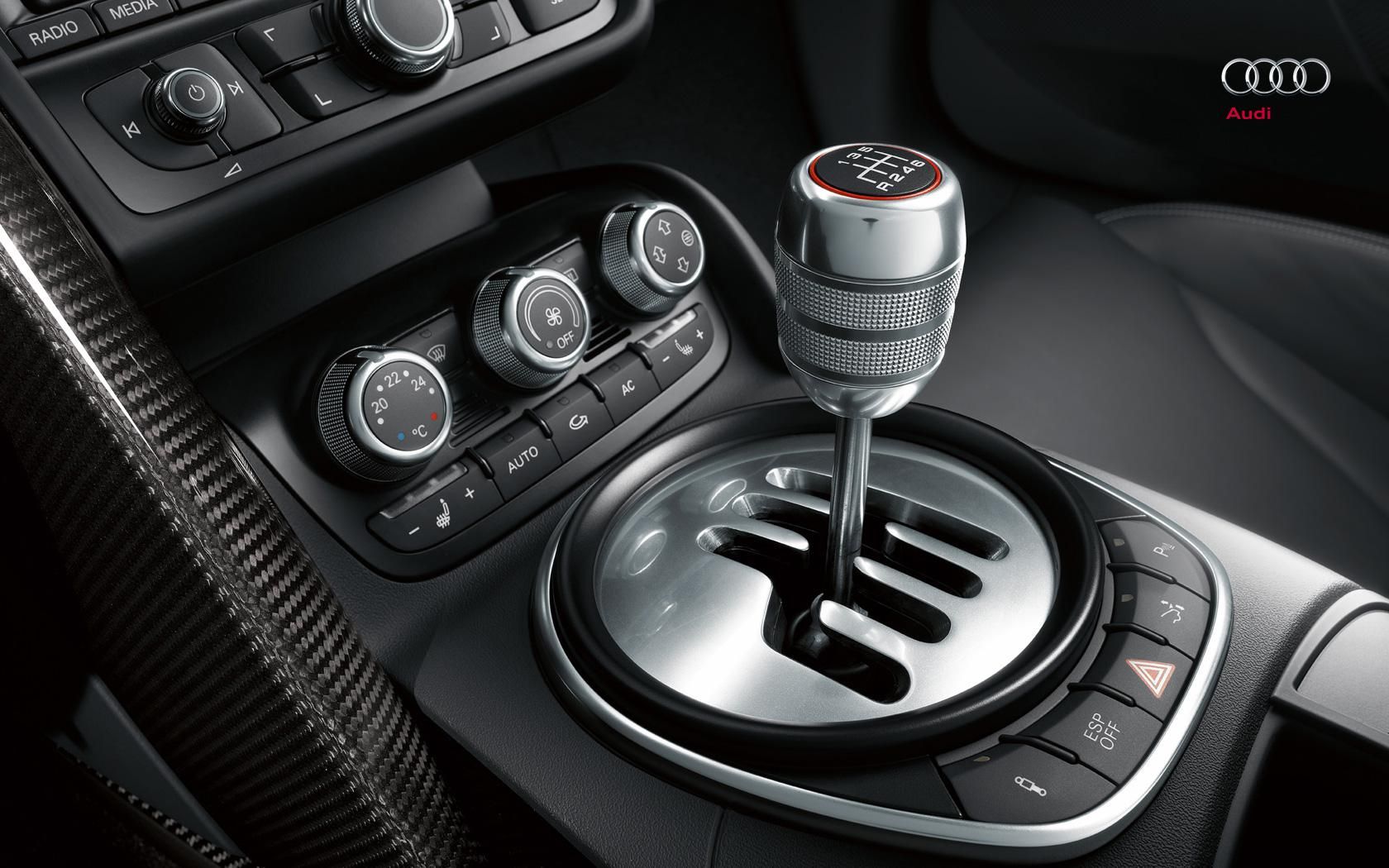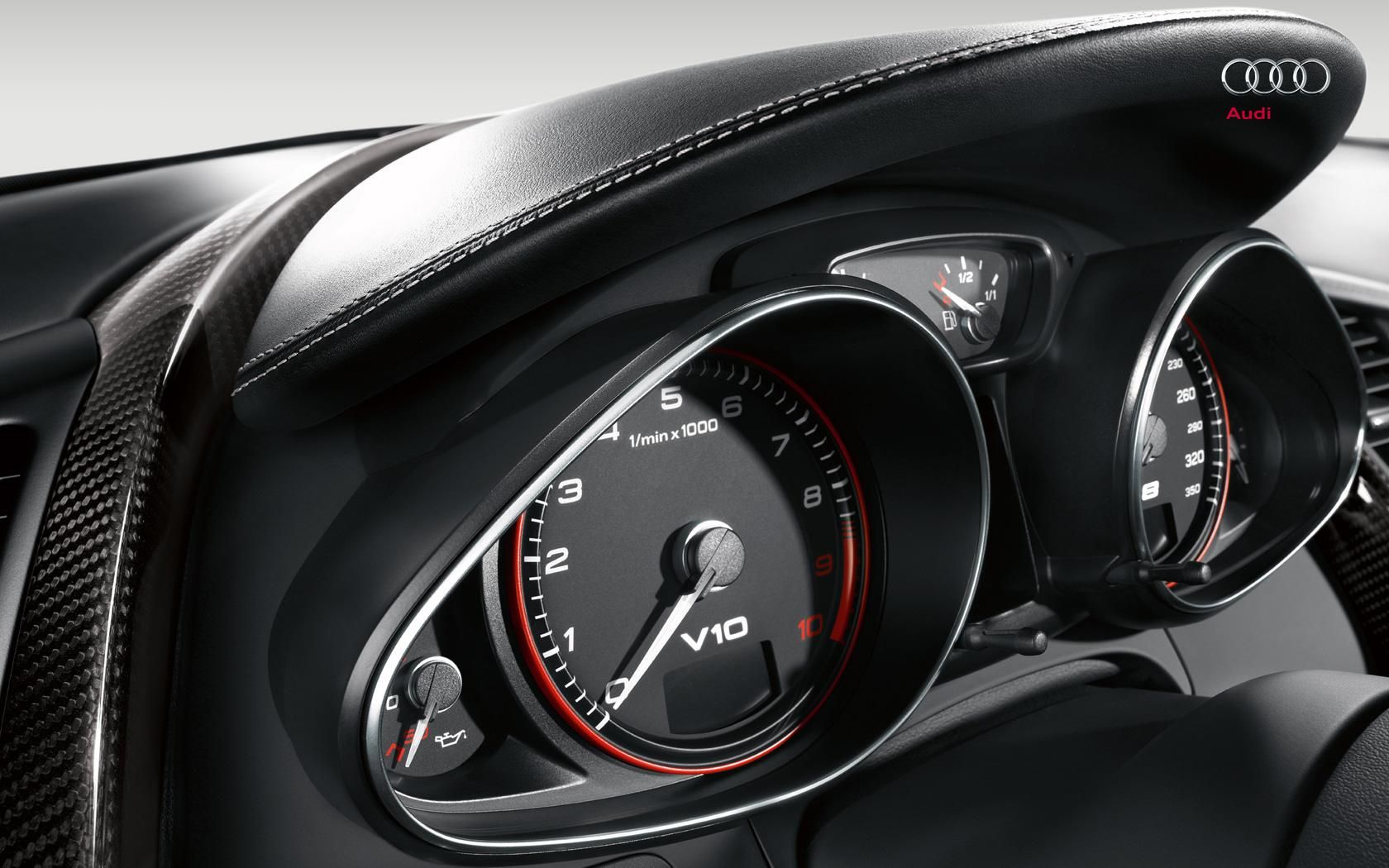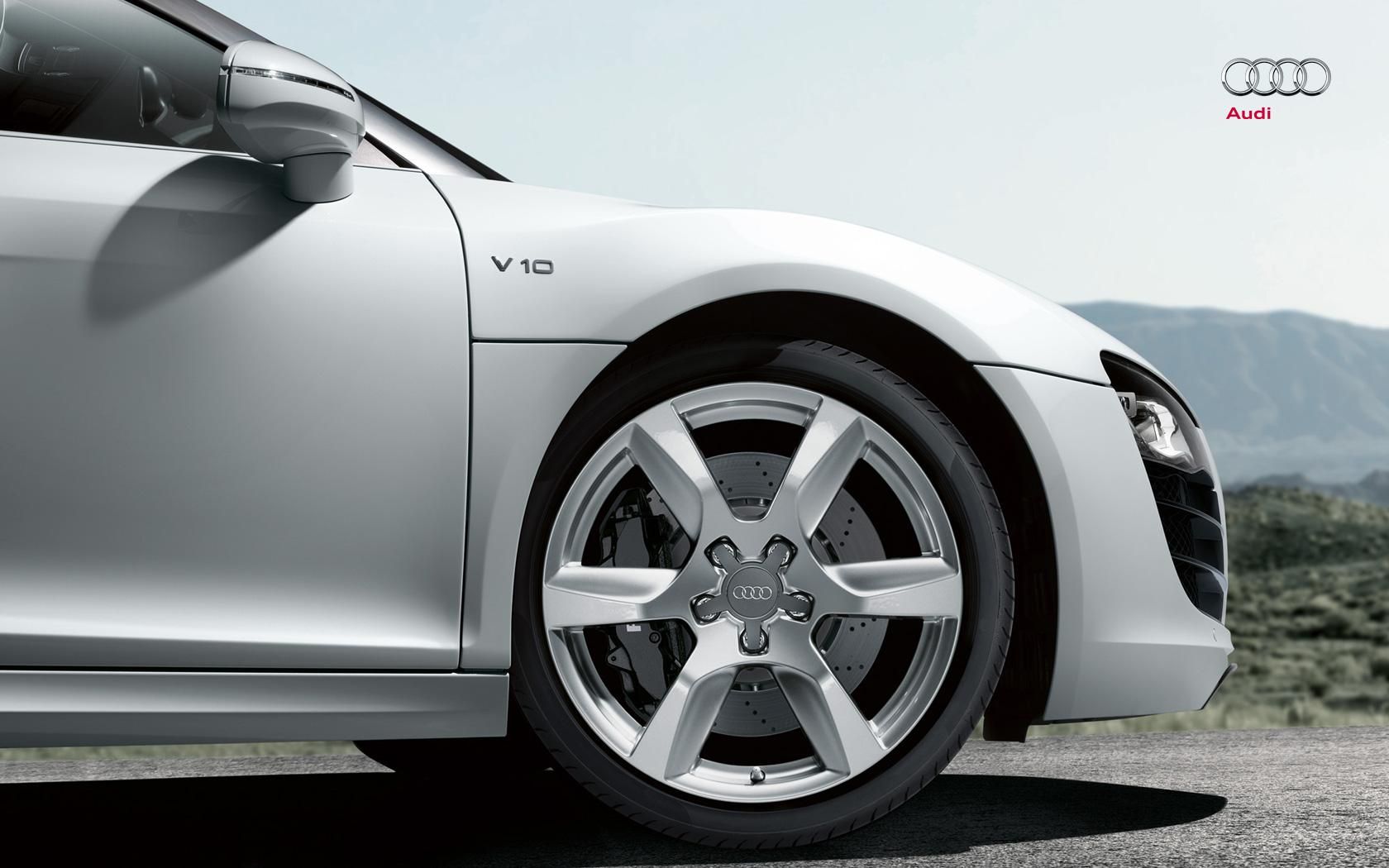The highly anticipated Audi R8 Spider has made its world debut at the 2009 Frankfurt Motor Show. The drop top R8->ke1440 will only be available with the 5.2 Liter FSI V10 (with a V8 version announced as a possibility in the future) connected to Audi's patented quattro all wheel drive system. Sales in Europe will begin in the first quarter of 2010 and retail starting at $227,000. Details for the U.S. market version will be announced at a later date.
The 5.2 Liter FSI V10 in the R8 Spider delivers a maximum output of 525 HP at 8,000 RPM and has a rather high compression ratio of 12.5:1 in order to get the most out of the high revving naturally aspirated power plant. With a weight of only 3,792 pounds, the R8 Spider is able to sprint from 0 to 60 MPH in under 4.1 seconds; go from 0 to 125 MPH in a little over 12.7 seconds and reach a top speed of 194.49 MPH, all while consuming 15.79 MPG in the manual transmission version, or 16.92 MPG in the R-tronic variant.
The all new Audi R8 Spider is being offered with a cloth top that weighs only 66.14 pounds; chosen as a solution by Audi to keep the rag top’s total weight and center of gravity lower in the vehicle. The electro hydraulic soft top opens and closes in 19 seconds, and operates even while driving at speeds of up to 31.07 MPH.
Audi will offer the unit in three different colors, while the car will be available with eleven different paint options, with metallic and pearl effect finishes standard. Like all of Audi's luxurious convertibles, the reinforced windshield frame is covered with anodized aluminum.
UPDATE 03/29/2011: Audi has unveiled a new commercial promoting their Audi R8 V10 Spyder. Enjoy!
Press release after the jump.
2010 Audi R8 Spyder 5.2 FSI quattro
- Make: Array
- Model: 2010 Audi R8 Spyder 5.2 FSI quattro
- [do not use] Vehicle Model: Array
Press release
Exceptional performance and breathtaking dynamism coupled with the intense sensations of open-top driving: Audi presents the R8 Spyder 5.2 FSI quattro. Its lightweight cloth top opens and closes fully automatically; several body parts are made of a carbon fiber composite material.
The V10 engine produces 386 kW (525 hp) and launches the open-top two-seater to 100 km/h (62.14 mph) in 4.1 seconds on its way to a top speed of 313 km/h (194.49 mph). Featuring technologies such as the Audi Space Frame (ASF), quattro permanent all-wheel drive, full-LED headlights and with an innovative seatbelt microphone available as an option, the R8 Spyder 5.2 FSI quattro is the new top-of-the-range Audi.
The Audi R8 Spyder 5.2 FSI quattro makes a powerful statement. The sculptured lines of the emotion-packed, high-performance sports car are a fascinating and unique interpretation of its dynamism. Unlike the Coupé, the Spyder does not have sideblades behind the doors. The side panels and the large cover over the storage compartment for the cloth top are made of a carbon fiber composite. Two arched cowls, which extend to the spoiler lip and include large, integrated air vents, give the rear of the open-top two-seater a powerful profile.
Like every open-top Audi, the R8 Spyder 5.2 FSI quattro has a cloth top – an uncompromising solution for a high-performance sports car. The soft top’s approximate weight is a mere 30 kilograms (66.14 lb); it thus keeps the vehicle’s total weight and center of gravity low. The top takes up little space when open and is a harmonious design element when closed. It tapers off to two slim fins extending to the trailing edge of the car, emphasizing the elongated silhouette.
The electrohydraulic soft top opens and closes in 19 seconds, even while driving at speeds up to 50 km/h (31.07 mph). When opened, it folds like a Z into its storage compartment over the V10 engine. The compartment cover opens and closes automatically. The heated glass window, which is separate from the cloth top, is lowered into the bulkhead. It can be independently raised and lowered at the press of a switch, with the top up or down. An additional net-like wind deflector comes standard and can be latched into the bulkhead behind the seats in two easy steps.
The top, which comprises an outer skin of a leakproof textile fabric and the headliner, is fully compatible with high-speed driving. When driving at moderate speeds with the top up, interior noise levels in the R8 Spyder are barely higher than in the Coupé. The bulkhead includes integrated rollover protection in the form of two strong, spring-tensioned plates. Head/thorax side bags in the backrests protect the passengers in the event of a side impact. Full-size airbags stand at the ready in the event of a head-on collision. In a rear-end collision, the integral head restraint system reduces the risk of whiplash injuries.
In the version with manual transmission, the R8 Spyder 5.2 FSI quattro weighs only 1,720 kilograms thanks primarily to its aluminum Audi Space Frame (ASF) body. Despite reinforcements in the area of the sills, the center tunnel, the rear wall, the floor pan and the A- and B-pillars, the body weighs only 216 kilograms (476.2 lb) – just 6 kilograms (13.23 lb) more than that of the R8 Coupé. The high stiffness of the ASF body, which includes an integrated engine frame of ultra-lightweight magnesium, provides the foundation for the car’s dynamic handling and superior safety.
Close attention to detail: the design
Numerous details demonstrate that the Audi designers put their hearts into the design of the R8 Spyder 5.2 FSI quattro. The air inlets in the nose, which direct air across the three radiators, and the lip of the front skirt are painted high-gloss black. The struts in the broad, low, single-frame grille are finely coated with chrome. The standard full-LED headlights are technical works of art. Their reflectors resemble open mussel shells; the daytime running lights appear to be a homogeneous strip, but actually comprise 24 individual LEDs that form a curve at the lower edge of the headlight.
The full-LED headlights from Audi are unmatched by its international competitors. Light-emitting diodes are used for the low beams, the high beams, the daytime running lights and the turn signals. With a color temperature of 6,000 Kelvin, the LED light is very similar to daylight, making it easier on the eyes when driving at night. Additional strengths include excellent light distribution, long service life and extremely low energy consumption.
Audi offers the R8 Spyder 5.2 FSI quattro with a choice of three colors for the top. The body is available in eleven paint finishes, with metallic and pearl effect finishes standard. The windshield frame is coated with anodized aluminum.
Sporty luxury: the interior
The open-top two-seater from Audi features a generously spacious interior. The three-spoke leather multifunction sport steering wheel is flattened at the bottom as in a race car, and the low-mounted, electrically adjustable seats guide and support the body perfectly.
Quality of fit and finish is extraordinary and the controls are clear and logical. The standard driver information system includes a lap timer for recording lap times. The instruments and the gear lever knob feature red rings. The pedals, the footrests and the shift paddles of the optional R tronic are in aluminum look. Highlighting the list of standard equipment are a generous full-leather package featuring Fine Nappa leather, an excellent sound system from Bang & Olufsen, a deluxe automatic air conditioning system and heated seats. Six different interior colors are available.
Many additional fine features documents the top status of the Audi R8 Spyder 5.2 FSI quattro. The leather for the seats are colored with pigments that reflect the infrared component of sunlight, which keeps the seats up to 20 degrees Celsius cooler.
Door sill strips coated with aluminum and adorned with black satin finish applications impart an air of luxurious sportiness. Three storage compartments are integrated into the rear bulkhead, one of which contains the optional CD changer or Audi music interface, if desired. There is a front compartment for 100 liters (3.53 cu ft) of luggage.
The latest version of the navigation system plus with MMI operating logic is also standard in the R8 Spyder 5.2 FSI quattro. It features higher resolution and particularly fast route calculation. The system’s most visible new feature is the high-resolution, 6.5-inch display. The topographic view can be scrolled in any direction. The system can be combined optionally with a rearview camera that serves as a parking aid.
Audi offers custom extras, such as exclusive leather packages and special inlays. A worldwide first is the optional seatbelt microphone for the hands-free unit, which makes it possible to talk on the phone even with the top down on the highway. Three small, flat microphones are integrated into both seatbelts. At least one of them is ideally positioned relative to the speaker when the belt is on. There is a fourth microphone in the windshield frame.
Uncompromising power: the engine
The Audi R8 Spyder 5.2 FSI quattro, which was developed in cooperation with quattro GmbH, dazzles with uncompromising performance. The V10 engine with the aluminum crankcase, much of which is hand-built, follows in the grand motorsports tradition at Audi. The normally aspirated engine produces 530 Nm (390.91 lb-ft) of torque at 6,500 rpm. Peak output of 386 kW (525 hp) is reached at 8,000 rpm, and the rev limit is not reached until 8,700 rpm. Specific power output is 100.9 hp per liter of displacement; each hp only needs to move 3.3 kilograms (7.28 lb) of weight.
Performance reflects this awesome potential: 0 – 100 km/h (62.14 mph) in 4.1 seconds; 0 – 200 km/h (124.27 mph) in 12.7 seconds; top speed is 313 km/h (194.49 mph) with the six-speed manual transmission. As load and revs increase, the engine unfolds the rich, unmistakable Audi ten-cylinder sound – a powerful, throaty roar with musical undertones.
The 5.2-liter engine features FSI direct fuel injection. The high 12.5:1 compression ratio that this enables contributes to the high performance and good fuel efficiency. Equipped with a manual transmission, the R8 Spyder 5.2 FSI quattro consumes an average of 14.9 liters of fuel per 100 km (15.79 US mpg) – a good figure given its power. With R tronic, this figure improves to 13.9 liters (16.92 US mpg). Dry sump lubrication, another motorsports technology, ensures that the supply of oil is maintained even at the maximum lateral acceleration of 1.2 g.
The Audi R8 Spyder 5.2 FSI is also available with an optional automatic six-speed transmission. The R tronic offers a normal and a sport program as well as a fully automatic and a manual mode. The manual mode allows the driver to make lightning-fast gear changes using the joystick on the center tunnel or with the paddles on the steering wheel. The open-air sports car also comes with “Launch Control” – a program that manages engagement of the clutch perfectly to maximize acceleration at start.
The quattro permanent all-wheel drive features a central viscous coupling and distributes power to all four wheels with a heavy rear bias. It works together with the locking differential on the rear axle to provide significantly greater traction, stability, cornering speed and precision. It is the superior technology – in particular for a high-performance sports car.
Dazzling performance: the chassis
The Audi R8 Spyder 5.2 FSI quattro has a 2.65-meter (8.69-ft) wheelbase and a 43:57 axle load distribution. Like in a race car, there are double triangular wishbones made of aluminum at all four wheels. The hydraulic rack-and-pinion power steering conveys highly precise road contact.
The chassis is tuned for good comfort, thanks in part to standard Audi magnetic ride technology. This uses magnetic fields in the shock absorbers to adjust their response to road conditions within milliseconds and adapt to the driver’s style. The driver can choose between two base characteristics. A sports suspension with conventional shock absorbers is available as an option.
The R8 Spyder 5.2 FSI quattro rolls on 19-inch wheels of 10-spoke Y design. The front rims are shod with 235/35 tires, with 295/30 tires at the back. 305/30 tires are optionally available. The brakes offer impressive performance: The four discs are internally ventilated and perforated, with eight-piston calipers up front and four-piston calipers at the back. Optionally available from Audi are oversized carbon fiber-ceramic discs that are extremely lightweight, robust and long-lived. The ESP stabilization system has a Sport mode and can also be completely deactivated. The brake system includes an assist function that facilitates starting on gradients.
The Audi R8 Spyder 5.2 FSI quattro is built by quattro GmbH at the Neckarsulm plant. The vehicle, including the ASF, is largely hand-built. The open-top two-seater will be launched in Germany in the first quarter of 2010; sales will start in the coming days. Its base price will be 156,400 euros.
-----
Design
The R8 Spyder 5.2 FSI quattro is 4.43 meters (14.53 ft) long, 1.90 meters (6.23 ft) wide and 1.24 meters (4.07 ft) high – it has a wide, hunkered-down stance on the road as if ready to pounce. The dynamic proportions, the sculputural design and the passenger cell situated far to the front with the flat windshield visually underscore the mid-engine concept.
As with every Audi, the single-frame grille is the distinguishing element – it is wide and low and painted in high-gloss black. Narrow chrome strips adorn the horizontal and vertical bars of the grille. The lip of the front skirt and the air inlets that direct air across the three radiators are also painted high-gloss black. The inlets have only two crossbars, which makes them look large and hungry.
An exclusive technological highlight is the standard LED headlights of the R8 Spyder 5.2 FSI quattro. Audi is the world's first automaker to use light-emitting diodes for the low beams, the high beams, the daytime running lights and the turn signals. With its color temperature of 6,000 Kelvin, the LED light is very similar to daylight, which keeps the eyes alert when driving at night. The excellent light distribution and long service life of the LEDs are additional advantages, plus they consume substantially less energy than conventional halogen lamps.
The headlights are technical works of art. Each of the daytime running lights comprise 24 LEDs arranged in a wave along the lower edge of the headlights that appear as a solid strip thanks to a plastic body placed in front of the LEDs. The headlight reflectors resemble open mussel shells.
Athletically sculpted: the air intakes
In contrast to the Coupé, the R8 Spyder is missing the sideblades in front of the rear wheels. Instead it has large vertical intakes that are athletically sculpted out of the flanks. The V10 breathes deeply through these intakes – theoretically 750 kilograms (1,653.47 lb) per hour each at full load. The doors have new trim strips with rising edges; the shadow contour of the rear end forms a stark, dynamic wave above the wheels.
Flared side sills set additional lighting accents and sculpt the flanks.
An elliptical crease encircles the long back and provides visual structure. When viewed from above, it combines the passenger compartment and the engine into a single unit. Two large cowls in shining silver discharge at the bulkhead. They taper as they extend to the rear and incorporate upright air openings. Another broad outlet is located between the cowls. It is open when the car is at rest and closed when driving so as not to disrupt the aerodynamics.
The airflow separates from the car very precisely at the slightly rising rear edge. The diffuser underbody sucks the R8 Spyder against the road when driving – downforce placed a greater role than drag during aerodynamic development. With a drag coefficient of 0.37 and the small front surface area of 1.99 m2 (21.42 sq ft), however, the high-performance sports car still glides smoothly through the wind. Audi applied a lot of the knowledge gleaned in motorsport to the flow of air around and through the body of the R8 Spyder.
The rear air intakes also have two crossbars. The exhaust system ends in two large, oval tailpipes, and the fully lined underbody ends in an upturned diffuser, which is painted black. The rear spoiler, modified somewhat from the Coupé, extends automatically at a speed of 100 km/h (62.14 mph). Its interior is designed such that when not deployed it dissipates heat from the exhaust region.
Numerous details demonstrate the love that the Audi designers poured into every detail of the R8 Spyder 5.2 FSI quattro. The windshield frame sports a shining application of anodized aluminum, into which the stainless steel brackets for the top are mounted for an appealing contrast. V10 badges on the flanks allude to the power of the engine. A black surface between the tail lights emphasizes the car’s width. Their chambers are colored dark red, with LEDs generating a three-dimensional light pattern.
Audi offers the R8 Spyder 5.2 FSI quattro with a choice of three colors – black, red and brown – for the top. The body is available in the solid finishes Ibis White and Brilliant Red; the metallic finishes Suzuka Gray, Teak Brown, Ice Silver, Jet Blue and Aurum Beige; and the pearl effect finishes Daytona Gray, Sepang Blue, Lava Gray and Phantom Black. Customers in search of more exclusivity can choose from roughly 100 special paint finishes or have their very own shade mixed.
Interior, equipment and trim
The Audi R8 Spyder 5.2 FSI quattro is a sports car that is suitable for daily driving. The long 2.65-meter (8.69 ft) wheelbase and broad shoulder width of 1.39 meters (4.56 ft) allude to its generous spaciousness. Drivers and passengers of all sizes can find the idea seating position. Visibility is good, with narrow A-pillars ensuring a large diagonal view to the front. Another strength in daily use is the luggage compartment with room for 100 liters (3.53 cubic ft) under the hood. Mounted behind the seats is a three-bin storage box lighted with LEDs. One of the bins holds the optional CD changer or Audi Music Interface (AMI).
The interior dazzles with a markedly sporty yet comfortable character and is heavily driver-oriented. Its most distinctive element is the monoposto – the large arc encompasses the steering wheel and the cockpit before ending in the driver door and the center tunnel. The monoposto characterizes the dynamic style of the interior every bit as much as the multifunction steering wheel with the ring flattened at the bottom.
The controls are clearly structured, with the controls of the deluxe automatic air conditioners specially matched to the needs of open-top driving. Important information is displayed on a color monitor. The standard driver information system displays the speed digitally and includes a lap timer function for recording lap time. Red rings frame the instruments and the solid aluminum gear lever knob. The pedals, the footrests and the shift paddles of the R tronic are in aluminum look.
The fit and finish of the R8 Spyder 5.2 FSI quattro is of unmatched quality – typical Audi. The surfaces of the instrument panel and door liners are backed with a soft material and the decorative stitching is extremely precise. Most of the interior is a sportily cool black; the decorative inlays shine with a satin finish and the aluminum applications adorn the door sill strips. Small LED lamps bath the interior in subtle light, if desired. Many of the components in the interior, such as the top sills and the instrument panel cover – are covered in leather.
Numerous customization solutions are available. Audi offers Alcantara and leather upholstery in a wide variety of colors and grades, packages in carbon and black piano lacquer or a tailor-made set of suitcases. Elegant design and leather packages set additional individual accents.
All inclusive: standard equipment
The Audi R8 Spyder 5.2 FSI quattro will go on sale in Germany in the next few days with a long list of standard equipment at a base price of 156,400 euros. This includes power folding side mirrors, a light and rain sensor, LED headlights, an alarm system and a Bang & Olufsen sound system. It pumps out 465 watts and dazzles with excellent sound from 12 speakers. The systems mid-level bass and high frequency ranges have been specially matched to the acoustics in the R8 Spyder.
Also included standard is the navigation plus system with MMI control logic featuring impressively high resolution and fast route calculation. It reads the route data from a DVD and presents it as a three dimensional graphic on the 6.5-inch monitor. The seats including the lumbar support are power adjustable and heated. Their Fine Nappa leather coverings are specially pigmented to reflect the infrared rays in sunlight and thus protect the interior from heating up. Audi offers a choice of the colors black, titanium gray, lunar silver, nougat brown, luxor beige and red.
A worldwide first from Audi is the seatbelt microphone for the hands-free unit, which makes it possible to talk on the phone even with the top down on the highway. Integrated into each of the two belts are three microphones that resemble small, flat discs and do not interfere with the rolling up of the belts. When the seatbelt is being worn, one microphone is always located in the vicinity of the mouth, regardless of the person’s height. Software analyzes the quality of the signals and forwards the best one to the hands-free unit. A fourth microphone is mounted on the windshield frame and is used to make calls when the car is parked and the seatbelt is not on.
The range of optional equipment offers additional attractive features, including the Audi parking system advanced with integrated rearview camera, the high-beam assistant, a storage package or Bluetooth mobile phone preparation. A sports suspension with conventional dampers is available at no charge to sharpen the racing character. The front spoiler, the rear diffuser, the mirror housings and several engine compartment components are optionally available in carbon from Audi. quattro GmbH, which developed and builds the R8 Spyder 5.2 FSI quattro, will also fulfill more extravagant wishes.
-----
Engine
Immense power, eager response and powerful acceleration, extraordinarily free-revving and a rousing sound – the R8 Spyder delivers a skin-tingling sports car experience. At idle and when coasting, its 5.2 liter V10 plays a characteristic Audi song – a throaty roar. Growling bass sounds and jubilant trumpets join in as engine speed increases, rising in concert to a crescendo, to a fortissimo.
The V10, which has a displacement of 5,204 cc, has the character of a racing engine. No wonder: With minimal modifications, the engine also powers the GT3 race car, which is based on the closed R8. Its peak torque of 530 Nm (390.91 lb-ft) is available at 6,500 rpm; rated engine speed is 8,000 rpm, where it produces 386 kW (525 hp). The electronic rev limiter does not intervene until 8,700 rpm, when the pistons travel 26.91 meters (88.29 ft) every second.
Ten cylinders: maximum dynamics
Ten cylinders are the ideal configuration for maximum dynamics. Compared to a V8 with the same displacement, a V10 has smaller and lighter pistons and connecting rods, allowing it to rev easier and higher. Compared to a V12, on the other hand, it has fewer components, which keeps the moving masses and thus internal friction low. The V10 is extremely compact – including all bolt-on parts, it measures only 646 millimeters (25.43 in) long, 737 millimeters (29.02 in) wide and 696 millimeters (27.40 in) tall. Like nearly all V engines from Audi, the ten-cylinder – built by hand at the plant in Györ, Hungary – has a 90 degree cylinder angle. This wide opening results in a low center of gravity. The two opposing banks are offset by 18.5 millimeters (0.73 in). The bore measures 84.5 millimeters (3.33 in) and the stroke 92.8 millimeters (3.65 in). The forged steel crankshaft is configured as a common pin shaft – each set of two opposing connecting rods engage the same crankpin. This design combines maximum rigidity with minimal weight, and ensures that the V10 alternately ignites in 54 and 90 degree intervals, which plays a major role in its goosebump-raising sound.
The crankcase is manufactured using low-pressure die casting, a complex method that ensures a particularly homogenous structure. Its aluminum-silicon alloy combines low weight with high strength. Its high silicon content makes the cylinder barrels extremely resistant to wear. The entire engine weights only 258 kilograms (568.79 lb). The crankcase is configured as a bedplate construction: The lower bearing bridges for the crankshaft are integrated into a common frame for maximum rigidity and optimal vibration behavior. Because they are made of cast iron, they reduce the thermal expansion of the case and thus keep the clearance at the main crankshaft bearings within tight tolerances. The forged crankshaft and the connecting rods of forged steel also combine high strength with low weight. The pistons are forged of a high-strength aluminum alloy.
Oil supply like in motorsport: dry sump lubrication
The V10 features dry sump lubrication – a design that enables a low installation position and a corresponding vehicle center of gravity. The external tank and oil pump, which works with five different suction and discharge phases in the interest of efficiency, ensures lubrication under any conditions. The pump is designed for lateral accelerations of 2 g, as occur in motorsport. It draws the motor oil separately from the crank space, the chain box and the cylinder heads, and two coolers reduce oil temperatures.
The camshafts, as well as the oil pump, water pump and several auxiliaries, are powered by maintenance-free chains located on the rear wall of the engine. All four camshafts can be moved through 42 degrees of crankshaft rotation. This allows for a wide timing range for the 40 valves, which are actuated via roller cam followers. The exhaust valves are sodium-filled, which ensures a better cooling effect.
The V10 is managed by a sophisticated engine management system that operates with two computers in a master-slave configuration. Its direct fuel injection system operates according to the FSI principle developed by Audi. It is the ideal solution for the road and for motorsport, where it has long proved its superiority: The Audi R8 racing car won the 24 Hours of Le Mans race in four of five starts with FSI power. A common rail system is responsible for distributing the mixture. It injects the fuel into the combustion chambers at up to 120 bar of pressure through nozzles located in the side of the cylinder head. The fuel mixture is swirled intensely and thus cools the walls. This enables a very high compression ratio of 12.5:1, which contributes to the high performance and very good efficiency. Mated to the R tronic, the ten-cylinder consumes an average of 13.9 liters of fuel per 100 km (16.92 US mpg). The 80 liter (21.13 US gallons) tank provides for a long cruising range.
The air induction path has been optimized for low losses. The intake manifold, which is made of a lightweight plastic, is characterized by its flow-optimized geometry. Tumble flaps controlled by the engine management system are integrated into the intake ports. At low load and engine speed, they cause the aspirated air to move with a roller-like motion (“tumble”), which further increases the efficiency of the combustion process. On the exhaust side, a low backpressure and a sophisticated manifold ensures gas exchange with maximum dynamics. Two vacuum-controlled sound flaps in the exhaust pipe modulate the volume and timbre of the V10 as a function of load and engine speed.
Drivetrain
At only 215 millimeters (8.46 in) in diameter, the intermediate plate clutch in the R8 Spyder 5.2 FSI quattro is very compact, which is also necessitated by the low installation position of the engine. A six-speed manual transmission comes standard. The lever moves precisely and easily with short throws through a lavish, open stainless steel gate – typical Audi.
Audi also offers the R8 Spyder with an optional high-tech transmission – the sequential R tronic. With the short selector lever and the aluminum-look paddles on the steering wheel, it conveys an authentic racing feeling. Shift speeds vary as needed: The change of gears is comfortable during moderate driving; at higher engine loads and speeds, gear changes are completed within a tenth of a second. The driver’s commands are transmitted electrically. The gearshift unit has its own hydraulic fluid loop, which is pressurized to between 40 to 50 bar. The hydraulics manage the clutch and change the gears.
The R tronic is a versatile system, offering both a manual and a fully automatic operating mode. In both cases the driver can choose from two programs. The R tronic is most comfortable in the “Automatic Normal” mode, and offers the greatest dynamics in “Manual Sport” mode.
The standard launch control feature permits rocket-like starts. It is activated by a simple and exciting procedure: Select S mode, turn off the ASR anti-slip control, put the car in gear, step on the brake, floor the accelerator and wait until a constant engine speed is established. When the driver then releases the brakes, the launch control manages the engagement of the clutch within milliseconds, and the V10 delivers all of its power to the road with ideal tire slip. The Audi R8 is the only vehicle for which Audi offers this function with a manual transmission.
More grip: quattro permanent all-wheel drive
The extra bit of traction that allows the R8 Spyder 5.2 FSI quattro to pull away from its rivals is provided by the quattro permanent all-wheel drive – the superior technology for a high-performance sports car, in particular. Four powered wheels find more grip at the exit from a curve than two, enabling the driver to accelerate sooner again. Lateral dynamics and stability also benefit from quattro all-wheel drive. The R8 Spyder handles safely and reliably.
The mid-engine concept of the R8 model series necessitates a special layout for the quattro drivetrain. One drive shaft runs from the gearbox, which is mounted transversely behind the V10, through the engine to the front differential, where a viscous coupling distributes the power between the axles. In regular operation, it sends roughly 85 percent of the torque to the rear axle and can send up to 30 percent to the front within milliseconds, if necessary. A mechanical locking differential at the rear axle further improves traction. It provides a locking value of up to 25 percent when accelerating and up to 40 percent on the overrun.
Chassis
The mid-engine concept is the ideal solution for the Audi R8 Spyder 5.2 FSI quattro high-performance sports car. It enables an axle load distribution ratio of 43:57 between the front and back, and packs the engine in the middle of the car, close to the vertical axis. This nearly eliminates the inertia of the engine mass during fast changes of direction. The fuel tank is located close to the engine, in the crash-protected area behind the seats. The amount of fuel has hardly any effect on axle load distribution.
The R8 Spyder 5.2 FSI quattro is an integrated system of speed and highly concentrated emotions embedded in perfect technical expertise. The high-performance sports car from Audi turns spontaneously, almost immediately, into corners and handles them with stoic aplomb, precisely guided by its responsive steering.
The limit is extremely high and is very easy to manage, and all four wheels claw back into the asphalt at an early stage when exiting the curve. The quattro all-wheel drive literally meshes the car with the road.
Yet the chassis is surprisingly comfortable over long distances. The double triangular wishbones at all four wheels – a classic principle in motorsport – are forged aluminum to reduce the unsprung masses. Rubber-metal bearings dissipate lateral forces into the body with carefully defined precision, while at the same time ensuring good longitudinal elasticity and filtering a majority of the undesired vibrations away from the road. The track measures 1.64 meters (5.38 ft) up front and 1.60 meters (5.25 ft) in the back.
The hydraulic rack-and-pinion power steering with its highly differentiated, sensitive feedback makes a major contribution to the feeling of uncompromising precision when driving the vehicle. It features a sporty and direct 16.3:1 ratio. Audi fine-tuned the chassis and its setup over 9,000 test kilometers in the toughest laboratory in the world – the North Loop of the Nürburgring race track.
Sophisticated damping: Audi magnetic ride
The R8 Spyder 5.2 FSI quattro comes standard with another high-end feature – Audi magnetic ride continuously adapts the function of the chassis to the profile of the road and the driver’s style. The controller, which receives signals from a sophisticated system of sensors, continuously computes the optimal values for each individual wheel. When the R8 Spyder steers into a curve, the damping force on the outermost wheel is increased, which reduces the tendency of the body to roll and the reaction becomes even more spontaneous. The driver can choose between two base characteristics – normal mode and sport mode.
A synthetic hydrocarbon oil containing tiny magnetic particles between 3 and 10 thousandths of a millimeter in diameter – one tenth the thickness of a human hair – circulates in the shock absorber pistons.
When a current is applied to a coil, a magnetic field is generated in which the particles realign so as to be perpendicular to the flow of the oil in the piston channels and thus prevent it from flowing through. This process is completed in just a few milliseconds, much faster than with conventional adaptive damping.
The R8 Spyder 5.2 FSI quattro rolls on 19-inch, forged alloy wheels with an attractive 10-spoke Y design. The tires measure 235/35 up front and 295/30 in the back, and a control function monitors the tire pressure. The Audi exclusive line includes wheels of the same size featuring a five-twin-spoke design and a titanium gray or high-gloss, polished surface.
Incredible performance: the brakes
Extreme power necessitates uncompromising stopping power – the R8 Spyder has a powerful brake system on board. Eight-piston aluminum brake calipers are mounted up front, with four-piston calipers mounted in the back.
To dissipate the heat as quickly as possible, the discs are internally ventilated and perforated. The discs measure 365 millimeters (14.37 in) in diameter at the front and 356 millimeters (14.02 in) at the rear. Each disk comprises a steel friction ring and an aluminum cap; the two components are connected by stainless steel pins to prevent the transfer of temperature peaks.
Audi will mount an exclusive technology upon request – perforated ceramic brake discs painted Anthracite Gray. On duty up front are six-piston monoblock calipers of aluminum and 380 millimeter (14.96 in) discs, with floating calipers and 356 millimeter (14.02 in) discs in the back. The calipers are painted Anthracite Gray and are bear the lettering “Audi Ceramic.” The ceramic disks are extremely lightweight, together weighing nine kilograms (19.84 lb) less than their steel counterparts. They can also easily handle the loads of more aggressive driving and are always free of corrosion.
The base material for the ceramic discs is silicon carbide, an extremely hard, abrasion-resistant material with a diamond-like crystal structure. Embedded in it are high-strength carbon fibers that absorb stresses. The complex geometry of the cooling ducts ensures that heat is rapidly dissipated. The friction ring is bolted to the stainless steel cap via ten elastic elements.
The Audi R8 Spyder 5.2 FSI quattro brakes with aplomb – strongly, precisely and stably. A specially configured stabilization system monitors the vehicles dynamic driving limits. At the touch of a button, the driver can activate a sport mode that permits spectacular but safe oversteer when the gas is applied while exiting a curve. The ESP together with the anti-slip control can also be completely deactivated for dynamic driving situations such as a trip to the race track. The hill-start assist, a sub-function of the system, makes it easier to start off on grades by maintaining the brake pressure for a brief period after the brake pedal is released.
-----
Specifications
Engine / electronics
- Engine type 90° V10 gasoline engine with dry sump lubrication, gasoline direct injection, four-valve technology, DOHC cylinder head, intake manifold with charge movement flaps
- Valve gear / number of valves per cylinder Continuous intake and exhaust camshaft adjustment / 4
- Displacement in cc / bore x stroke in mm / compression 5204 / 84.5 x 92.8 / 12.5
- Max. power output in kW (hp) / at rpm 386 (525) / 8,000
- Max. torque in Nm (lb-ft) / at rpm 530 (390) / 6,500
- Engine management / mixture preparation Fully electronic engine management, Bosch MED 9.1 master/slave principle, drive-by-wire throttle control, sequential gasoline direct injection, adaptive lambda control, adaptive knock control, comfort and quick-start system, mapped ignition with solid-state high-voltage distribution
- Exhaust emission control Two metal primary catalytic converters, two metal main catalytic converters; four heated oxygen sensors, secondary air system
- Emissions class EU 4
- Alternator in A / battery in A/Ah 190 / 520 / 110
Drivetrain / transmission
- Drive type All-wheel drive, electronic differential lock (EDL), traction control (ASR),
- Clutch double-disk clutch 215mm diameter
|
Transmission type |
6-speed manual |
R tronic sequential manual transmission |
|
Gear ratio in 1st gear / 2nd gear |
4.373 / 2.709 |
4.373 / 2.709 |
|
Gear ratio in 3rd gear / 4th gear |
1.925 / 1.502 |
1.925 / 1.502 |
|
Gear ratio in 5th gear / 6th gear |
1.239 / 1.035 |
1.239 / 1.035 |
|
Reverse gear / final drive ratio |
3.713 / 3.077 |
3.713 / 3.077 |
Suspension / steering / brakes
- Front suspension Double-wishbone suspension
- Rear suspension Double-wishbone suspension
- Steering / steering ratio / turning circle in meters (D102) (feet) Hydraulic rack–and-pinion steering / 17.3 / 11.8 (38.71)
- Brake system Electronic stabilization program ESP with integrated ABS
- Wheels / tires At front: 8.5Jx19 / 235/35ZR19; at rear: 11Jx19 / 295/30ZR19
Performance
- Top speed in km/h (mph) 313 (194.49)
- Acceleration, 0-100 / 0-200 km/h (0-62.14 /0-124.27 mph) in s 4.1 / 12.7 4.1 / 12.4
Body / dimensions
- Body type Audi Space Frame ASF
- Number of doors / seats 2 doors / 2 seats
- Drag coefficient Cd / frontal area A in m2 (square feet) 0.370 / 1.99 (21.42)
- Length / width excluding mirrors / height, empty, mm (feet) 4434 / 1904 / 1244 (14.55 / 6.25 / 4.08)
- Wheelbase / track at front/rear, empty, mm (feet) 2650 / 1638 / 1595 (8.69 / 5.37 / 5.23)
- Height of loading lip, empty, mm (feet) -
- Luggage capacity in liters (cubic feet), according to VDA block method (V210), at front 100 (3.53)
-----
Competitors and press reviews
"The 5.2-liter V-10 is unchanged with 525 hp and 391 lb-ft of torque. Audi estimates that the added weight adds about 0.2 second to the 0–60 acceleration performance. Based on our R8 5.2 coupe test results, we expect a 0-to-60-mph time of about 3.7 seconds for the Spyder. Top speed drops a mere 1 mph to 195. The high amount of carry-over also means the R8’s faults remain, although those primarily center on the balky six-speed R tronic automated manual transmission. Shifts at less than full throttle are about as subtle as Glenn Beck, pulling away from a stop is rarely smooth, and the steering-wheel-mounted paddles are too small to find during aggressive steering maneuvers. The six-speed manual with a beautiful gated shifter is much more rewarding and avoids the multi-thousand-dollar stupidity tax ($9100 on the coupe) for choosing the two-pedal transmission option." (CarAndDriver)
"And what a soundtrack it is, one that is best experienced on a twisty mountain road with the roof and windows fully retracted. With a redline of a lofty 8700 rpm, the 5.2-liter V-10 starts playing its concerto at about 4100 rpm in 2nd or 3rd gear. The orchestra of 40 valves, opposing connecting rods, and a forged steel crankshaft begins reaching for the stars above 5000 rpm. A steady backbeat of auxiliary drive whine is drowned out by the increasing roar as the revs rise. Let up on the gas, or brake and downshift, and there’s an addictive sounds of trumpets from the exhaust. Then you’re back on the gas and racing to the next corner. With Quattro four-wheel-drive grip, its already-proven overachiever chassis, and Pirelli P Zero tires (235/35R-19 front, 305/30ZR-19 rear), the R8 Spyder is your superstar supercar companion on a challenging road." (Automobilemag)
"Rigidity figures were not divulged, but are claimed to be very close to the coupe's. We administered the pinched-finger test (bridge the gap between the dash and door panel as the car traverses bumps) and suffered no blood blisters. There's just the merest hint of some wiggling, and on the really rough stuff like sharp single-wheel impacts, the steering column wiggles just a bit (if you rigged up one of those Richter-scale pens to it, the squiggles would be in the low-millimeter range, not centimeters). Steering feel may be slightly less sharp than the coupe's, and it's no Ferrari 458 Italia in that department, but when you're hustling it hard it gives you no surprises and helps instill confidence." (MotorTrend)
Competitors
Lamborghini Gallardo LP560-4 Spyder
The Gallardo LP560-4 Spyder will be powered by a the same 5.2 liter V10 engine that is in the coupe version. It delivers 560 hp and over 380 lb ft. of torque to all four wheels. It makes the 0 to 60 mph sprint in 4 seconds and can go up to 201 mph.
The Porsche 911 turbo is powered by a 3,8 liter flat six cylinder engine that delivers a total of 500 HP and as much as 516 lb-ft of torque with the Sport Chrono Package. This allows the new 91 Turbo to sprint from 0 to 60 MPH in only 3.4 seconds and reach a 194 MPH top speed. Prices for the cabrio version start at $143,800.
The F430 Spider is powered by a V8 engine featuring Ferrari’s traditionally uncompromising design approach with a flat-plane crank. The engine delivers 490 hp at 8,500 rpm and a peak torque of 465 Nm at 5,250 rpm, 80% of which is already available at 3,500 rpm). It makes the 0 to 60 mph sprint in 3,6 seconds and can hit a top speed of 193 mph.


